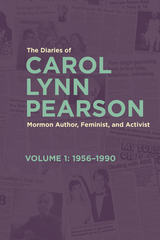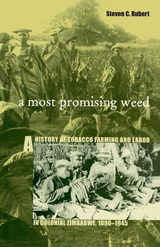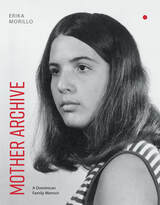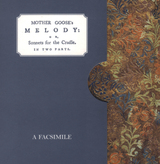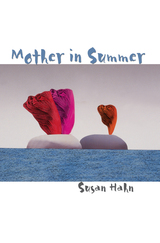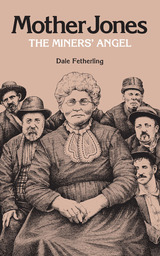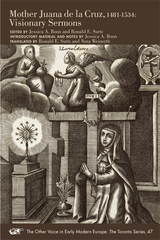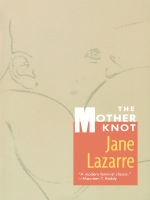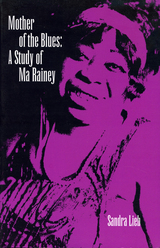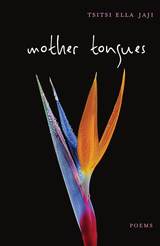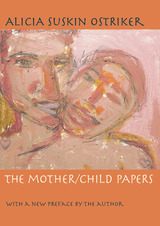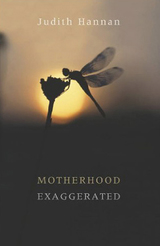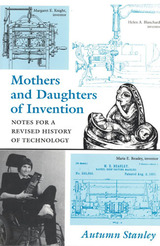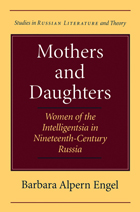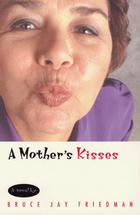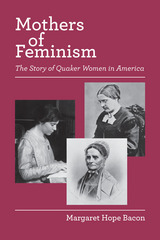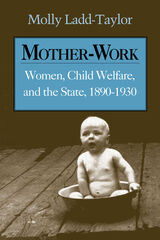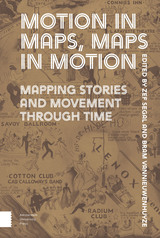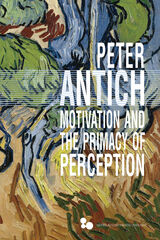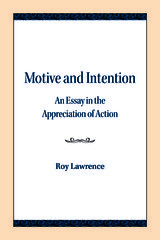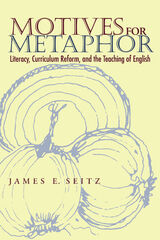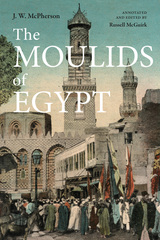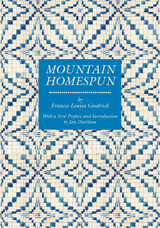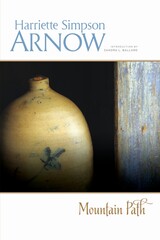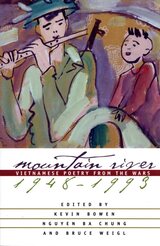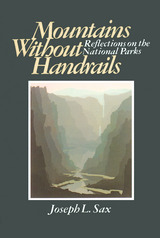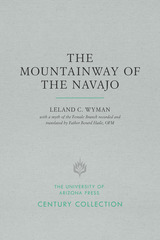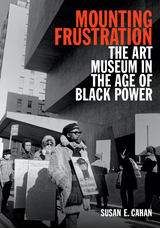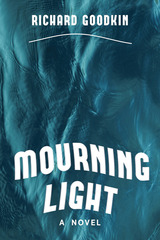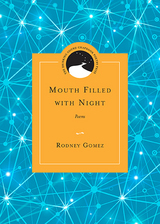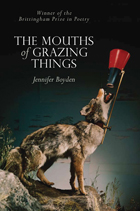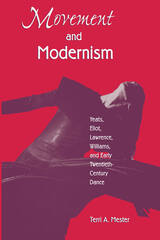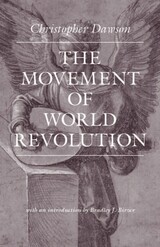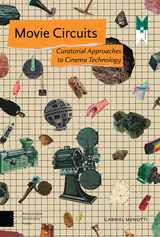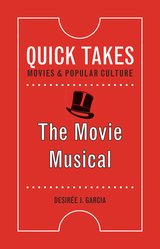A Most Promising Weed: A History of Tobacco Farming and Labor in Colonial Zimbabwe, 1890–1945
Steven C. Rubert
Ohio University Press, 1998 A Most Promising Weed examines the work experience, living conditions, and social relations of thousands of African men, women, and children on European-owned tobacco farms in colonial Zimbabwe from 1890 to 1945. Steven C. Rubert provides evidence that Africans were not passive in their responses to the penetration of European capitalism into Zimbabwe but, on the contrary, helped to shape both the work and living conditions they encountered as they entered wage employment. Beginning with a brief history of tobacco growing in Zimbabwe, this study focuses on the organization of workers’ compounds and on the paid and unpaid labor performed by both women and children on those farms.
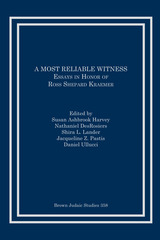 A Most Reliable Witness: Essays in Honor of Ross Shepard Kraemer
Susan Ashbrook Harvey
SBL Press, 2015 Celebrate a trailblazer in the areas of women and re Celebrate a trailblazer in the areas of women and religion, Jews and Judaism, and earliest Christianity in the ancient Mediterranean
Ross Kraemer is Professor Emerita in the Department of Religious Studies at Brown University. This volume of essays, conceived and produced by students, colleagues, and friends bears witness to the breadth of her own scholarly interests. Contributors include Theodore A. Bergren, Debra Bucher, Lynn Cohick, Mary Rose D’Angelo, Nathaniel P. DesRosiers, Robert Doran, Jennifer Eyl, Paula Fredriksen, John G. Gager, Maxine Grossman, Kim Haines-Eitzen, Susan Ashbrook Harvey, Jordan Kraemer, Robert A. Kraft, Shira L. Lander, Amy-Jill Levine, Susan Marks, E. Ann Matter, Renee Levine Melammed, Susan Niditch, Elaine Pagels, Adele Reinhartz, Jordan Rosenblum, Sarah Schwarz, Karen B. Stern, Stanley K. Stowers, Daniel Ullucci, Arthur Urbano, Heidi Wendt, and Benjamin G. Wright.
Features:
- Articles that examine both ancient and modern texts in cross-cultural and trans-historical perspective
- Twenty-eight original essays on ancient Judaism, Christianity, and women in the Greco-Roman world
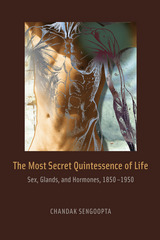 The Most Secret Quintessence of Life: Sex, Glands, and Hormones, 1850-1950
Chandak Sengoopta
University of Chicago Press, 2006 Less than a century ago, physicians, scientists, and cultural commentators became fascinated by the endocrine glands and the effects of their secretions on our bodies and minds. Of all the characteristics supposed to be governed by them, the attributes of sex evoked the wildest interest. The gonads, it was revealed, secreted chemicals that not only influenced the biological expressions of sex, but seemed to generate the vitality and energy that made life worth living.
Through a series of case studies drawn from Central Europe, the United States, and Britain, The Most Secret Quintessence of Life explores how the notion of sex hormones enabled scientists to remap the human body, encouraging hopes that glandular interventions could cure ills, malfunctions, and even social deviance in ways inconceivable to previous generations. Many of these dreams failed, but their history, Chandak Sengoopta shows, takes us into the very heart of scientific medicine, revealing how even its most arcane concerns are shaped by cultural preoccupations and anxieties.
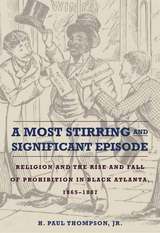 A Most Stirring and Significant Episode: Religion and the Rise and Fall of Prohibition in Black Atlanta, 1865-1887
H. Paul Thompson, Jr.
Northern Illinois University Press, 2012
When Atlanta enacted prohibition in 1885, it was the largest city in the United States to do so. A Most Stirring and Significant Episode examines the rise of temperance sentiment among freed African Americans that made this vote possible—as well as the forces that resulted in its 1887 reversal well before the 18th Amendment to the Constitution created a national prohibition in 1919.
H. Paul Thompson Jr.’s research also sheds light on the profoundly religious nature of African American involvement in the temperance movement. Contrary to the prevalent depiction of that movement as being one predominantly led by white, female activists like Carrie Nation, Thompson reveals here that African Americans were central to the rise of prohibition in the south during the 1880s. As such, A Most Stirring and Significant Episode offers a new take on the proliferation of prohibition and will not only speak to scholars of prohibition in the US and beyond, but also to historians of religion and the African American experience.
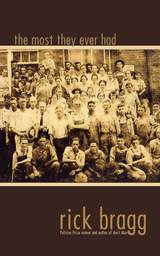 The Most They Ever Had
Rick Bragg
University of Alabama Press, 2011 In the spring of 2001, a community of people in the Appalachian foothills of northern Alabama had come to the edge of all they had ever known. Across the South, padlocks and logging chains bound the doors of silent mills, and it seemed a miracle to blue-collar people in Jacksonville that their mill still bit, shook, and roared. The century-old hardwood floors still trembled under whirling steel, and people worked on, in a mist of white air. The mill had become almost a living thing, rewarding the hardworking and careful with the best payday they ever had, but punishing the careless and clumsy, taking a finger, a hand, more. The mill was here before the automobile, before the flying machine, and the mill workers served it even as it filled their lungs with lint and shortened their lives. In return, it let them live in stiff-necked dignity in the hills of their fathers. So, when death did come, no one had to ship their bodies home on a train. This is a mill story—not of bricks, steel, and cotton, but of the people who suffered it to live.
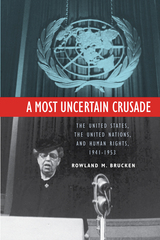 A Most Uncertain Crusade: The United States, the United Nations, and Human Rights, 1941-1953
Rowland Brucken
Northern Illinois University Press, 2013 A Most Uncertain Crusade traces and analyzes the emergence of human rights as both an international concern and as a controversial domestic issue for U.S. policy makers during and after World War II. Historian Brucken focuses on officials in the State Department, at the United Nations, and within certain domestic non-governmental organizations, and explains why, after issuing wartime declarations that called for the definition and enforcement of international human rights standards, the U.S. government refused to ratify the first U.N. treaties that fulfilled those twin purposes. The Truman and Eisenhower administrations worked to weaken the scope and enforcement mechanisms of early human rights agreements, and gradually withdrew support for Senate ratification. A small but influential group of isolationist–oriented senators, led by John Bricker (R-OH), warned that the treaties would bring about socialism, destroy white supremacy, and eviscerate the Bill of Rights. At the U.N., a growing bloc of developing nations demanded the inclusion of economic guarantees, support for decolonization, and strong enforcement measures, all of which Washington opposed.
Prior to World War II, international law considered the protection of individual rights to fall largely under the jurisdiction of national governments. Alarmed by fascist tyranny and guided by a Wilsonian vision of global cooperation in pursuit of human rights, President Roosevelt issued the Four Freedoms and the Atlantic Charter. Behind the scenes, the State Department planners carefully considered how an international organization could best protect those guarantees. Their work paid off at the 1945 San Francisco Conference, which vested the U.N. with an unprecedented opportunity to define and protect the human rights of individuals.
After two years of negotiations, the U.N. General Assembly unanimously approved its first human rights treaty, the Genocide Convention. The U.N. Commission on Human Rights (UNCHR), led by Eleanor Roosevelt, drafted the nonbinding Universal Declaration of Human Rights in 1948. Subsequent efforts to craft an enforceable covenant of individual rights, though, bogged down quickly. A deadlock occurred as western nations, communist states, and developing countries disagreed on the inclusion of economic and social guarantees, the right of self-determination, and plans for implementation.
Meanwhile, a coalition of groups within the United States doubted the wisdom of American accession to any human rights treaties. Led by the American Bar Association and Senator Bricker, opponents proclaimed that ratification would lead to a U.N. led tyrannical world socialistic government. The backlash caused President Eisenhower to withdraw from the covenant drafting process. Brucken shows how the American human rights policy had come full circle: Eisenhower, like Roosevelt, issued statements that merely celebrated western values of freedom and democracy, criticized human rights records of other countries while at the same time postponed efforts to have the U.N. codify and enforce a list of binding rights due in part to America’s own human rights violations.
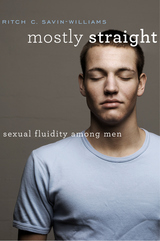 Mostly Straight: Sexual Fluidity among Men
Ritch C. Savin-Williams
Harvard University Press, 2017 Most of us assume that sexuality is fixed: either you’re straight, gay, or bisexual. Yet an increasing number of young men today say that those categories are too rigid. They are, they insist, “mostly straight.” They’re straight, but they feel a slight but enduring romantic or sexual desire for men. To the uninitiated, this may not make sense. How can a man be “mostly” straight? Ritch Savin-Williams introduces us to this new world by bringing us the stories of young men who consider themselves to be mostly straight or sexually fluid. By hearing about their lives, we discover a radically new way of understanding sexual and romantic development that upends what we thought we knew about men.
Today there are more mostly straight young men than there are gay and bisexual young men combined. Based on cutting-edge research, Savin-Williams explores the personal stories of forty young men to help us understand the biological and psychological factors that led them to become mostly straight and the cultural forces that are loosening the sexual bind that many boys and young men experience. These young men tell us how their lives have been influenced by their “drop of gayness,” from their earliest sexual memories and crushes to their sexual behavior as teenagers and their relationships as young adults. Mostly Straight shows us how these young men are forging a new personal identity that confounds both traditional ideas and conventional scientific opinion.
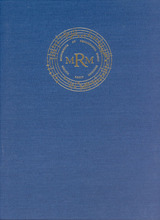 The Motet Books of Andrea Antico
Edited by Martin Picker
University of Chicago Press, 1987 This volume is the latest in a distinguished series of Renaissance editions, Monuments of Renaissance Music, which was founded by Edward E. Lowinsky and is now edited by Howard Mayer Brown. Four of the seven volumes published in the series to date have received the Otto Kinkeldey Award of the American Musicological Society.
Andrea Antico was one of the earliest and most important music publishers. Starting in Rome in 1510 and continuing in Venice, Antico produced elegant books of polyphonic music, cut with incredible skill on wood blocks. The repertory he published is central to understanding sixteenth-century music. It includes, for example, many pieces sung regularly in the Sistine Chapel. Since the best-represented composer in Antico's volumes if Jean Mouton, chapel master to the French king, these motet books provide insights into the character of music both at the Vatican and at the French court at the height of the Renaissance.
Martin Picker provides an exemplary edition of the four volumes of motets published by Antico in the early 1520s. His edition includes, in modern notation, all of the contents of these volumes not previously published in the Medici Codex (Monuments of Renaissance Music, Volumes III-V). Picker prefaces his edition with a history of Antico's publishing career and a discussion of each piece and its sources. The list of concordant sources and the discussions of important variants will be of enormous value to Renaissance scholars.
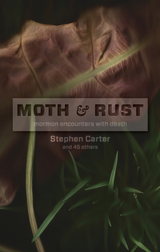 Moth and Rust: Mormon Encounters with Death
Steven Carter
Signature Books, 2017 In Mormonism we are sometimes seemingly casual
about death: it’s a veil or a mission call to the spirit
world. But our actual encounters with the reality of
death inevitably change us in ways that are difficult
to articulate.
In this collection, Mormon writers wrestle with
mortality and its aftermath. A family sings a hesitant
rendition of Happy Birthday to a grief-stricken
mother who buried her toddler just a few hours earlier;
an agnostic son decides he’s Mormon enough to
arrange a funeral for his believing father.
Some essays use death as a means to understand
faith. One author imagines a world where Heavenly
Mother visits her children in the form of their
female ancestors, appearing to her descendants in
times of grief or pain.
Others address practicalities: how do you protect
your children from death while still allowing them
to experience the world; how do you get through
one more nausea-ridden day of cancer treatment?
Still others delve into death’s questions: does the
overwhelming suffering that occurs in the animal
kingdom have a function in the “plan of happiness”?
Sometimes humorous, sometimes heartbreaking,
always thought-provoking, these personal essays,
poems, and stories may never be heard at a Mormon
funeral. But they probably should be.
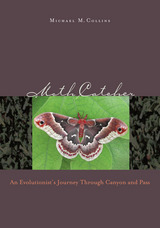 Moth Catcher: An Evolutionist'S Journey Through Canyon And Pass
Michael M. Collins
University of Nevada Press, 2007 The memoir of a scientist and the wild silk moths he studiesBiologist Michael Collins has been studying wild silk moths since he was a boy. This family — which includes the largest and most colorful of the North American moths — led Collins into a long career as a scientist, and has provided him with significant insights into the process by which new species evolve. Moth Catcher is Collins’s engaging account of his development as a scientist and of his groundbreaking research. The canyon and pass environments of the American West offer a setting in which, since the last Ice Age, organisms have adapted to new surroundings and where many have formed new species. Collins has discovered in the Sierra Nevada that geneticists call a “hybrid zone” where two species interbreed. This hybrid zone is unusual because both sexes are fertile, unlike lab-bred hybrids between the same silk moth species. Collins explains how such hybrid populations serve as laboratories in nature where the process of speciation can be observed and studied. This book offers a fascinating view into the work of a field scientist and the ways that evolution continues to operate around us. Collins’s colorful accounts of his fieldwork will delight any reader who loves the outdoors and is captivated by the diversity and interrelations of the life forms found there. And his passion for his research and the fragile, exquisite creatures that he studies will inspire a new appreciation of the wonders of the natural world and the myriad life forms that occupy it.
 Mother Ann Lee: Morning Star of the Shakers
Nardi Reeder Campion
Brandeis University Press, 2026 The definitive biography of Ann Lee, founder of the Shaker movement.
This acclaimed, accessible, and thoroughly researched biography documents the life of Ann Lee, a controversial, religious leader and early feminist figure. Lee established the Shaker movement in 1770 in Manchester, England. The core principles of the Shakers were radical: in an era when wives were the possession of their husband, Lee proclaimed the equality of men and women. The Shakers were dedicated to beliefs in absolute pacifism, equality of the sexes, absolute celibacy, and the cleansing of sin through dancing and chanting to shake away the past.
The Shakers sought inner peace and harmony, but their unusual beliefs, including total abstinence from sex and their exhibitions of mystical ecstasy were considered suspect and led to the imprisonment of Lee and her followers. While jailed, Lee experienced a blinding, soul-splitting vision which reaffirmed her belief in celibacy and named her the second coming of Christ. Seeking religious freedom, she led her followers, known as the United Society of Believers in Christ’s Second Appearing, from England to settle in upstate New York, near Albany.
Mother Ann Lee died in 1784, but her movement continued to grow into the nineteenth century with at least eighteen utopian Shaker communities in Kentucky, Maine, Massachusetts, New Hampshire, New York, and Ohio. Today many of those Shaker settlements are museums. The last remaining Shaker community is at Sabbathday Lake Shaker Village near Poland, Maine.
Mother Archive: A Dominican Family Memoir
Erika Morillo
University of Iowa Press, 2024 2025 OCM Bocas Prize for Caribbean Literature Shortlist, Nonfiction
2024 NBCC Award Finalist, Autobiography
A family murder kept secret, the mysterious disappearance of her father, the systematic erasing of family photographs, a turbulent relationship with her mother, layers of trauma and abuse. In Mother Archive, Erika Morillo reconciles these demons of her past by searching for and seeking out the roots of her family. Intertwining memories with archival family photographs, news clippings, film stills, and artistic images, Morillo revisits her childhood growing up in the Dominican Republic, a place and time riddled with a history of violence and a tradition of erasure.
Spanning three generations across three different countries, this memoir works as a map in which the author traces incidents in her family history to help her understand herself and her own experience as a mother.
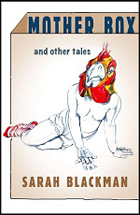 Mother Box and Other Tales
Sarah Blackman
University of Alabama Press, 2013 The eleven stories and one novella of Mother Box, and Other Tales bring together everyday reality and something that is dramatically not in compelling narratives of new possibilities.
In language that is both barb and bauble, bitter and unbearably sweet, Sarah Blackman spins the threads of stories where everything is probable and nothing is constant. The stories in Mother Box, and Other Tales occur in an in-between world of outlandish possibility that has become irrefutable reality: a woman gives birth to seven babies and realizes at one of their weddings that they were foxes all along; a girl with irritating social quirks has been raised literally by cardboard boxes; a young woman throws a dinner party only to have her elaborate dessert upstaged by one of the guests who, as it turns out, is the moon. Love between mothers and children is a puzzling thrum that sounds at the very edge of hearing; a muted pulse that, nevertheless, beats and beats and beats.
In these tales, the prosaic details of everyday life—a half-eaten sandwich, an unopened pack of letters on a table—take on fevered significance as the characters blunder into revelations that occlude even as they unfold.
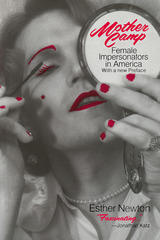 Mother Camp: Female Impersonators in America
Esther Newton
University of Chicago Press, 1979 For two years Ester Newton did field research in the world of drag queens—homosexual men who make a living impersonating women. Newton spent time in the noisy bars, the chaotic dressing rooms, and the cheap apartments and hotels that make up the lives of drag queens, interviewing informants whose trust she had earned and compiling a lively, first-hand ethnographic account of the culture of female impersonators. Mother Camp explores the distinctions that drag queens make among themselves as performers, the various kinds of night clubs and acts they depend on for a living, and the social organization of their work. A major part of the book deals with the symbolic geography of male and female styles, as enacted in the homosexual concept of "drag" (sex role transformation) and "camp," an important humor system cultivated by the drag queens themselves.
"Newton's fascinating book shows how study of the extraordinary can brilliantly illuminate the ordinary—that social-sexual division of personality, appearance, and activity we usually take for granted."—Jonathan Katz, author of Gay American History
"A trenchant statement of the social force and arbitrary nature of gender roles."—Martin S. Weinberg, Contemporary Sociology
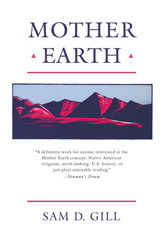 Mother Earth: An American Story
Sam D. Gill
University of Chicago Press, 1987 "The earth is my mother, and on her bosom I shall repose."
Attributed to Tecumseh in the early 1800s, this statement is frequently cited to uphold the view, long and widely proclaimed in scholarly and popular literature, that Mother Earth is an ancient and central Native American figure. In this radical and comprehensive rethinking, Sam D. Gill traces the evolution of female earth imagery in North America from the sixteenth century to the present and reveals how the evolution of the current Mother Earth figure was influenced by prevailing European-American imagery of America and the Indians as well as by the rapidly changing Indian identity.
Gill also analyzes the influential role of scholars in creating and establishing the imagery that underlay the recent origins of Mother Earth and, upon reflection, he raises serious questions about the nature of scholarship.
"Mother Earth might be modern, stressing the supposed biological ground of native life and its rich mythic tradition, but it hardly frees the native people from their long, lamentable involvement with the white man. For making this point clear, Gill deserves high praise."—Bernard W. Sheehan, Journal of the American Academy of Religion
"In one of the finest studies of recent years we have an ambitious attempt to satisfy scholar, Native American, popular reader, and truth."—Thomas McElwain, Western Folklore
 Mother Earth and Uncle Sam: How Pollution and Hollow Government Hurt Our Kids
By Rena I. Steinzor
University of Texas Press, 2007 In this compelling study, Rena Steinzor highlights the ways in which the government, over the past twenty years, has failed to protect children from harm caused by toxic chemicals. She believes these failures—under-funding, excessive and misguided use of cost/benefit analysis, distortion of science, and devolution of regulatory authority—have produced a situation in which harm that could be reduced or eliminated instead persists. Steinzor states that, as a society, we are neglecting our children's health to an extent that we would find unthinkable as individual parents, primarily due to the erosion of the government's role in protecting public health and the environment. At this pace, she asserts, our children will inherit a planet under grave threat. We can arrest these developments if a critical mass of Americans become convinced that these problems are urgent and the solutions are near at hand. By focusing on three specific case studies—mercury contamination through the human food chain, perchlorate (rocket fuel) in drinking water, and the effects of ozone (smog) on children playing outdoors—Steinzor creates an analysis grounded in law, economics, and science to prove her assertions about the existing dysfunctional system. Steinzor then recommends a concise and realistic series of reforms that could reverse these detrimental trends and serve as a blueprint for restoring effective governmental intervention. She argues that these recommendations offer enough material to guide government officials and advocacy groups toward prompt implementation, for the sake of America's—and the world's—future generations.
Mother Father Deaf: Living between Sound and Silence
Paul Preston
Harvard University Press, 1994 “Mother father deaf” is the phrase commonly used within the Deaf community to refer to hearing children of deaf parents. These children grow up between two cultures, the Hearing and the Deaf, forever balancing the worlds of sound and silence. Paul Preston, one of these children, takes us to the place where Deaf and Hearing cultures meet, where families like his own embody the conflicts and resolutions of two often opposing world views.
Based on 150 interviews with adult hearing children of deaf parents throughout the United States, Mother Father Deaf examines the process of assimilation and cultural affiliation among a population whose lives incorporate the paradox of being culturally “Deaf” yet functionally hearing. It is rich in anecdote and analysis, remarkable for its insights into a family life normally closed to outsiders.
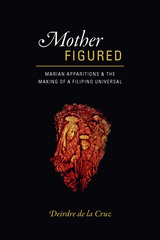 Mother Figured: Marian Apparitions and the Making of a Filipino Universal
Deirdre de la Cruz
University of Chicago Press, 2015 There is no female religious figure so widely known and revered as the Virgin Mary. Mary has inspired in cultures around the world a deep devotion, a desire to emulate her virtue, and a strong belief in her power. Perhaps no population has been so deeply affected by this maternal figure as Filipino Catholics, whose apparitions of Mary have increased in response to recent events, drawing from a broad repertoire of the Catholic supernatural and pulling attention to new articulations of Christianity in the Global South.
In Mother Figured, historical anthropologist Deirdre de la Cruz offers a detailed examination of several appearances and miracles of the Virgin Mary in the Philippines from materials and sites ranging from the mid-nineteenth century to the present. By analyzing the effects of the mass media on the perception and proliferation of apparition phenomena, de la Cruz charts the intriguing emergence of new voices in the Philippines that are broadcasting Marian discourse globally. Based on two years of ethnographic fieldwork and hitherto unexplored archives in the Philippines, the United States, and Spain, Mother Figured documents the conditions of Marian devotion’s modern development and tracks how it has transformed Filipinos’ social and political role within the greater Catholic world.
Mother Goose's Melody
Nigel Tattersfield
Bodleian Library Publishing, 2003 First published in 1780, this was by far the most comprehensive and influential compilation of nursery rhymes. It is here that many of today's favorite rhymes make their first appearance in print, including "Hush-a-by-baby," "Ding dong bell," "High diddle diddle," and "Jack and Gill." Illustrated throughout with 52 delightful wood engravings by Thomas Bewick—long considered the finest of English wood engravers—this facsimile edition is bound in a copy of the gold-flecked Dutch floral paper similar to the original binding and presented in a handsome slipcase.
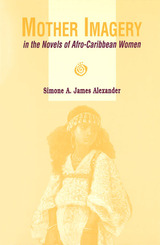 Mother Imagery in the Novels of Afro-Caribbean Women
Simone A. James Alexander
University of Missouri Press, 2000
Focusing on specific texts by Jamaica Kincaid, Maryse Condé, and Paule Marshall, this fascinating study explores the intricate trichotomous relationship between the mother (biological or surrogate), the motherlands Africa and the Caribbean, and the mothercountry represented by England, France, and/or North America. The mother-daughter relationships in the works discussed address the complex, conflicting notions of motherhood that exist within this trichotomy. Although mothering is usually socialized as a welcoming, nurturing notion, Alexander argues that alongside this nurturing notion there exists much conflict. Specifically, she argues that the mother-daughter relationship, plagued with ambivalence, is often further conflicted by colonialism or colonial intervention from the "other," the colonial mothercountry.
Mother Imagery in the Novels of Afro-Caribbean Women offers an overview of Caribbean women's writings from the 1990s, focusing on the personal relationships these three authors have had with their mothers and/or motherlands to highlight links, despite social, cultural, geographical, and political differences, among Afro-Caribbean women and their writings. Alexander traces acts of resistance, which facilitate the (re)writing/righting of the literary canon and the conception of a "newly created genre" and a "womanist" tradition through fictional narratives with autobiographical components.
Exploring the complex and ambiguous mother-daughter relationship, she examines the connection between the mother and the mother's land. In addition, Alexander addresses the ways in which the absence of a mother can send an individual on a desperate quest for selfhood and a home space. This quest forces and forges the creation of an imagined homeland and the re-validation of "old ways and cultures" preserved by the mother. Creating such an imagined homeland enables the individual to acquire "wholeness," which permits a spiritual return to the motherland, Africa via the Caribbean. This spiritual return or homecoming, through the living and practicing of the old culture, makes possible the acceptance and celebration of the mother's land.
Alexander concludes that the mothers created by these authors are the source of diasporic connections and continuities. Writing/righting black women's histories as Kincaid, Condé, and Marshall have done provides a clearing, a space, a mother's land, for black women. Mother Imagery in the Novels of Afro-Caribbean Women will be of great interest to all teachers and students of women's studies, African American studies, Caribbean literature, and diasporic literatures.
Mother in Summer
Susan Hahn
Northwestern University Press, 2002 Mother in Summer is a collection of poems offering candid, powerful insight into the grief of losing a parent.
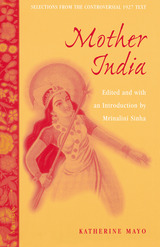 Mother India: Selections from the Controversial 1927 Text, Edited and with an Introduction by Mrinalini Sinha
Katherine Mayo
University of Michigan Press, 2000 Mother India, a polemical attack against Indian self-rule written by U.S. historian Katherine Mayo, was met with a storm of controversy when it was published in 1927. The controversy generated still reverberates and thus is still worth revisiting, some fifty years after Indian independence. In responding to Mayo's argument laid out in Mother India, the leaders of the national movement and the independent women's movement in India laid the foundations of an alliance that gave modern Indian nationalism its distinctive character.
Mrinalini's Sinha's edition provides selections of this controversial book and commentary on the Mother India phenomenon. It also reprints a range of responses from Mayo's contemporaries. Sinha's edition works to locate the book and the controversy it incited in the context of U.S. domestic, British Imperial, and Indian nationalist politics. Unlike previous editions, Sinha's examines the history of cultural feminisms and the relations between women's movements in the United States, Britain, and India; the examination of these different movements reveals intriguing insights into the nature of the varied reactions to Mayo's book. The edition includes several formerly obscure contemporary responses to Mother India from representatives of the women's movement and of the anti-caste movement in India.
Intended as a tool for students and teachers alike, this book will be an important text in the field of women's studies, cultural studies, political science, history, and religion, among others.
Mrinalini Sinha is Associate Professor of History, Southern Illinois University. She is the author of Colonial Masculinity: The 'Manly Englishman' and the 'Effeminate Bengali' in the Late Nineteenth Century.
Mother Jones, The Miners' Angel
Dale Fetherling
Southern Illinois University Press, 1979 For half a century Mother Jones took up the workingman’s cause without question and fought his battles without compromise. Dale Fetherling’s biography for the first time gives her full story, with eloquence and sympathetic understanding.
Mother Juana de la Cruz, 1481–1534: Visionary Sermons
Juana de la Cruz
Iter Press, 2016 Juana de la Cruz (1481–1534) is a unique figure in the history of the Catholic Church, thanks to her public visionary experiences during which she lost consciousness, while a deep voice, identifying itself as Christ, issued from her, narrating the feasts and pageants taking place in heaven. Juana’s so called “sermons,” collected in a manuscript called Libro del Conorte, form a fascinating window into Castilian religiosity in the early sixteenth century. There is much to reap from these sermons concerning Spanish Renaissance culture, theology, mysticism, gender roles, and interreligious interactions.
The Mother Knot
Jane Lazarre
Duke University Press, 1997 In this compelling memoir by a writer, mother, and feminist, Jane Lazarre confronts the myth of the "good mother" with her fiercely honest and intimate portrait of early motherhood as a time of profound ambivalence and upheaval, filled with desperation as well as joy, the struggle to reclaim a sense of self, and sheer physical exhaustion. Originally published in 1976, The Mother Knot is a feminist classic, as relevant today as it was twenty years ago.
Mother of Detective Fiction: The Life and Works of Anna Katharine Green
Patricia D. Maida
University of Wisconsin Press, 1989 When The Leavenworth Case, Anna Katharine Green’s first novel, was published in 1878, it quickly became a bestseller as well as a seminal work of detective fiction. Critics were to perceive Green’s work as the link to Edgar Allan Poe in the American line of classic detective fiction. But the development of serial detectives is perhaps her greatest achievement. (Ebenezer Gryce of the New York Metropolitan Police, who makes his first appearance in 1878, precedes Sherlock Holmes by almost a decade.)
In examining the life and works of Anna Katharine Green, one discovers a slice of American life: in the social events of New York City, in the plight of young working women, in the moral dilemmas of upright citizens pursuing the American dream.
Mother of the Blues: A Study of Ma Rainey
Sandra R. Lieb
University of Massachusetts Press, 1981 We are currently updating our website and have not yet posted complete information for this title. Many of our books are in the Google preview program, which allows readers to view up to 20% of the book. If this title is active in the program, you will find the Google Preview button in the sidebar below.
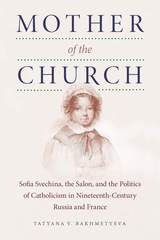 Mother of the Church: Sofia Svechina, the Salon, and the Politics of Catholicism in Nineteenth-Century Russia and France
Tatyana V. Bakhmetyeva
Northern Illinois University Press, 2016 Sofia Petrovna Svechina (1782–1857), better known as Madame Sophie Swetchine, was the hostess of a famous nineteenth-century Parisian salon. A Russian émigré, Svechina moved to France with her husband in 1816. She had recently converted to Roman Catholicism, and the salon she opened acquired a distinctly religious character. It quickly became one of the most popular salons in Paris and was a meeting place for the French intellectual Catholic elite and members of the Liberal Catholic movement.
As a salonniére, Svechina developed close friendships with some of the most noted public figures in the Liberal Catholic movement. Her involvement with her guests went deeper than the typical salonniére’s. She was a mentor, spiritual counselor, and intellectual advisor to many distinguished Parisian men and women, and her influence extended beyond the walls of her salon into the public world of politics and ideas.
In this fascinating biography, Tatyana Bakhmetyeva seeks to understand the creative process that informed Svechina’s life and examines her subject in the context of nineteenth-century thought and letters. It will appeal to educated readers interested in European and Russian history, the history of Catholicism, and women’s history.
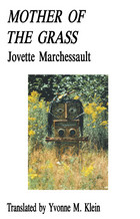 Mother of the Grass
Jovette Marchessault
Talon Books, 1989 Born at the end of the first volume in this autobiographical trilogy, the little Jovette sets off on her journey across the Land of Permanent Sacrifice in Mother of the Grass. Wrenched from her childhood paradise on the banks of the St. Lawrence, she is plunged into the child-battering hell of working-class Montreal, then later into the despairing din of the factories where she worked as a teenager. Her spirit continues to yearn for the light and peace of her childhood by the riverside and this book chronicles her extraordinary journey through the artists’ cafes and gay bars, the bookstores, and the streets of Montreal in the 1950s and ’60s, sustained always by the memory of her grandmother, toward a place by the river where she can write and be. Mother of the Grass is at once a brutal portrait of a world dedicated to violence against women and children and a remarkable visionary account of the growth of a major Quebec feminist artist’s creative self.
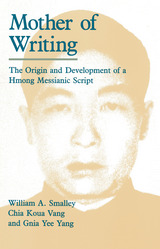 Mother of Writing: The Origin and Development of a Hmong Messianic Script
William A. Smalley, Chia Koua Vang, and Gnia Yee Yang
University of Chicago Press, 1990 In February of 1971, in the Laotian village of Nam Chia, a forty-one year old farmer named Shong Lue Yang was assassinated by government soldiers. Shong Lue claimed to have been descended of God and given the mission of delivering the first true Hmong alphabet. Many believed him to be the Hmong people's long-awaited messiah, and his thousands of followers knew him as "Mother (Source) of Writing."
An anthropological linguist who has worked among the Hmong, William A. Smalley joins Shong Lue's chief disciple, Chia Koua Vang, and one of his associates, to tell the fascinating story of how the previously unschooled farmer developed his remarkable writing system through four stages of increasing sophistication. The uniqueness of Shong Lue's achievement is highlighted by a comparison of Shong Lue's writing system to other known Hmong systems and to the history of writing as a whole.
In addition to a nontechnical linguistic analysis of the script and a survey of its current use, Mother of Writing provides an intriguing cultural account of Shong Lue's life. The book traces the twenty-year-long struggle to disseminate the script after Shong Lue's death, first by handwriting, then by primitive moveable type, an abortive attempt to design a wooden typewriter, and finally by modern wordprocessing. In a moving concluding chapter, Smalley discusses his own complex feelings about his coauthors' story.
 Mother Teresa: Just a Pencil In God's Hand: Reflections in Honor of a Saint
Brian Kolodiejchuk
Catholic University of America Press, 2024 This anthology contains a collection of intellectual explorations honoring the enduring legacy of Mother Teresa. The symposium, held on 10 September 2022 at the Catholic University of America (CUA), brought together leading scholars to speak of Mother Teresa's legacy to produce the following papers, each shedding light on a life characterized by compassion, selflessness, and devoted service to the poorest of the poor, the forgotten, and the outcast of society.
The keynote address by George Weigel, “Mother Teresa and John Paul II: Lessons for Our Troubled Times,” uncovers the lessons from the partnership of two great saints and their efforts to make way for Love in a dark world. "Mother Teresa: Holiness, Process of Canonization, and Miracle;" by the postulator of her cause, Fr. Brian Kolodiejchuk, MC, explores the nature of holiness, several characteristics of Mother Teresa’s holiness and the process that led to her canonization in 2016. In “Praxiological Approach to the Poor: Mother Teresa’s authentic retrieval of Christian praxis through faith, hope, and charity,” presented by Fr Darren Dentino, MC, we delve into Mother Teresa’s profound relationship with the underprivileged, showcasing a service approach that transcends simple social work and touches and heals the physical and inner wounds of many.
Janice Breidenbach, a professor at Ave Maria University, sheds light on her own experience as a mother and explains Mother Teresa’s deep understanding of motherhood in her paper “Mother Teresa’s Philosophy of Motherhood.” "Mother Teresa: A Carmelite Perspective" by CUA professor, Fr Stephen Payne, OCD, explores the connections between Mother Teresa and the Carmelite tradition, highlighting the influence of Carmelite spirituality on her life and journey. Jim Towey's paper delves into Mother Teresa's motherhood and her humanity, emphasizing how her ordinary yet profound acts of love and compassion were reflective of her saintly character.
In the annual conference held the following year, Catholic University of America professor Bradley Gregory, examines the phrase “you did it to me” from the judgment scene in the gospel of Matthew (25:40) which Mother Teresa would refer to as “the gospel on five fingers.” Drawing on the rich theological resources of Scripture and the Church’s tradition, Professor Bradley expounds on how this passage relates to the gospel of grace, which calls us into God’s work of redeeming and healing the world.
Each paper testifies to Mother Teresa’s enduring legacy as a reflection of God’s love in the world, providing readers an opportunity to contemplate her steadfast dedication and honor the legacy of one of the 20th century's most profound figures.
 Mother Teresa's General Letters to Her Sisters
Brian Kolodiejchuk
Catholic University of America Press, 2024 Mother Teresa’s General Letters to Her Sisters is a collection of Mother Teresa’s circular letters to the members of her religious congregation, the Missionaries of Charity Sisters. Not intended for those outside her community, they were written informally and spontaneously, often with little editing. It was for Mother Teresa a way of “being present” to the members of her rapidly expanding religious order. Seemingly of little interest except for those to whom they were addressed, the letters reveal the spiritual depth and pragmatic leadership of one of the most popular modern saints, as well as the inner dynamics underlying one of the most flourishing religious congregations of the last century. At the same time, and perhaps surprisingly, these letters may also prove to be worthwhile reading for a wider audience.
Something of God’s wisdom and love seems to shine through Mother Teresa’s guidance and counsels, giving the reader light and help even though he or she is not living the same religious life as one of the Sisters. Mother Teresa’s unpolished statements are at times humble and at times humbling. They inspire confidence and encourage generosity. Many a time they are humorous but more often challenging. They are sprinkled with serene joy but also permeated with deep pain. She delighted in her Sisters’ accomplishments yet did not shy away from correcting even the smallest flaw, which didn’t escape her very observant eye. Sometimes she sounded just like a mother, full of tender loving care, and at other times more like a commander in chief, exhibiting an iron will and uncompromising determination. In either case, her followers seemed to have been drawn into the mystery of her charism, endeavoring to keep pace with her. Was it the attraction of what could be termed as her “leadership style” in the unremitting service of the poorest of the poor, or the perceived love of a mother’s heart that made her so unanimously loved and admired by the members of her congregation? Or was it both? The letters will reveal the answer!
Inspiring in their simplicity, the letters may well serve as a treasure trove where anyone from a reflective scholar to a caring mother of a family may find satisfaction for their spiritual palate. The attractiveness of perennial truth often makes Mother Teresa’s presentation of traditional spiritual themes likewise relevant for contemporary needs. In the context of Mother Teresa’s statement that “we are created for greater things, to love and to be loved’,” these letters will help the reader discover and experience God’s presence through the little miracles of His love in one’s daily life. They will inspire us “to put our love into living action,” sharing His love with all those we meet, and so make our lives “something beautiful for God.”
 Mother Tongues of the High Andes: Gender, Language, and Indigenous Difference in Peru
Sandhya Krittika Narayanan
University of Arizona Press, 2025 The Peruvian altiplano, a high plateau around Lake Titicaca, is known for its breathtaking landscapes and the cultivation of commodities like quinoa and alpaca wool. The region also stands out for its history of inter-Indigenous language contact and multilingualism between Quechua- and Aymara-speaking communities. This linguistic ecology predates the Spanish conquest and persists today, making the altiplano, with its capital, Puno, a unique space where Indigenous multiplicity is recognized and celebrated. Yet this celebration is accompanied by additional ideological challenges around defining Quechua and Aymara as distinct Indigenous languages and ethnic groups.
Anthropologist Sandhya Krittika Narayanan begins with these challenges, and asks: What does it mean to be a Quechua or Aymara speaker in Puno today? What does it mean to be an Indigenous ethnic Quechua or Aymara individual?
Mother Tongues of the High Andes opens with these questions, exploring what Quechua and Aymara languages and identities mean for Indigenous puneños as they navigate their past and present. Narayanan argues that understanding inter-Indigenous linguistic and social differences involves examining Indigenous gender roles, responsibilities, and linguistic practices, particularly those of Indigenous puneña women. She shows how these practices have contributed to the maintenance of Indigenous multilingualism and continuity in local modes of understanding Indigenous identity and difference.
Even as ideologies around Indigenous identity and linguistic practices shift due to global discourses on Indigenous ethnic identity and nationalism, Indigenous women continue to play a crucial role, promoting new ways to speak and think about Quechua and Aymara linguistic differences, making the Indigenous roots and histories of Puno recognizable to a global audience. Through a comprehensive ethnographic exploration of gender, language, and Indigenous difference, Narayanan shows how the linguistic and social practices of Indigenous puneña women both contest and reaffirm competing visions of Quechua and Aymara linguistic identity and authority.
Mother Tongues: Poems
Tsitsi Ella Jaji
Northwestern University Press, 2019 Winner of the 2018 Cave Canem Northwestern University Press Poetry Prize
Tsitsi Ella Jaji’s second full-length collection of poems, Mother Tongues, begins at home, with the first words and loves we learn, and the most intimate vows we swear. How deep does your language go back? Jaji’s artful verse is a three-tiered gourd of sustenance, vessel, and folklore. The tongues speak the beginnings and the present; they capture and claim the losses, the ironies, and a poet’s human evolution. Mother Tongues is a collection of language unto itself that translates directly to the heart.
 Mother Tongues: Sexuality, Trials, Motherhood, Translation
Barbara Johnson
Harvard University Press, 2003 Charles Baudelaire, Walter Benjamin, and Sylvia Plath make up the odd trio on which this book is based. It is in the surprising and revealing links between them--links pertaining to troublesome mothers, elusive foreign languages, and professional disappointments--that Barbara Johnson maps the coordinates of her larger claims about the ideal of oneness in every area of life, and about the damage done by this ideal.
The existence of sexual difference precludes an original or ultimate "one" who would represent all of mankind; the plurality of languages makes it impossible to think that one doesn't live in translation; and the plurality of the sexes means that every human being came from a woman's body, and some will reproduce this feat, while others won't. In her most personal and deeply considered book about difference, Johnson asks: Is the mother the guardian of a oneness we have never had? The relations that link mothers, bodies, words, and laws serve as the guiding puzzles as she searches for an answer.
The Mother/Child Papers: With a new preface by the author
Alicia Ostriker
University of Pittsburgh Press, 2009 In 1970, as the war in Vietnam was heating up, Ostriker was awaiting the birth of her son. On April 30, President Nixon announced the bombing of Cambodia. On May 14, four students were shot and killed by National Guardsmen at Kent State University. The poems in this collection confront Ostriker’s personal tumult as she considered the world she had brought her son into.
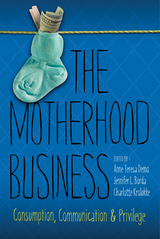 The Motherhood Business: Consumption, Communication, and Privilege
Edited by Anne Teresa Demo, Jennifer L. Borda, and Charlotte Kroløkke
University of Alabama Press, 2015 The Motherhood Business is a piercing collection of ten original essays that reveal the rhetoric of the motherhood industry. Focusing on the consumer life of mothers and the emerging entrepreneurship associated with motherhood, the collection considers how different forms of privilege (class, race, and nationality) inform discourses about mothering, consumption, mobility, and leisure.
The Motherhood Business follows the harried mother’s path into the anxious maelstrom of intelligent toys, healthy foods and meals, and educational choices. It also traces how some enterprising mothers leverage cultural capital and rhetorical vision to create thriving baby- and child-based businesses of their own, as evidenced by the rise of mommy bloggers and “mompreneurs”over the last decade.
Starting with the rapidly expanding global fertility market, The Motherhood Business explores the intersection of motherhood, consumption, and privilege in the context of fertility tourism, international adoption, and transnational surrogacy. The synergy between motherhood and the marketplace demonstrated across the essays affirms the stronghold of “intensive mothering ideology” in decisions over what mothers buy and how they brand their businesses even as that ideology evolves. Across diverse contexts, the volume also identifies how different forms or privilege shape how mothers construct their identities through their consumption and entrepreneurship.
Although social observers have long commented on the link between motherhood and consumerism, little has been written within the field of rhetoric. Penetrating and interdisciplinary, The Motherhood Business illuminates how consumer culture not only shapes contemporary motherhood but also changes in response to mothers who constitute a driving force of the economy.
Motherhood Exaggerated
Judith Hannan
CavanKerry Press, 2012 In the past, the few memoirs about children battling cancer dealt mostly with death and grief. This passionate retelling by a survivor’s mother is about the struggle to help shepherd her child out of illness, towards health and through survival. Now that more children survive cancer, this passionate retelling by the survivor’s mother is required reading; the struggle of helping move the child out of illness.
 Motherhood in Bondage: Foreword by Margaret Marsh
Margaret Sanger
Ohio State University Press, 2000 Margaret Sanger (1879–1966) was a leading figure in the American birth control movement. Trained as a nurse, she moved to New York City to work among the poor. Having witnessed firsthand the travails of mothers in the city's poorest neighborhoods, she felt the need to provide them with information on reproduction and contraception. She abandoned her nursing career and devoted the rest of her life to disseminating information on women's reproduction and contraception, publishing books and articles and founding birth control clinics.
In Motherhood in Bondage, first published in 1928, Sanger reproduced letters written to her from women and sometimes men from all over the country, in both urban and rural areas, who were seeking advice on reproductive matters and marital relations, but mostly imploring her to help them find ways to avoid more pregnancies. The letters are grouped by theme into sixteen chapters, and Sanger wrote an introduction to each chapter. With clear relevance to the current post-Roe moment, these pleas to Sanger for advice on avoiding unwanted pregnancy dramatically detail the desperation for reproductive agency when birth control was unknown, withheld, or otherwise inaccessible.
In her foreword for this edition, Margaret Marsh describes the controversies surrounding these letters and places them in their historical context.
Mothering
Rudolph Schaffer
Harvard University Press Anyone interested in the drama of development or the excitement of the mother-infant relationship will want to own this book. Since Schaffer sees the child not as a psychologically passive “blob” waiting to be molded, he examines the child’s own internative patterns and targets difficulties between the child-mother relationship.
 Mothering Across Cultures: Postcolonial Representations
Angelita Reyes
University of Minnesota Press, 2001 A multifaceted exploration of memory, mothering, literature, and postcoloniality. Blending the personal and the historical, the practical and the theoretical, Angelita Reyes draws on a wide range of texts from Africa and the African diaspora to establish mothering as a paradigm of progressive feminisms. Reyes creates a comparative dialogue among the fictions of five postcolonial women writers: Toni Morrison, Paule Marshall, Simone Schwarz-Bart, Jean Rhys, and Mariama Bâ. Reyes discusses the theme of mothering as a human reality, as a paradigm for cultural crossings, and as what she refers to as autobiographical memory-telling. Not only does her work explore the fraught relationships among memory, history, and mothering, but it also questions conventional ways of approaching the often fragmented testimony and artifacts of the lives of women of African descent. Finally, Reyes uses memory-telling to present the autobiography of her own mother, whose extended American family said she "married a Spanish Negro who don’t speak good English." Her blending of authorial, critical, historical, and autobiographical voices in this work extends our understanding of the cross-cultural ideas of mothering.
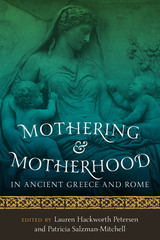 Mothering and Motherhood in Ancient Greece and Rome
Edited by Lauren Hackworth Petersen and Patricia Salzman-Mitchell
University of Texas Press, 2012 Motherhood played a central role in ancient Greece and Rome, despite the virtual absence of female participation in the public spheres of life. Mothers could wield enormous influence as the reproductive bodies of society and, in many cases, of culture. Yet motherhood and acts of mothering have received relatively little focused and sustained attention by modern scholars, who have concentrated almost exclusively on analyzing depictions of ancient women more generally. In this volume, experts from across the humanities present a wealth of evidence from legal, literary, and medical texts, as well as art, architecture, ritual, and material culture, to reveal the multilayered dimensions of motherhood in both Greece and Rome and to confront the fact that not all mothers and acts of mothering can be easily categorized. The authors consider a variety of mothers—from the mythical to the real, from empress to prostitute, and from citizen to foreigner—to expose both the mundane and the ideologically charged lives of mothers in the Classical world. Some essays focus on motherhood as a largely private (emotional, intimate) experience, while others explore the ramifications of public, oftentimes politicized, displays of motherhood. This state-of-the art look at mothers and mothering in the ancient world also takes on a contemporary relevance as the authors join current debates on motherhood and suggest links between the lives of ancient mothers and the diverse, often conflicting roles of women in modern Western society.
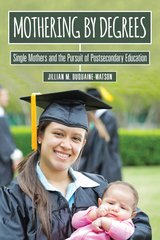 Mothering by Degrees: Single Mothers and the Pursuit of Postsecondary Education
Duquaine-Watson, Jillian M.
Rutgers University Press, 2017 Winner of the 2018 AERA Division J Outstanding Publication Award
In Mothering by Degrees, Jillian Duquaine-Watson shows how single mothers pursuing college degrees must navigate a difficult course as they attempt to reconcile their identities as single moms, college students, and in many cases, employees. They also negotiate a balance between what they think a good mother should be, and what society is telling them, and how that affects their choices to go to college, and whether to stay in college or not.
The first book length study to focus on the lives and experiences of single mothers who are college students, Mothering by Degrees points out how these women are influenced by dominant American ideologies of motherhood, and the institutional parameters of the schools they attend, and argues for increased attention to the specific ways in which the choices, challenges, and opportunities available to mothers are shaped within their specific environments, as well as the ways in which mothers help shape those environments...
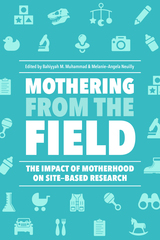 Mothering from the Field: The Impact of Motherhood on Site-Based Research
Edited by Bahiyyah Miallah Muhammad and Mélanie-Angela Neuilly
Rutgers University Press, 2019 The heated national conversation about gender equality and women in the workforce is something that women in academia have been concerned with and writing about for at least a decade. Overall, the conversation has focused on identifying how women in general and mothers in particular fair in the academy as a whole, as well as offering tips on how to maximize success. Aside from a long-standing field-specific debate in anthropology, rare are the volumes focusing on the particulars of motherhood’s impacts on how scientific research is conducted, particularly when it comes to field research.
Mothering from the Field offers both a mosaic of perspectives from current women scientists’ experiences of conducting field research across a variety of sub-disciplines while raising children, and an analytical framework to understand how we can redefine methodological and theoretical contributions based on mothers’ experiences in order not just to promote healthier, more inclusive, nurturing, and supportive environments in physical, life, and social sciences, but also to revolutionize how we conceptualize research.
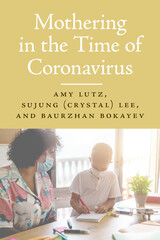 Mothering in the Time of Coronavirus
Amy Lutz, Sujung (Crystal) Lee, and Baurzhan Bokayev
University of Massachusetts Press, 2025 When stay-at-home orders during the COVID-19 pandemic erased the division between home and school, many parents in the United States were suddenly expected to become their children’s teachers. Despite this new arrangement, older gender norms largely remained in place, and these extra child rearing responsibilities fell disproportionately on mothers. Mothering in the Time of Coronavirus explores how they juggled working, supervising at-home learning, and protecting their children’s emotional and physical health during the outbreak.
Focusing on both remote and essential workers in central New York, Amy Lutz, Sujung (Crystal) Lee, and Baurzhan Bokayev argue that the pandemic transformed an already intensive style of contemporary American child rearing, in which mothers are expected to be constantly available to meet their children’s needs even when they are working outside the home, into extremely intensive mothering. The authors investigate the consequences of this shift, and how it is influenced by issues such as class and race. They also bring attention to how and why current public policies are not conducive to the de-intensification of motherhood. Locating their study within larger intersections of gender, family, and education, they contend that to fully appreciate the broader social consequences of COVID-19, we must understand the experiences of mothers.
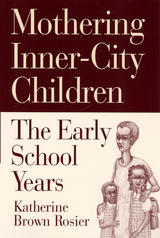 Mothering Inner-City Children: The Early School Years
Katherine Brown Rosier
Rutgers University Press, 2000 There are few groups more stereotyped and demonized than "welfare mothers," particularly low-income, African American women raising children in the inner city. But what are the day-to-day stories behind the stereotypes? How do African American mothers (both single women and those living with a partner) in poor families handle their roles as parents? What support networks do they rely on to help raise their children? How do their personal histories affect their parenting styles? Sociologist Katherine Brown Rosier spent three years interviewing and observing Indianapolis mothers as their children made the transition from a Head Start program to kindergarten and through second grade, analyzing the families in their homes, schools, and other social settings. She brings forth the voices of the mothers, children, and their teachers, providing a multifaceted picture of how low-income African American families cope with the daily pressures and responsibilities of child rearing. Rosier also examines how larger socio-economic factors influence these families' specific circumstances and histories. What child-rearing strategies do these mothers employ, she asks, to promote a smooth transition into school despite complex discontinuities among their homes, schools, and communities? How are these strategies viewed and supported or impeded by teachers, family, friends, and neighbors? Until now, most research on poor African American families has focused so intently on the problems confronted by this seemingly homogenous group that the routine practices of every day life have been ignored. In this unique project, Rosier allows the families' individual experiences and thoughts to contribute to and complicate current research.
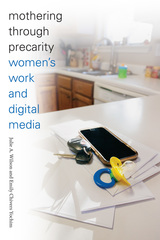 Mothering through Precarity: Women's Work and Digital Media
Julie A. Wilson and Emily Chivers Yochim
Duke University Press, 2017 In Mothering through Precarity Julie A. Wilson and Emily Chivers Yochim explore how working- and middle-class mothers negotiate the difficulties of twenty-first-century mothering through their everyday engagement with digital media. From Facebook and Pinterest to couponing, health, and parenting websites, the women Wilson and Yochim study rely upon online resources and communities for material and emotional support. Feeling responsible for their family's economic security, these women often become "mamapreneurs," running side businesses out of their homes. They also feel the need to provide for their family's happiness, making successful mothering dependent upon economic and emotional labor. Questioning these standards of motherhood, Wilson and Yochim demonstrate that mothers' work is inseparable from digital media as it provides them the means for sustaining their families through such difficulties as health scares, underfunded schools, a weakening social safety net, and job losses.
 Mothering Without A Compass: White Mother’s Love, Black Son’s Courage
Becky Thompson
University of Minnesota Press, 2000 A lively meditation on creating a multiracial family. In 1997, Becky Thompson began parenting nine-year-old Adrian at the request of his mother, and her life changed forever. Mothering without a Compass is the moving story of her first year as the white lesbian "sudden-mother" of an African American boy. From the everyday yet sometimes overwhelming tasks of finding Adrian a school and debating the significance of action figures, to unexpected discussions about who pays whom at the sperm bank, to the more complicated matters of racism, sexuality, nontraditional families, open adoption, love, and loss, Thompson gives us an absorbing and often humorous account of her attempt at antiracist, multicultural parenting. Mothering without a Compass highlights a range of issues and experiences: Thompson’s desire to be a good mother while holding on to her sense of self; her growing, detailed knowledge of the ways in which racism affects people’s feelings about themselves and the world around them; her increasing appreciation of the inner life of a child; her realization that mothering forces her to confront her own vulnerabilities and past losses. The book opens with Adrian’s arrival and ends with a visit from Adrian’s biological mother, during which she and Thompson search for ways to respect each other as parents across racial, religious, and cultural divides. Mothering without a Compass relates a lesbian parent’s struggle to help her child grow up and describes the complexities facing children who have more than one family. This candid, personal story shows that it is through everyday life that questions about race, class, gender, and sexuality are often played out. It is a necessary book for all parents-for anyone concerned with the challenge of raising justice-minded children in a complicated world.
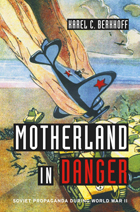 Motherland in Danger: Soviet Propaganda during World War II
Karel C. Berkhoff
Harvard University Press, 2012 Much of the story about the Soviet Union’s victory over Nazi Germany has yet to be told. In Motherland in Danger, Karel Berkhoff addresses one of the most neglected questions facing historians of the Second World War: how did the Soviet leadership sell the campaign against the Germans to the people on the home front?
For Stalin, the obstacles were manifold. Repelling the German invasion would require a mobilization so large that it would test the limits of the Soviet state. Could the USSR marshal the manpower necessary to face the threat? How could the authorities overcome inadequate infrastructure and supplies? Might Stalin’s regime fail to survive a sustained conflict with the Germans?
Motherland in Danger takes us inside the Stalinist state to witness, from up close, its propaganda machine. Using sources in many languages, including memoirs and documents of the Soviet censor, Berkhoff explores how the Soviet media reflected—and distorted—every aspect of the war, from the successes and blunders on the front lines to the institution of forced labor on farm fields and factory floors. He also details the media’s handling of Nazi atrocities and the Holocaust, as well as its stinting treatment of the Allies, particularly the United States, the UK, and Poland. Berkhoff demonstrates not only that propaganda was critical to the Soviet war effort but also that it has colored perceptions of the war to the present day, both inside and outside of Russia.
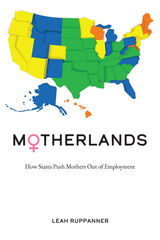 Motherlands: How States Push Mothers Out of Employment
Leah Ruppanner
Temple University Press, 2020 In the absence of federal legislation, each state in the United States has its own policies regarding family leave, job protection for women and childcare. No wonder working mothers encounter such a significant disparity when it comes to childcare resources in America! Whereas conservative states like Nebraska offer affordable, readily available, and high quality childcare, progressive states that advocate for women’s economic and political power, like California, have expensive childcare, shorter school days, and mothers who are more likely to work part-time or drop out of the labor market altogether to be available for their children. In Motherlands, Leah Ruppanner cogently argues that states should look to each other to fill their policy voids. She provides suggestions and solutions for policy makers interested in supporting working families. Whether a woman lives in a state with stronger childcare or gender empowerment regimes, at stake is mothers’ financial dependence on their partners. Ruppanner advocates for reducing the institutional barriers mothers face when re-entering the workforce. As a result, women would have greater autonomy in making employment decisions following childbirth.
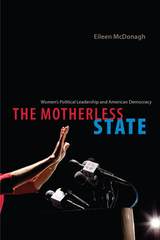 The Motherless State: Women's Political Leadership and American Democracy
Eileen McDonagh
University of Chicago Press, 2009 American women attain more professional success than most of their counterparts around the world, but they lag surprisingly far behind in the national political arena. Women held only 15 percent of U.S. congressional seats in 2006, a proportion that ranks America behind eighty-two other countries in terms of females elected to legislative office. A compelling exploration of this deficiency, TheMotherless State reveals why the United States differs from comparable democracies that routinely elect far more women to their national governing bodies and chief executive positions.
Explaining that equal rights alone do not ensure equal access to political office, Eileen McDonagh shows that electoral gender parity also requires public policies that represent maternal traits. Most other democracies, she demonstrates, view women as more suited to govern because their governments have taken on maternal roles through social welfare provisions, gender quotas, or the continuance of symbolic hereditary monarchies. The United States has not adopted such policies, and until it does, McDonagh insightfully warns, American women run for office with a troubling disadvantage.
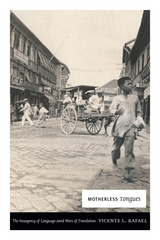 Motherless Tongues: The Insurgency of Language amid Wars of Translation
Vicente L. Rafael
Duke University Press, 2016 In Motherless Tongues, Vicente L. Rafael examines the vexed relationship between language and history gleaned from the workings of translation in the Philippines, the United States, and beyond. Moving across a range of colonial and postcolonial settings, he demonstrates translation's agency in the making and understanding of events. These include nationalist efforts to vernacularize politics, U.S. projects to weaponize languages in wartime, and autobiographical attempts by area studies scholars to translate the otherness of their lives amid the Cold War. In all cases, translation is at war with itself, generating divergent effects. It deploys as well as distorts American English in counterinsurgency and colonial education, for example, just as it re-articulates European notions of sovereignty among Filipino revolutionaries in the nineteenth century and spurs the circulation of text messages in a civilian-driven coup in the twenty-first. Along the way, Rafael delineates the untranslatable that inheres in every act of translation, asking about the politics and ethics of uneven linguistic and semiotic exchanges. Mapping those moments where translation and historical imagination give rise to one another, Motherless Tongues shows how translation, in unleashing the insurgency of language, simultaneously sustains and subverts regimes of knowledge and relations of power.
Motherlunge
Kirstin Scott
New Issues Poetry and Prose, 2013
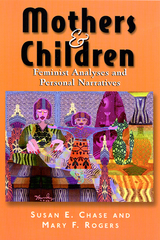 Mothers and Children: Feminist Analyses and Personal Narratives
Edited by Susan E Chase and Mary F. Rogers
Rutgers University Press, 2001 This feminist exploration of mothers, mothering, and motherhood combines evaluations of empirical and theoretical work with personal narratives by mothers or caregivers. While the authors' analyses yield suggestions for new approaches to motherhood, the narratives vividly demonstrate the relevance of these issues to women's lives. The result is a nuanced picture of the complex realities mothers face, as well as their struggles, joys, and hopes for their children. In the book's first part, "Social Constructions of Motherhood," Chase and Rogers argue that dominant western views of motherhood have been and continue to be detrimental to most mothers and children. In the second part, "Maternal Bodies," the authors attend to the ways that American society and women themselves have regarded the physical aspects of motherhood. Mothers' bodies, the authors contend, have long been objects of cultural and political struggle. The final part, "Mothering in Everyday Life," suggests that only an understanding of the daily realities of mothering will lead to social and political changes promoting the welfare of mothers and children.
Mothers and Daughters of Invention: Notes for a Revised History of Technology
Stanley, Autumn
Rutgers University Press, 1995 Written in an engaging and accessible style, this first broadly focused compensatory history of technology not only includes women's contributions but begins the long-overdue task of redefining technology and significant technology and to value these contributions correctly. Stanley traces women's inventions in five vital areas of technology worldwide--agriculture, medicine, reproduction, machines, and computers--from prehistory (or origin) forward, profiling hundreds of women, both famous and obscure. The author does not ignore theory. She contributes a paradigm for male takeovers of technologies originated by women.
Mothers and Daughters: Women of the Intelligentsia in Nineteenth-Century Russia
Barbara Alpern Engel
Northwestern University Press, 2000 The first psychosocial study of the female intelligentsia in Russia, Mothers and Daughters explains how and why women radicals of the nineteenth century diverged from their male counterparts, describes the forces that led women to rebel, and discusses their legacy to future generations. Throughout, Engel brings nineteenth-century women to life, humanizing history as she presents a case study of how the personal became political in a time and place different from our own.
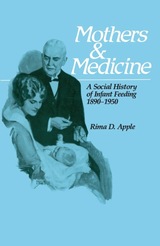 Mothers and Medicine: A Social History of Infant Feeding, 1890–1950
Rima D. Apple
University of Wisconsin Press, 1987 In the nineteenth century, infants were commonly breast-fed; by the middle of the twentieth century, women typically bottle-fed their babies on the advice of their doctors. In this book, Rima D. Apple discloses and analyzes the complex interactions of science, medicine, economics, and culture that underlie this dramatic shift in infant-care practices and women’s lives.
As infant feeding became the keystone of the emerging specialty of pediatrics in the twentieth century, the manufacture of infant food became a lucrative industry. More and more mothers reported difficulty in nursing their babies. While physicians were establishing themselves and the scientific experts and the infant-food industry was hawking the scientific bases of their products, women embraced “scientific motherhood,” believing that science could shape child care practices. The commercialization and medicalization of infant care established an environment that made bottle feeding not only less feared by many mothers, but indeed “natural” and “necessary.” Focusing on the history of infant feeding, this book clarifies the major elements involved in the complex and sometimes contradictory interaction between women and the medical profession, revealing much about the changing roles of mothers and physicians in American society.
“The strength of Apple’s book is her ability to indicate how the mutual interests of mothers, doctors, and manufacturers led to the transformation of infant feeding. . . . Historians of science will be impressed with the way she probes the connections between the medical profession and the manufacturers and with her ability to demonstrate how medical theories were translated into medical practice.”—Janet Golden, Isis
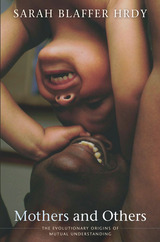 Mothers and Others: The Evolutionary Origins of Mutual Understanding
Sarah Blaffer Hrdy
Harvard University Press, 2009 “A brilliant work on a profoundly important subject. The leading scientific authority on motherhood has come through again.” —E. O. Wilson
“Thought provoking…An engaging and compelling argument [that] requires us to rethink entrenched views about how we came to be human.” —Science
Somewhere in Africa, more than a million years ago, a line of apes began to rear their young differently than their Great Ape ancestors. From this new form of care came new ways of engaging and understanding each other. How such singular human capacities evolved, and how they have kept us alive for thousands of generations, is the mystery revealed in this bold and wide-ranging new vision of human emotional evolution.
Mothers and Others finds the key in the primatologically unique length of human childhood. If the young were to survive in a world of scarce food, they needed to be cared for, not only by their mothers but also by siblings, aunts, fathers, friends—and, with any luck, grandmothers. Out of this complicated and contingent form of childrearing, Sarah Hrdy argues, came the human capacity for understanding others. Mothers and others teach us who will care, and who will not.
From its opening vision of “apes on a plane”; to descriptions of baby care among marmosets, chimpanzees, wolves, and lions; to explanations about why men in hunter-gatherer societies hunt together, Mothers and Others is compellingly readable. But it is also an intricately knit argument that ever since the Pleistocene, it has taken a village to raise children—and how that gave our ancient ancestors the first push on the path toward becoming emotionally modern human beings.
 Mothers and Sons, Fathers and Daughters: The Byzantine Family of Michael Psellos
Anthony Kaldellis
University of Notre Dame Press, 2006 Mothers and Sons, Fathers and Daughters makes available for the first time complete English translations from the works of Michael Psellos (1018–1076?), a key philosopher of the Byzantine Empire. This book contains the works that Psellos wrote about his family, including a long funeral oration for his mother that features unique recollections from a childhood spent in Constantinople; a funeral oration for his young daughter Styliane, which includes a detailed description of her physical appearance and a moving account of her illness and death; a legal work pertaining to the engagement of his second, adopted, daughter; and various letters and other works that relate to the private life of this Byzantine family.
"Michael Psellos was the 'Cicero of Byzantium,' except that his interests were more wide-ranging than those of his Roman predecessor. In addition to being a politician, poet, and writer of letters, speeches, and treatises on philosophy and rhetoric, he was an innovative historian and a practical educator who interested himself in all aspects of learning, from mathematics and medicine to theurgy. Before now, only his 'Chronographia' has been at all well known. Anthony Kaldellis has done a great service in making accessible a collection of texts bearing upon personal familial relationships, of which we know so little in Byzantium. His translations read well, are accurate, and reflect Psellos' literary subtlety. His commentaries are scholarly and give vital information for the better understanding of this facet of Byzantine society." —Antony R. Littlewood, University of Western Ontario
“Anthony Kaldellis is a skilled and gifted translator, one of the best I have ever encountered. I am very excited that we will have access to Psellos’ two important encomia of his mother and daughter in an accurate and readable translation, so that more scholars and students will be able to read these works which offer such fascinating insights into family life in eleventh-century Byzantium. This book will be an excellent lead-off volume in the Psellos series, and make scholars anxious for the subsequent volumes to appear.” —Alice-Mary Talbot, Director, Byzantine Studies, Dumbarton Oaks
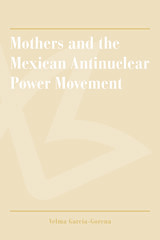 Mothers and the Mexican Antinuclear Power Movement
Velma García-Gorena
University of Arizona Press, 1999 In the early 1970s construction began on a nuclear power plant at Laguna Verde in the Mexican state of Veracruz. Initially, most local citizens were largely unconcerned with the prospect of having the nuclear plant in their community. With the accidents at Three Mile Island and Chernobyl, however, residents' complacency toward the power plant soon turned to opposition. Protest groups such as the Madres Veracruzanas emerged to join existing environmental groups in a fight to close down the facility.
In Mothers and the Mexican Antinuclear Power Movement, Velma García-Gorena traces the protest movement against the Mexican government's Laguna Verde nuclear plant, outlining the movement's formation, development, and decline. Documenting the movement's key players and turning points in superb detail, she interweaves important historical narrative with a deft examination of the events, framing her analysis in terms of social movement literature. In a departure from the more conventional New Social Movements approach to analyzing antinuclear movements, García-Gorena demonstrates how, in many ways, movements of this kind are not so new and how a modified "political process" approach fits much better. With a sophisticated application of various social movements' paradigms, García-Gorena incorporates perspectives such as resource mobilization, political process paradigms, and feminist theory.
Timely, well written, and thoroughly researched, Mothers and the Mexican Antinuclear Power Movement fills a major gap in the literature on grassroots environmental movements in Latin America. Both rich in empirical detail and convincing in its conclusions, this study provides a broader understanding of Mexican social movements and the quest for democracy in developing countries.
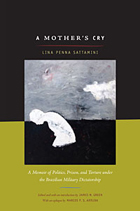 A Mother's Cry: A Memoir of Politics, Prison, and Torture under the Brazilian Military Dictatorship
Lina Penna Sattamini
Duke University Press, 2010 During the late 1960s and early 1970s, Brazil’s dictatorship arrested, tortured, and interrogated many people it suspected of subversion; hundreds of those arrested were killed in prison. In May 1970, Marcos P. S. Arruda, a young political activist, was seized in São Paulo, imprisoned, and tortured. A Mother’s Cry is the harrowing story of Marcos’s incarceration and his family’s efforts to locate him and obtain his release. Marcos’s mother, Lina Penna Sattamini, was living in the United States and working for the U.S. State Department when her son was captured. After learning of his arrest, she and her family mobilized every resource and contact to discover where he was being held, and then they launched an equally intense effort to have him released. Marcos was freed from prison in 1971. Fearing that he would be arrested and tortured again, he left the country, beginning eight years of exile. Lina Penna Sattamini describes her son’s tribulations through letters exchanged among family members, including Marcos, during the year that he was imprisoned. Her narrative is enhanced by Marcos’s account of his arrest, imprisonment, and torture. James N. Green’s introduction provides an overview of the political situation in Brazil, and Latin America more broadly, during that tumultuous era. In the 1990s, some Brazilians began to suggest that it would be best to forget the trauma of that era and move on. Lina Penna Sattamini wrote her memoir as a protest against historical amnesia. First published in Brazil in 2000, A Mother’s Cry is testimonial literature at its best. It conveys the experiences of a family united by love and determination during years of political repression.
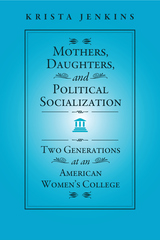 Mothers, Daughters, and Political Socialization: Two Generations at an American Women's College
Krista Jenkins
Temple University Press, 2013 Using a unique data set comparing mothers and daughters who attended Douglass College—the women's college of Rutgers University—twenty-five years apart, Krista Jenkins perceptively observes the changes in how women acquire their attitudes toward gender roles and behaviors in the post-women's movement years.
Mothers, Daughters, and Political Socialization examines the role of intergenerational transmission—the maternal influences on younger women—while also looking at differences among women in attitudes and behaviors relative to gender roles that might be attributed to the nature of the times during their formative years. How do daughters coming of age in an era when the women's movement is far less visible deal with gendered expectations compared to their mothers? Do they accept the contemporary status quo their feminist mothers fought so hard to achieve? Or, do they press forward with new goals?
Jenkins shows how contemporary women are socialized to accept or reject traditional gender roles that serve to undermine their equality.
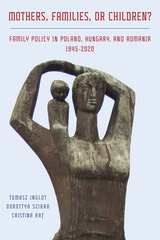 Mothers, Families or Children? Family Policy in Poland, Hungary, and Romania, 1945-2020
Tomasz Inglot
University of Pittsburgh Press, 2022 Mothers, Families, or Children? is the first comparative-historical study of family policies in Poland, Hungary, and Romania from 1945 until the eve of the global pandemic in 2020. The book highlights the emergence, consolidation, and perseverance of three types of family policies based on “mother-orientation” in Poland, “family orientation” in Hungary, and “child-orientation” in Romania. It uses a new theoretical framework to identify core and contingent clusters of benefits and services in each country and trace their development across time and under different political regimes, before and after 1989. It also examines and compares policy continuity and change with special attention to institutions, ideas, and actors involved in decision making and reform. As family policies continue to evolve in the era of European Union membership and new governmental and societal actors emerge, this study reveals mechanisms that help preserve core family policy clusters while allowing reform in contingent ones in each country.
A Mother's Kisses
Bruce Jay Friedman
University of Chicago Press, 2000 A Mother's Kisses is the story of Joseph, a tall, scattered looking boy of seventeen and his wonderfully indomitable mother, Meg, who is resolved, in the summer after her son's high-school graduation to start arranging his life for him, even going so far as to accompany him to college. A work of roaring comedy and emotional honesty, A Mother's Kisses is a classic of modern fiction.
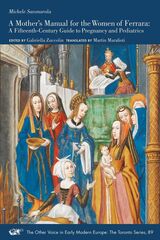 A Mother’s Manual for the Women of Ferrara: A Fifteenth-Century Guide to Pregnancy and Pediatrics
Michele Savonarola
Iter Press, 2022 The first treatise of its kind to be written in a European vernacular.
Around 1460, Michele Savonarola produced the extraordinary Mother’s Manual for the Women of Ferrara, a gynecological, obstetrical, and pediatric treatise composed in the vernacular so that it could be read not only by the learned but also by pregnant and nursing mothers and the midwives and wet nurses who presided over childbirth. Savonarola’s work is not merely a trivial set of instructions, but the work of a learned scholar who drew on, among others, the ancient Greek physicians Hippocrates and Galen, and Avicenna’s Canon of Medicine. The first of its kind, Savonarola’s Mother’s Manual helps readers understand both the development of late-medieval and early-modern obstetrics and gynecology, as well as the experiences of women who turn to advice books for help with reproductive issues. This book also provides a key to understanding why and how a new genre of book—the midwifery manual or advice book for pregnant women—arose in sixteenth-century Italy and eventually became a popular genre all over Europe from the early modern period to the present day.
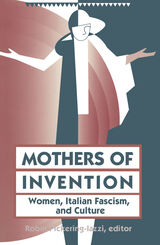 Mothers Of Invention: Women, Italian Facism, and Culture
Robin Pickering-Iazzi
University of Minnesota Press, 1995 The first in-depth look at culture produced by women in Fascist Italy. Mothers of Invention was first published in 1995. Minnesota Archive Editions uses digital technology to make long-unavailable books once again accessible, and are published unaltered from the original University of Minnesota Press editions. To Mussolini, she was either donna-madre, the lauded domestic model, or donna-crisi, intellectual, masculine, a degenerate type. But woman, as Mothers of Invention shows, was not a category so easily defined or contained by the Italian Fascist state. This volume is the first thorough investigation of culture produced by Italian women during Fascism (1922-1943).In literature, painting, sculpture, film, and fashion, the contributors explore the politics of invention articulated by these women as they negotiated prevailing ideologies. Essays on women’s film spectatorship, on Anna Kuliscioff as the leading feminist in the Socialist party, on Teresa Labriola’s concept of Fascist feminism, on futurism and on Irene Brin’s reportage on female fashion and self-invention examine women in mass culture, political thought, and daily living. Contributors: Rosalia Colombo Ascari, Sweet Briar College; Fiora A. Bassanese, U of Massachusetts, Boston; Maurizia Boscagli, U of California, Santa Barbara; Emily Braun, Hunter College, CUNY; Carole C. Gallucci; Mariolina Graziosi, U of Milan; Clara Orban, Depaul U; Lucia Re, UCLA; Jacqueline Reich, Trinity College; and Barbara Spackman, New York University.
 Mothers On The Job: Maternity Policy in the U.S. Workplace
Vogel, Lise
Rutgers University Press, 1993 Women's increasing demands for protection and benefits in the workplace, especially with regard to maternity leave, have sparked more than a century of controversy among feminists on how best to serve the needs of working women. This debate continues to divide the feminist community. One side believes women are better served by emphasizing equality with men--pregnancy should be treated like any other "disability." The other side wants to recognize difference--special provisions should apply only to pregnant women. Lise Vogel examines the evolution of this debate on pregnant women in the workplace, looking at theoretical as well as practical implications. Vogel begins by assessing the history of the contemporary debate on pregnancy policy in the U.S. Since the middle of the nineteenth-century, American women have been torn by the contradictory demands of motherhood and the workplace. Pregnancy was grounds for dismissal from work and few employers took action to protect pregnant workers. To counter this, early twentieth-century feminists and reformers emphasized female specificity and women's special role. In the 1960s activists adopted a strategy framed on equality, which moved away from the earlier emphasis on differences. The use of equality strategies to cover the female-specific phenomenon of pregnancy turned out to have problems. Now women's special needs were denied and ignored. These difficulties and a series of court cases in the 1980s triggered debates in the feminist legal community. Vogel looks at the litigation and debates, which pitted advocates of gender-neutral strategies against critics who called for female-specific policies. Vogel argues that, in terms of practical benefits, women will be served best by a gender-neutral approach to pregnancy policy. She encourages equality advocates to recognize the inherent diversity of individuals, and points out the need to be sensitive to individual factors of race and class, as well as sex.
 Mothers On The Job: Maternity Policy in the U.S. Workplace
Vogel, Lise
Rutgers University Press, 1993 Women's increasing demands for protection and benefits in the workplace, especially with regard to maternity leave, have sparked more than a century of controversy among feminists on how best to serve the needs of working women. This debate continues to divide the feminist community. One side believes women are better served by emphasizing equality with men--pregnancy should be treated like any other "disability." The other side wants to recognize difference--special provisions should apply only to pregnant women. Lise Vogel examines the evolution of this debate on pregnant women in the workplace, looking at theoretical as well as practical implications. Vogel begins by assessing the history of the contemporary debate on pregnancy policy in the U.S. Since the middle of the nineteenth-century, American women have been torn by the contradictory demands of motherhood and the workplace. Pregnancy was grounds for dismissal from work and few employers took action to protect pregnant workers. To counter this, early twentieth-century feminists and reformers emphasized female specificity and women's special role. In the 1960s activists adopted a strategy framed on equality, which moved away from the earlier emphasis on differences. The use of equality strategies to cover the female-specific phenomenon of pregnancy turned out to have problems. Now women's special needs were denied and ignored. These difficulties and a series of court cases in the 1980s triggered debates in the feminist legal community. Vogel looks at the litigation and debates, which pitted advocates of gender-neutral strategies against critics who called for female-specific policies. Vogel argues that, in terms of practical benefits, women will be served best by a gender-neutral approach to pregnancy policy. She encourages equality advocates to recognize the inherent diversity of individuals, and points out the need to be sensitive to individual factors of race and class, as well as sex.
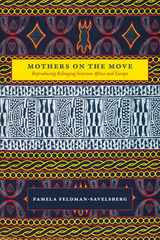 Mothers on the Move: Reproducing Belonging between Africa and Europe
Pamela Feldman-Savelsberg
University of Chicago Press, 2016 The massive scale and complexity of international migration today tends to obscure the nuanced ways migrant families seek a sense of belonging. In this book, Pamela Feldman-Savelsberg takes readers back and forth between Cameroon and Germany to explore how migrant mothers—through the careful and at times difficult management of relationships—juggle belonging in multiple places at once: their new country, their old country, and the diasporic community that bridges them.
Feldman-Savelsberg introduces readers to several Cameroonian mothers, each with her own unique history, concerns, and voice. Through scenes of their lives—at a hometown association’s year-end party, a celebration for a new baby, a visit to the Foreigners’ Office, and many others—as well as the stories they tell one another, Feldman-Savelsberg enlivens our thinking about migrants’ lives and the networks and repertoires that they draw on to find stability and, ultimately, belonging. Placing women’s individual voices within international social contexts, this book unveils new, intimate links between the geographical and the generational as they intersect in the dreams, frustrations, uncertainties, and resolve of strong women holding families together across continents.
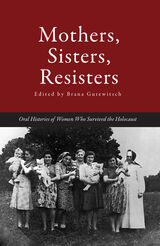 Mothers, Sisters, Resisters: Oral Histories of Women Who Survived the Holocaust
Brana Gurewitsch
University of Alabama Press, 1999 Provides an important historical record of women’s experiences during the Holocaust
In Mothers, Sisters, Resisters, twenty-five survivors of the Holocaust furnish compelling and historically vital testimony that illuminates and explores Jewish women's experiences during that terrible period. In entries that preserve each voice, personality, and style, survivors describe their efforts to evade Nazi laws and subsequent dehumanization, protect their children and siblings, and maintain their Jewish identity.
Throughout each narrative, from Brandla Small’s description of having her child dragged from her arms at Auschwitz, to Eva Schonbrun’s remembrances of her sister who refused to leave her siblings and save herself, to Emilie Schindler’s account of rescuing Jews left abandoned on a cattle car, we become intimately involved with each woman's struggle and eventual survival. We also gain a new appreciation and understanding of the Holocaust experiences unique to women.
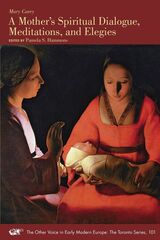 A Mother’s Spiritual Dialogue, Meditations, and Elegies
Mary Carey
Iter Press, 2023 Key insights into women’s multi-dimensional roles as wives, widows, and mothers during the seventeenth century.
Lady Mary Carey (c. 1609–c. 1680) was a noblewoman who examined her life and expressed her views in a handwritten manuscript that she intended for self-reflection and for sharing with restricted audiences of family and friends, rather than for print publication. Her poetry and prose, composed and revised between 1650 and 1658, were important enough to her inner circle, however, that her autograph manuscript was carefully copied by another hand in 1681. In addition to providing us with key insights into women’s multidimensional roles as wives, widows, and mothers during the seventeenth century in England, Carey’s work teaches us a great deal about a woman’s deepest emotional and spiritual states while confronting the hardships of life—from the fears of childbearing to the sorrows over child loss to the terrors of war.
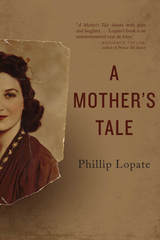 A Mother's Tale
Phillip Lopate
Ohio State University Press, 2017 In 1984, Phillip Lopate sat down with his mother, Frances, to listen to her life story. A strong, resilient, indomitable woman who lived through the major events of the twentieth century, she was orphaned in childhood, ran away and married young, and then reinvented herself as a mother, war factory worker, candy store owner, community organizer, clerk, actress, and singer. But paired with exciting anecdotes are the criticisms of the husband who couldn’t satisfy her, the details of numerous affairs and sexual encounters, and, though she succeeded at many of her roles, accounts of how she always felt mistreated, taken advantage of. After the interviews, at a loss for what to do with the tapes, Lopate put them away. But thirty years later, after his mother had passed away, Lopate found himself drawn back to the recordings of this conversation. Thus begins a three-way conversation between a mother, his younger self, and the person he is today. Trying to break open the family myths, rationalizations, and self-deceptions, A Mother’s Tale is about family members who love each other but who can’t seem to overcome their mutual mistrust. Though Phillip is sympathizing to a point, he cannot join her in her operatic displays of self-pity and how she blames his father for everything that went wrong. His detached, ironic character has been formed partly in response to her melodramatic one. The climax is an argument in which he tries to persuade her—using logic, of all things—that he really does love her, but is only partially successful, of course. A Mother’s Tale is about something primal and universal: the relationship between a mother and her child, the parent disappointed with the payback, the child, now fully grown, judgmental. The humor is in the details.
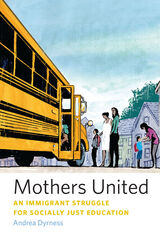 Mothers United: An Immigrant Struggle for Socially Just Education
Andrea Dyrness
University of Minnesota Press, 2010 In urban American school systems, the children of recent immigrants and low-income parents of color disproportionately suffer from overcrowded classrooms, lack of access to educational resources, and underqualified teachers. The challenges posed by these problems demand creative solutions that must often begin with parental intervention. But how can parents without college educations, American citizenship, English literacy skills, or economic stability organize to initiate change on behalf of their children and their community?
In Mothers United, Andrea Dyrness chronicles the experiences of five Latina immigrant mothers in Oakland, California—one of the most troubled urban school districts in the country—as they become informed and engaged advocates for their children’s education. These women, who called themselves “Madres Unidas” (“Mothers United”), joined a neighborhood group of teachers and parents to plan a new, small, and autonomous neighborhood-based school to replace the overcrowded Whitman School. Collaborating with the author, among others, to conduct interviews and focus groups with teachers, parents, and students, these mothers moved from isolation and marginality to take on unfamiliar roles as researchers and community activists while facing resistance from within the local school district.
Mothers United illuminates the mothers’ journey to create their own space—centered around the kitchen table—that enhanced their capacity to improve their children’s lives. At the same time, Dyrness critiques how community organizers, teachers, and educational policy makers, despite their democratic rhetoric, repeatedly asserted their right as “experts,” reproducing the injustice they hoped to overcome. A powerful, inspiring story about self-learning, consciousness-raising, and empowerment, Mothers United offers important lessons for school reform movements everywhere.
 Mothership Connected: The Women of Parliament-Funkadelic
Seth Neblett
University of Texas Press, 2025 An oral history with the women of Parliament-Funkadelic, from forming the band to landing the mothership. Parliament-Funkadelic is perhaps the greatest funk band ever assembled. Yet at the time of the group’s induction into the Rock & Roll Hall of Fame, none of the women who helped create the sound and performed in P-Funk were invited to the ceremony and their contributions have been largely overlooked. Mothership Connected tells the story of Mallia Franklin, Lynn Mabry, Dawn Silva, Debbie Wright, and Shirley Hayden, all of whom were instrumental in making Parliament-Funkadelic, as well as the spin-off groups Parlet and the Brides of Funkenstein, into the legends they are today. Assembled by Seth Neblett, son of the “Queen of Funk” Mallia Franklin, and filled with the voices of funk icons like George Clinton, Sly Stone, Bootsy Collins, and the women themselves, this oral history makes clear why these “architects” at the “core” of P-Funk were both essential—and erased. From Franklin introducing Bootsy Collins to Clinton, to the Brides’ top-10 hit “Disco to Go,” to the drugs that helped destroy the group, this book reveals the hidden lives and uncomfortable truths of life in P-Funk. More than sex, drugs, and rock and roll, Mothership Connected is about Black women navigating a tumultuous era and industry to become musical pioneers. Now, after decades in the shadows, these genre-defining women are finally telling their story.
Mother-Work: Women, Child Welfare, and the State, 1890-1930
Molly Ladd-Taylor
University of Illinois Press, 1994 Early in the twentieth century, maternal and child welfare evolved from a private family responsibility into a matter of national policy. Molly Ladd-Taylor explores both the private and public aspects of child-rearing, using the relationship between them to cast new light on the histories of motherhood, the welfare state, and women's activism in the United States. Ladd-Taylor argues that mother-work, "women's unpaid work of reproduction and caregiving," motivated women's public activism and "maternalist" ideology. Mothering experiences led women to become active in the development of public health, education, and welfare services. In turn, the advent of these services altered mothering in many ways, including the reduction of the infant mortality rate.
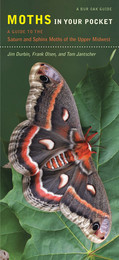 Moths in Your Pocket: A Guide to the Saturn and Sphinx Moths of the Upper Midwest
Jim Durbin, Frank Olsen, and Tom Jantscher
University of Iowa Press, 2014 This welcome addition to Iowa’s popular series of laminated guides—the twenty-seventh in the series—illustrates fifty-one species commonly found in the Upper Midwest states of Illinois, Iowa, Indiana, Michigan, Minnesota, Ohio, and Wisconsin.
The Saturniid, or Giant Silk moths, are well named. Their large size—up to 6.5 inches for the cecropia moth—and the soft silky browns, greens, and oranges of their wings are unforgettable when they appear at a lighted window at night. Equally well named are the Sphinx or Hawk moths, important pollinators that hover like hummingbirds when nectar-feeding at dusk and even in daylight. The caterpillars of both families can be just as distinctive as the adults, as anyone who has ever come upon a tobacco or a tomato hornworm can attest.
For each species the authors have included common and scientific names, wingspan, and time of flight for the adults at this final stage in their life cycle. Striking photographs of the adult moths and of their larval stages make this guide as beautiful as it is useful.
For all naturalists captivated by the clear window eyespots of a Swallow-tailed Luna moth, the dark eyespots and bright yellow “pupils” of an Io moth, or the extendable proboscis of a White-lined Sphinx moth flitting from one moss rose to another, the photographs and descriptions in Moths in Your Pocket will be an invaluable reference.
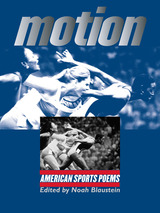 Motion: American Sports Poems
Noah Blaustein
University of Iowa Press, 2001 Sports have long served as inspiration for poetry-the ancient Greeks wrote odes in praise of their athletes-so it is little surprise that in a culture as obsessed with athletes as our own sports would exert an influence on contemporary poets. Motion: American Sports Poems rescues sports from our society's focus on superstars, multimillion-dollar contracts, and gold medals to capture champions and losers, competitors and spectators in moments that are anything but fleeting. As Noah Blaustein points out in his preface, among the many parallels made between sports and poetry is the idea of transcendence. Forged from the most basic elements of sport-energy, movement, and rhythm-the poems in this anthology reflect something universal: sport as metaphor, sport as struggle, sport as the battleground for mythic figures and local heroes.
The often celebrated sports-baseball, boxing, football, and basketball-are here along with unexpected pastimes like surfing, skateboarding, tennis, soccer, karate, rock climbing, bowling, and curling. Young and old, black and white, male and female, the poets in this anthology celebrate everyone who has come together in the shimmy and shake and sweat of sport.
Motion in Maps, Maps in Motion: Mapping Stories and Movement through Time
Zef Segal
Amsterdam University Press, 2020 Motion in Maps, Maps in Motion argues that the mapping of stories, movement, and change should not be understood as an innovation of contemporary cartography, but rather as an important aspect of human cartography with a longer history than might be assumed. The authors in this collection reflect upon the main characteristics and evolutions of story and motion mapping, from the figurative news and history maps that were mass-produced in early modern Europe, through the nineteenth- and twentieth-century flow maps that appeared in various atlases, up to the digital and interactive motion and personalized maps that are created today. Rather than presenting a clear and homogeneous history from the past up until the present, this book offers a toolbox for understanding and interpreting the complex interplays and links between narrative, motion, and maps.
The Motion Of Light In Water: Sex And Science Fiction Writing In The East Village
Samuel R. Delany
University of Minnesota Press, 2004 Winner of the Hugo Award for Non-fiction
The unexpurgated edition of the award-winning autobiography
Born in New York City’s black ghetto Harlem at the start of World War II, Samuel R. Delany married white poet Marilyn Hacker right out of high school. The interracial couple moved into the city’s new bohemian quarter, the Lower East Side, in summer 1961. Through the decade’s opening years, new art, new sexual practices, new music, and new political awareness burgeoned among the crowded streets and cheap railroad apartments. Beautifully, vividly, insightfully, Delany calls up this era of exploration and adventure as he details his development as a black gay writer in an open marriage, with tertiary walk-ons by Bob Dylan, Stokely Carmichael, W. H. Auden, and James Baldwin, and a panoply of brilliantly drawn secondary characters.
Motion Vision: Design of compact motion sensing solutions for navigation of autonomous systems
J. Kolodko
The Institution of Engineering and Technology, 2005 Segmenting the environment surrounding an autonomous vehicle into coherently moving regions is a vital first step towards intelligent autonomous navigation. Without this temporal information, navigation becomes a simple obstacle avoidance scheme that is inappropriate in highly dynamic environments such as roadways and places where many people congregate.
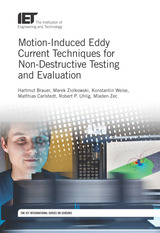 Motion-Induced Eddy Current Techniques for Non-Destructive Testing and Evaluation
Hartmut Brauer
The Institution of Engineering and Technology, 2019 Non-destructive testing (NDT) analysis techniques are used in science, technology and medicine to evaluate the properties of a material, component or system, without causing damage or altering the article being inspected. It is a highly valuable technique that can save money and time in product evaluation, troubleshooting, and research. Well known and widely used in industrial applications since the 60s, the NDT market is developing and growing fast. This book focuses on electromagnetic NDT methods and more specifically on the motion induced eddy current testing and evaluation (MIECTE) techniques used for conductive materials via electromagnetic methods, focusing on the Lorentz force eddy current testing (LET) method which was introduced recently. The authors present the modelling and simulation of LET systems as well as the optimal design of the measurement setups. They also show the wide variety of applications of the LET method including defect identification and sigmometry to estimate electrical conductivity of the tested material.
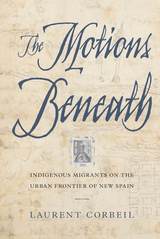 The Motions Beneath: Indigenous Migrants on the Urban Frontier of New Spain
Laurent Corbeil
University of Arizona Press, 2018 As Mexico entered the last decade of the sixteenth century, immigration became an important phenomenon in the mining town of San Luis Potosí. New silver mines sparked the need for labor in a region previously lacking a settled population. Drawn by new jobs, thousands of men, women, and children poured into the valley between 1591 and 1630, coming from more than 130 communities across northern Mesoamerica.
The Motions Beneath is a social history of the encounter of these thousands of indigenous peoples representing ten linguistic groups. Using baptism and marriage records, Laurent Corbeil creates a demographic image of the town’s population. He studies two generations of highly mobile individuals, revealing their agency and subjectivity when facing colonial structures of exploitation on a daily basis.
Corbeil’s study depicts the variety of paths on which indigenous peoples migrated north to build this diverse urban society. Breaking new ground by bridging stories of migration, labor relations, sexuality, legal culture, and identity construction, Corbeil challenges the assumption that urban indigenous communities were organized along ethnic lines. He posits instead that indigenous peoples developed extensive networks and organized themselves according to labor, trade, and social connections.
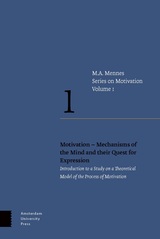 Motivation – Mechanisms of the Mind and their Quest for Expression: Introduction to a Study on a Theoretical Model of the Process of Motivation
Menno A. Mennes
Amsterdam University Press, 2023 This Volume presents a first introduction to a thought-provoking Model of Motivation developed by Menno Mennes over a period of almost thirty years. The Model of Motivation in its approach presents a radical departure from everything that has appeared so far in literature on the subject.
And yet, it provides a surprisingly detailed account of how motivation works, which appears to be supported by findings from theories and research from current literature. In an unparalleled analysis, the Model seamlessly integrates these major theories into a consistent comprehensive approach to motivation, explaining not only the essentials of each theory, but also providing explanations for controversies that have hitherto remained largely unresolved.
Motivation appears to be an 'inner dialogue', a stepwise, partly cyclical Process in which we deal with our surroundings that often interfere in our ambitions, our wishes and desires. Deep personal insights into those ‘Mechanisms of the Mind’ reveal implications that may lead to a fundamental, new understanding of the origins of many disturbing issues we witness in present-day society, including neglect and denial, intolerance, discord and polarization.
Motivation and the Primacy of Perception: Merleau-Ponty's Phenomenology of Knowledge
Peter Antich
Ohio University Press, 2021 Merleau-Ponty’s phenomenological notion of motivation advances a compelling alternative to the empiricist and rationalist assumptions that underpin modern epistemology. Arguing that knowledge is ultimately founded in perceptual experience, Peter Antich interprets and defends Merleau-Ponty’s thinking on motivation as the key to establishing a new form of epistemic grounding. Upending the classical dichotomy between reason and natural causality, justification and explanation, Antich shows how this epistemic ground enables Merleau-Ponty to offer a radically new account of knowledge and its relation to perception. In so doing, Antich demonstrates how and why Merleau-Ponty remains a vital resource for today’s epistemologists.
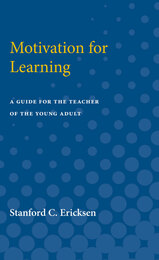 Motivation for Learning: A Guide for the Teacher of the Young Adult
Stanford C. Ericksen
University of Michigan Press, 1974 Motivation for Learning is a book for teachers—but not only for teachers: parents and administrators will also find it of value. Ultimately, too, it is a book for students—for their independence and growth and against their boredom in the classroom.Stanford C. Ericksen writes out of years of experience, both as a teacher and as director of the Center for Research on Learning and Teaching at the University of Michigan. In a practical fashion, he brings together the significant applications from research and theory about learning, motivation, personality, and group dynamics. The book says more about the conditions for learning than about the techniques of teaching: projecting one's voice to the back of the room is judged to be less important than is the instructor's ability to make sense to young adults and to challenge their curiosity. Throughout, the primary focus is on the stimulation and encouragement of the individual student's motivation to acquire new knowledge and new attitudes and values.Only a person of Ericksen's special experience could have written such a book. Equally important, only a person who likes and respects students as much as he does could have given the book its special quality of human warmth and understanding.
Motive and Intention: An Essay in the Appreciation of Action
Roy Lawrence
Northwestern University Press, 1972 Motive and Intention is a critique of certain conceptual foundations of the description and judgment of human action. Drawing on sources such as narrative history, Roy Lawrence analyzes examples of such assessments and provides and independent base for appraising familiar and tenacious theoretical presumptions. In so doing he illuminates many persistent issues of common interest in the social science
 Motives for Allusion: Context and Content in Nineteenth-Century Music
Christopher Alan Reynolds
Harvard University Press, 2003 When a critic pointed out to Brahms that the finale theme in his First Symphony was remarkably similar to the Ode to Joy theme in Beethoven's Ninth, he is said to have replied: "Yes indeed, and what's really remarkable is that every jackass notices this at once." Not every musical borrowing is quite so obvious; but the listener who does perceive one is always left wondering: what does the similarity mean? In this illuminating book Christopher Reynolds gives us answers to that complex question.
Reynolds identifies specific borrowings or allusions in a wide range of nineteenth-century music. He shows the kinds of things composers do with borrowed musical ideas, and discusses why a composer would choose to deploy such allusions. A rich historical background for the practice emerges from his analysis. Musical borrowing touches directly on issues of central importance for nineteenth- and twentieth-century composition: notions of creativity and originality, the constraints of tradition and innovation, musical symbolism and the listener's ear. In clarifying what it can mean when one piece of music invokes or refers to another, Reynolds expands our understanding of what we hear.
 Motives for Fiction
Robert Alter
Harvard University Press, 1984 “For many serious readers,” Robert Alter writes in his preface, “the novel still matters, and I have tried here to suggest some reasons why that should be so.” In his wide-ranging discussion, Alter examines the imitation of reality in fiction to find out why mimesis has become problematic yet continues to engage us deeply as readers.
Alter explores very different sorts of novels, from the self-conscious artifices of Sterne and Nabokov to what seem to be more realistic texts, such as those of Dickens, Flaubert, John Fowles, and the early Norman Mailer. Attention is also given to such individual critics as Edmund Wilson and Alfred Kazin and to current critical schools. In Alter’s essays, a particular book or movement or juxtaposition of writers provides the occasion for the exploration of a general intellectual issue. The scrutiny of well-chosen passages, the joining of images or themes or ideas, the associative and intuitive processes that lead to the right phrase and the right loop of syntax for the matter at hand-all these come together unexpectedly to illuminate both the text in question and the general issue.
Recent discussions of mimesis in fiction generally proceed from a single thesis. By contrast, Motives for Fiction offers an empirical approach, attempting to define mimesis in its various guises by careful critical readings of a heterogeneous sampling of literary texts. Intelligent and good-humored, the book is also old-fashioned enough to wonder whether mimesis might not be a task or responsibility to which much contemporary fiction has not proved entirely adequate.
Motives For Metaphor: Literacy, Curriculum Reform, and the Teaching of English
James E. Seitz
University of Pittsburgh Press, 1999 Despite urgent calls for reform, composition, literature, and creative writing, remain territorial, competitive fields. This book imagines ways in which the three English camps can reconnect. Seitz contends that the study of metaphor can advance curriculum reform precisely because of its unusual institutional position. By pronouncing equivalence in the very face of difference, metaphor performs an irrational discursive act that takes us to the nexus of textual, social, and ideological questions that have stirred such contentious debate in recent years over the function of English studies itself. As perhaps the most radical (yet also quotidian) means by which language negotiates difference, metaphor can help us to think about the politics of identification and the curricular movements such a politics has inspired.
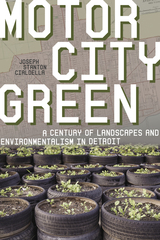 Motor City Green: A Century of Landscapes and Environmentalism in Detroit
Joseph S. Cialdella
University of Pittsburgh Press, 2020
Winner, 2021 CCL J. B. Jackson Book Prize
Motor City Green is a history of green spaces in metropolitan Detroit from the late nineteenth- to early twenty-first century. The book focuses primarily on the history of gardens and parks in the city of Detroit and its suburbs in southeast Michigan. Cialdella argues Detroit residents used green space to address problems created by the city’s industrial rise and decline, and racial segregation and economic inequality. As the city’s social landscape became increasingly uncontrollable, Detroiters turned to parks, gardens, yards, and other outdoor spaces to relieve the negative social and environmental consequences of industrial capitalism. Motor City Green looks to the past to demonstrate how today’s urban gardens in Detroit evolved from, but are also distinct from, other urban gardens and green spaces in the city’s past.
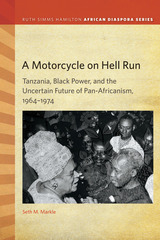 A Motorcycle on Hell Run: Tanzania, Black Power, and the Uncertain Future of Pan-Africanism, 1964–1974
Seth M. Markle
Michigan State University Press, 2017 Between 1964 and 1974 Tanzania came to be regarded as a model nation and a leading frontline state in the struggle for African liberation on the continent and beyond. During this time, a number of African American and Caribbean nationalists, leftists, and pan-Africanists traveled to and settled in Tanzania to join the country that many believed to be leading Africa’s liberation struggle. This historical study examines the political landscape of that crucial moment when African American, Caribbean, and Tanzanian histories overlapped, shedding light on the challenges of creating a new nation and the nature of African American and Caribbean participation in Tanzania’s nationalist project. In examining the pragmatic partnerships and exchanges between socialist Tanzania and activists and organizations associated with the Black Power movements in the United States and the Caribbean, this study argues that the Tanzanian one-party government actively engaged with the diaspora and sought to utilize its political, cultural, labor, and intellectual capital to further its national building agenda, but on its own terms, creating tension within the pan-Africanism movement. An excellent resource for academics and nonacademics alike, this work is the first of its kind, revealing the significance of the radical political and social movements of Tanzania and what it means for us today.
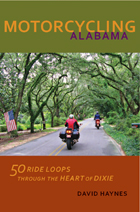 Motorcycling Alabama: 50 Ride Loops through the Heart of Dixie
David Haynes
University of Alabama Press, 2011 A much-needed guidebook for one of the most beautiful states to explore on two wheels David Haynes offers fifty ride loops of between 75 and 150 miles in length throughout every region of the state. The start and stop points for each ride are identical and easy to locate. This handy guide, which is designed to fit in a tank bag, features both streetbike and dual-sport rides. Also included are detailed, color-coded maps of the routes and turn-by-turn directions. Stunning full-color photographs accompany each ride description, highlighting scenes and points of interest along the way. There are introductory chapters on motorcycle safety, gear, and the use of global positioning devices, as well as pointers on motorcycle camping. The companion website, motorcyclingalabama.info, offers sample rides and downloadable GPS codes for all fifty rides, and hosts an author blog. Motorcycle touring is one of the fastest-growing outdoor recreational pursuits in the country. For both the in-state and out-of-state motorcycle enthusiast, Motorcycling Alabama is a valuable and complete guide to a state rich in diverse types of scenery and with many unsung treasures yet to be discovered. Published in cooperation with the Barber Vintage Motorsports Museum, Birmingham.
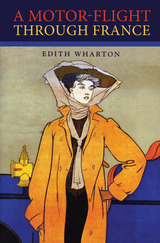 A Motor-Flight Through France
Edith Wharton
Northern Illinois University Press, 2012 Shedding the constraints that existed for women in turn-of-the-century America, Edith Wharton set out in the newly invented "motor-car" to explore the cities and countryside of France. Originally published in 1908, A Motor-Flight Through France is considered by many to be the very best of Wharton’s outstanding travel writings.
While Wharton’s novels are darkly funny and deliciously catty, and her short stories are populated by adulterers, murderers, and artists, A Motor-Flight Through France captures all of the riches and charm of France during the Belle Époque in gorgeous, romantic prose. Like many Americans, Wharton was utterly beguiled by France at the dawn of the twentieth century, and in this volume her brilliant sketches of "l’Hexagone" provide an enchanting and indelible portrait of the land during this era. But Wharton’s travelogue is as much about the thrill of travel as it is about place. With the automobile in its infancy, Wharton was experiencing the countryside as few people ever had, liberated from the ugliness of train yards and the constraints of passage by rail. “The motor-car has restored the romance of travel,” she wrote, and readers of this wonderful book will be grateful to experience it through her eyes.
A Motor-Flight Through France
Edith Wharton
Northern Illinois University Press, 1991
Shedding the turn-of-the-century social confines she felt existed for women in America, Edith Wharton set out in the newly invented "motor-car" to explore the cities and countryside of France. In A Motor-Flight Through France, originally published in 1908, Wharton combines the power of her prose, her love for travel, and her affinity for France to produce this compelling travelogue.
Now back in print, this edition of will interest students of American literature as well as those who wish to see France through the eyes of a great American writer. The introduction analyzes Wharton's use of the genre of travel writing and places Wharton's work in the context of her life and times.
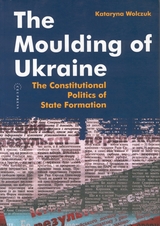 The Moulding of Ukraine: The Constitutional Politics of State Formation
Kataryna Wolczuk
Central European University Press, 2002 With the disintegration of the Soviet Union, a number of new states were created that had little or no claim to any previous existence. Ukraine is one of the countries that faced not only political, social and economic transformation, but also state formation and the redefinition of national identity. This book uses Ukraine as a case study in trying to trace the key moments of decision making in the course of creating a new state while shedding the legacies of "Soviet-type" statehood. The Moulding of Ukraine offers a systematic examination of competing ideological visions of statehood and discusses them against the backdrop of historical traditions in Ukraine. This well-documented and lucidly written book is the only coherent account available in English of the process of constitutional reform, offering an insight into post-Soviet Ukrainian politics. A useful addition to university course reading lists in Ukrainian studies, post-Soviet studies, post-communist democratization, comparative constitutionalism, state-building and institutional design.
The Moulids of Egypt: Egyptian Saint’s Day Festivals
J.W. McPherson
Gingko, 2022 A fascinating and highly original contribution to the study of Egypt’s religious folklore.
First published in Cairo during World War II, The Moulids of Egypt is a study of moulids, the popular Egyptian religious festivals celebrated by both Muslims and Christians in the first half of the twentieth century. The book talks in detail about the secular side of moulids, where sports, games, theatres, dancing, and laughter were as much part of the festivals as the religious processions and the whirling of dervishes. Some of the rites and customs analyzed here date from as far back as the Pharaonic period, but the moulids are gradually dying out; many of the 126 festivals described in Moulids of Egypt have since faded away, making the book of lasting interest.
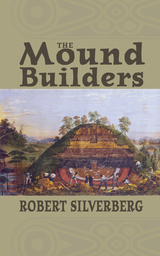 The Mound Builders
Robert Silverberg
Ohio University Press, 1986 In Illinois, the one-hundred-foot Cahokia Mound spreads impressively across sixteen acres, and as many as ten thousand more mounds dot the Ohio River Valley alone. The Mound Builders traces the speculation surrounding these monuments and the scientific excavations which uncovered the history and culture of the ancient Americans who built them. The mounds were constructed for religious and secular purposes some time between 1000 B.C. and 1000 A.D., and they have prompted curiosity and speculation from very early times. European settlers found them evidence of some ancient and glorious people. Even as eminent an American as Thomas Jefferson joined the controversy, though his conclusions—that the mounds were actually cemeteries of ancient Indians—remained unpopular for nearly a century. Only in the late 19th century, as Smithsonian Institution investigators developed careful methodologies and reliable records, did the period of scientific investigation of the mounds and their builders begin. Silverberg follows these excavations and then recounts the story they revealed of the origins, development, and demise of the mound builder culture.
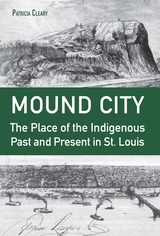 Mound City: The Place of the Indigenous Past and Present in St. Louis
Patricia Cleary
University of Missouri Press, 2025 Winner of the 2025 Midland Authors Award in the History category
Nearly one thousand years ago, Native peoples built a satellite suburb of America's great metropolis on the site that later became St. Louis. At its height, as many as 30,000 people lived in and around present-day Cahokia, Illinois. While the mounds around Cahokia survive today (as part of a state historic site and UNESCO world heritage site), the monumental earthworks that stood on the western shore of the Mississippi were razed in the 1800s. But before and after they fell, the mounds held an important place in St. Louis history, earning it the nickname “Mound City.” For decades, the city had an Indigenous reputation. Tourists came to marvel at the mounds and to see tribal delegations in town for trade and diplomacy. As the city grew, St. Louisans repurposed the mounds—for a reservoir, a restaurant, and railroad landfill—in the process destroying cultural artifacts and sacred burial sites. Despite evidence to the contrary, some white Americans declared the mounds natural features, not built ones, and cheered their leveling. Others espoused far-fetched theories about a lost race of Mound Builders killed by the ancestors of contemporary tribes. Ignoring Indigenous people's connections to the mounds, white Americans positioned themselves as the legitimate inheritors of the land and asserted that modern Native peoples were destined to vanish. Such views underpinned coerced treaties and forced removals, and—when Indigenous peoples resisted—military action. The idea of the “Vanishing Indian” also fueled the erasure of Indigenous peoples’ histories, a practice that continued in the 1900s in civic celebrations that featured white St. Louisans “playing Indian” and heritage groups claiming the mounds as part of their own history. Yet Native peoples endured and in recent years, have successfully begun to reclaim the sole monumental mound remaining within city limits.
Drawing on a wide range of sources, Patricia Cleary explores the layers of St. Louis’s Indigenous history. Along with the first in-depth overview of the life, death, and afterlife of the mounds, Mound City offers a gripping account of how Indigenous histories have shaped the city’s growth, landscape, and civic culture.
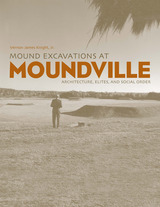 Mound Excavations at Moundville: Architecture, Elites and Social Order
Vernon James Knight, Jr.
University of Alabama Press, 2010 How social and political power was wielded in order to build Moundville This work is a state-of-the-art, data-rich study of excavations undertaken at the Moundville site in west central Alabama, one of the largest and most complex of the mound sites of pre-contact North America. Despite the site's importance and sustained attention by researchers, until now it has lacked a comprehensive analysis of its modern excavations. Richly documented by maps, artifact photo-graphs, profiles of strata, and inventories of materials found, the present work explores one expression of social complexity; the significance of Moundville’s monumental architecture, including its earthen mounds; the pole-frame architecture that once occupied the summits of these mounds; and the associated middens that reveal the culture of Moundville’s elites. This book supplies a survey of important materials recovered in more than a decade of recent excavations of seven mounds and related areas under the author’s direction, as part of a long-term archaeological project consisting of new field work at the Mississippian political and ceremonial center of Moundville. Visitors to Moundville are immediately impressed with its monumentality. The expansiveness and grandness of that landscape are, of course, deliberate features that have a story to tell and this archaeological project reveals Moundville’s monumentality and its significance to the people whose capital town it was. Exactly how the social and political power symbolized by mound building was distributed is a question central to this work. It seems critical to ask to what extent this monumental landscape was the product of a chief’s ability to recruit and direct the labor of large groups of political subordinates, most of whom were presumably non-kin. At the onset of the present project, speculations regarding the paired orders of mounds and the timing of the formal structuring of space at Moundville were already suggested but were in need of further testing, confirmation, and refinement. The work reported in this volume is largely devoted to filling in such evidence and refining those initial insights. An excellent chapter by H. Edwin Jackson and Susan L. Scott, "Zooarchaeology of Mounds Q, G, E, F, and R," compliments this research. A Dan Josselyn Memorial Publication
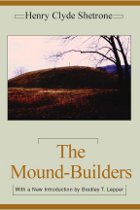 The Mound-Builders
Henry Clyde Shetrone; with a new introduction by Bradley T. Lepper
University of Alabama Press, 2004 A Dan Josselyn Memorial Publication
A classic resource on early knowledge of prehistoric mounds and the peoples who constructed them in the eastern United States
With this accessible volume, Henry Clyde Shetrone made available to general readers the archaeological research data and conclusions concerning the ancient mounds and earthworks that dot the landscape of eastern North America. Dismissing popularly held theories of mysterious giants who built these structures, he explained that their purposes were defensive and ceremonial, that they had been used for habitation, burial, and worship. Their builders were antecedents of the native peoples of present-day America and had been skilled artisans and engineers with successful agricultural practices and structured leadership.
Twenty chapters discuss aspects of mound-builder cultures: quarrying of flint and obsidian for knapping into points; mining of copper and iron and its fashioning into tools and ceremonial objects; spinning and weaving materials and methods; smoking customs; carving of calumets and their use in ceremony; freshwater pearls and other items for body ornamentation; and the use of stone burial vaults, cremation basins, and concepts of an afterlife. Data is presented from excavations ranging broadly from Massachusetts to Florida and from Texas to North Dakota.
As Bradley Lepper points out in his new introduction, "The Mound-Builders is a testament to Shetrone's success at working towards 'correlation and systematization' of data, as well as public education. . . . Shetrone was no armchair popularizer. His work was based on years of excavation and first-hand familiarity with much of the data. His popularizations [still] echo with the ring of the shovel and trowel in gravelly soil."
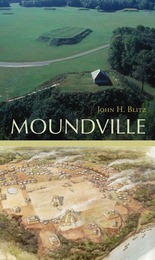 Moundville
John H. Blitz
University of Alabama Press, 2008 Inaugural pocket guide from our new series of illustrated guidebooks In the 13th century, Moundville was one of the largest Native American settlements north of Mexico. Spread over 325 acres were 29 earthen mounds arranged around a great plaza, a mile-long stockade, and dozens of dwellings for thousands of people. Moundville, in size and complexity second only to the Cahokia site in Illinois, was a heavily populated town, as well as a political and religious center. Moundville was sustained by tribute of food and labor provided by the people who lived in the nearby floodplain as well as other smaller mound centers. The immediate area appears to have been thickly populated, but by about A.D. 1350, Moundville retained only ceremonial and political functions. A decline ensued, and by the 1500s the area was abandoned. By the time the first Europeans reached the Southeast in the 1540s, the precise links between Moundville's inhabitants and what became the historic Native American tribes had become a mystery. Illustrated with 50 color photos, maps, and figures, Moundville tells the story of the ancient people who lived there, the modern struggle to save the site from destruction, and the scientific saga of the archaeologists who brought the story to life. Moundville is the book to read before, during, or after a visit to Alabama’s prehistoric metropolis.
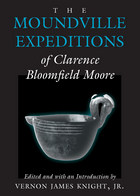 The Moundville Expeditions of Clarence Bloomfield Moore: Clarence Bloomfield Moore
Clarence Bloomfield Moore, edited and introduced by Vernon James Knight, Jr.
University of Alabama Press, 1996 The two works reprinted in this volume represent the pinnacle of the career of one of the most remarkable American archaeologists of the early 20th century, Clarence Bloomfield Moore.
Moore's Certain Aboriginal Remains of the Black Warrior River (1905) and Moundville Revisited (1907) brought the Moundville site in Alabama to the attention of the scholarly world in dramatic fashion by offering a splendid photographic display and expert commentary on its artifactual richness. Moore was the leading southeastern specialist of his day and the most prolific excavator of southern sites during the early part of the 20th century. Today Moore gives the impression of having been everywhere, having excavated everything, and having published on all of it. Moundville Expeditions contains facsimile reprints of these two classic works, along with a new scholarly introduction by one of the leading authorities on the Moundville archaeological site. Once again these rare materials on Moundville are available both for scholars and for a general audience.
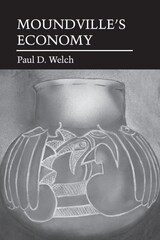 Moundville's Economy
Paul D. Welch
University of Alabama Press, 1991 A Dan Josselyn Memorial Publication
Anthropologists have long talked about chiefdoms as a form of sociopolitical organization, and for several decades Elman Service's description of chiefdoms has been widely accepted as definitive. Nevertheless, in the 1970s, scholars began to question whether all, or any, chiefdoms had the entire range of characteristics described by Service. Most of the questions focused on the (nonmarket) economic organization of these polities, and several contrasting economic models were suggested. None of the models, however, was comprehensively tested against actual chiefdom economies.
This study examines the economic organization of the late prehistoric (A.D. 1000 to 1540) chiefdom centered at Moundville, Alabama. Rather than attempting to show that this case fits one or another model, the economic organization is determined empirically using archaeological data. The pattern of production and distribution of subsistence goods, domestic nonutilitarian goods, and imported prestige goods does not fit precisely any of the extant models. Because Moundville's economy was organized in a way that promoted stability, it may be no accident that Moundville was the dominant regional polity for several hundred years. This research opens a new field of archaeological investigation: the relationship between fine details of economic organization and large-scale political fortunes.
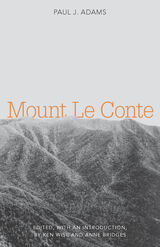 Mount Le Conte
Kenneth Wise
University of Tennessee Press, 2016
In print for the first time in fifty years, Mount Le Conte is a reissue of the important 1966 self-published memoir by Paul J. Adams (1901–1985), a well-known Tennessee naturalist and the first custodian of the Smoky Mountain’s majestic summit in the years before the area was declared a national park.
Appointed custodian of Mount Le Conte in 1925 by the Great Smoky Mountains Conservation Association, Adams went to work immediately and spent a year making the camp suitable for overnight visitors. Mount Le Conte, a massive mile-high formation extending five miles from the main divide of the Great Smoky Mountains, with its rugged landscapes, rushing streams, and fecund forests, was considered a prime showplace in efforts to establish the Smokies as a national park.
In addition to an extensive introduction, the editors have augmented the original text of Mount Le Conte with several photographs and sketches gleaned from Adams’s personal papers, resulting in a fuller, more complete reconstruction of Adams’s role in establishing the camp that would later come to be known as Le Conte Lodge.
An important source on the fascinating history of Mount Le Conte in the pre-Park era, this book is a companion to the recently published Smoky Jack: The Adventures of a Dog and his Master on Mount Le Conte (University of Tennessee Press, 2016).
ANNE BRIDGES AND KEN WISE are co-directors of the Great Smoky Mountains Regional Project and coeditors, with Russell Clement, of Terra Incognita: An Annotated Bibliography of the Great Smoky Mountains, 1544–1934. Bridges is an associate professor at the John C. Hodges Library at the University of Tennessee. Wise is a professor at the John C. Hodges Library, author of Hiking Trails of the Great Smoky Mountains, and co-author of A Natural History of Mount Le Conte.
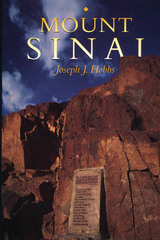 Mount Sinai
By Joseph J. Hobbs
University of Texas Press, 1995 Amid the high mountains of Egypt's southern Sinai Peninsula stands Jebel Musa, "Mount Moses," revered by most Christians and Muslims as Mount Sinai. (Jewish tradition holds that Mount Sinai should remain terra incognita, unlocated, and does not associate it with this mountain.) In this fascinating study, Joseph Hobbs draws on geography and archaeology, Biblical and Quranic accounts, and the experiences of people ranging from Christian monks to Bedouin shepherds to casual tourists to explore why this mountain came to be revered as a sacred place and how that very perception now threatens its fragile ecology and its sense of holy solitude. After discussing the physical characteristics of Jebel Musa and the debate that selected it as the most probable Mount Sinai, Hobbs fully describes all Christian and Muslim sacred sites around the mountain. He views Mount Sinai from the perspectives of the centuries-long inhabitants of the region—the monks of the Monastery of St. Katherine and the Jabaliya Bedouins—and of tourists and pilgrims, from medieval Europeans to modern travelers dispirited by Western industrialization. Hobbs concludes his account with the recent international debate over whether to build a cable car on Mount Sinai and with an unflinching description of the negative impact of tourism on the delicate desert environment. His book raises important, troubling questions for everyone concerned about the fate of the earth's wild and sacred places.
 Mount Sinai: A History of Travellers and Pilgrims
George Manginis
Haus Publishing, 2016 A mountain peak above Saint Catherine’s Monastery in Egypt, Mount Sinai is best known as the site where Moses received the Ten Commandments in the biblical Book of Exodus. Mount Sinai brings this rich history to light, exploring the ways in which the landscape of Mount Sinai’s summit has been experienced and transformed over the centuries, from the third century BCE to World War I.
As an important site for multiple religions, Mount Sinai has become a major destination for hundreds of visitors per day. In this multifaceted book, George Manginis delves into the natural environment of Mount Sinai, its importance in the Muslim tradition, the cult of Saint Catherine, the medieval pilgrimage phenomenon, modern-day tourism, and much more. Featuring notes, a bibliography, and illustrations from nineteenth-century travelers’ books, this deft blend of historical analysis, art history, and archaeological interpretation will appeal to tourists and scholars alike.
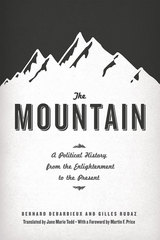 The Mountain: A Political History from the Enlightenment to the Present
Bernard Debarbieux and Gilles Rudaz
University of Chicago Press, 2015 In The Mountain, geographers Bernard Debarbieux and Gilles Rudaz trace the origins of the very concept of a mountain, showing how it is not a mere geographic feature but ultimately an idea, one that has evolved over time, influenced by changes in political climates and cultural attitudes. To truly understand mountains, they argue, we must view them not only as material realities but as social constructs, ones that can mean radically different things to different people in different settings.
From the Enlightenment to the present day, and using a variety of case studies from all the continents, the authors show us how our ideas of and about mountains have changed with the times and how a wide range of policies, from border delineation to forestry as well as nature protection and social programs, have been shaped according to them. A rich hybrid analysis of geography, history, culture, and politics, the book promises to forever change the way we look at mountains.
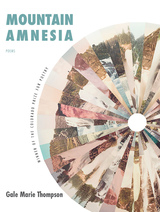 Mountain Amnesia
Gale Marie Thompson
University Press of Colorado, 2023 In Mountain Amnesia, Thompson’s poems rebuild a new world—and self—in the wake of destruction and loss. Influenced by the landscape of rural Appalachia, these poems depict a nature relentlessly working on its own disappearance for survival. Decaying plants and animal remains are housed in the same world as ramps and bellflowers on the cusp of blooming. These poems do not placate or cover up the inevitability of death, but rather use this knowledge to seek connection and make meaning: “how little and yet / how much it matters to count the dead.” Mountain Amnesia seeks a path through destruction, using ruin to clear the way for new beginnings; or, as Thompson writes, “the painful, florid bloom of passing forward.” This collectionis a testament to survival and resilience, and animal encounters—the lonely fox, the folded fawn, the returning whale, the emerging voles—become new myths along the way.
Mountain Amnesia also explores the question of how implicated or dependent we are on the lives and actions of others. What does it mean to be accountable to and responsible for those around you? How are we implicated in others’ crimes? What can we do in the aftermath? The poems in this collection explore the limits of knowing and seeing, and how we come to be known and seen: “I ask the world for its bandage /of meaning.” Mountain Amnesia both pursues and surrenders to these limits of knowing, narrowing the vast distances between ourselves and others.
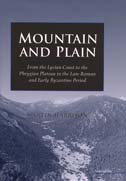 Mountain and Plain: From the Lycian Coast to the Phrygian Plateau in the Late Roman and Early Byzantine Period
Martin Harrison
University of Michigan Press, 2001 Martin Harrison traveled widely in Asia Minor from his youth onward, and he was always fascinated by the questions of how and why the great and elegant cities of classical antiquity declined, and what happened to the descendants of the people who lived in them. Over nearly forty years he returned again and again to remote Lycia, where the ruins of monasteries and churches, villages, hamlets, and towns remained largely inaccessible and unexplored. His interest eventually led him to undertake the excavation of the Phrygian city of Amorium, whose importance became greater as the classical cities declined. At its peak it was considered second only to Byzantium, until it fell to the Arab invasions.
The present study is the fruit of years of excavation and research by the author. The manuscript was largely sketched out when Martin Harrison unexpectedly passed away, and the volume has been finished and prepared for press by his long-time assistant Wendy Young, with further guidance from friends and colleagues with whom he had discussed the project.
The resulting volume explores Martin Harrison's belief that the coastal cities of Lycia declined after the fifth century C.E., and that smaller settlements (monasteries, villages, and towns) appeared in the mountains and further inland. In addition he considered that there was a demographic shift of masons and sculptors from the cities to serve these new settlements. This beautifully illustrated study provides convincing evidence from architecture, sculpture, and inscriptional sources to support this theory. It also contains a description of Amorium in Phrygia, as revealed in survey and excavation seasons from 1987 until the author's untimely death half a dozen years later. The volume includes a preface by Stephen Hill and an appendix by Michael Ballance and Charlotte Roueché on three special inscriptions from Ovacik.
The volume will be of interest to historians of the Near East and classical antiquity, to archaeologists, and to students of architectural history.
Martin Harrison was Professor of Archaeology, University of Oxford. Wendy Young was Research Assistant to the author until his death.
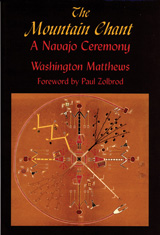 The Mountain Chant: A Navajo Ceremony
Matthews, Washington
University of Utah Press, 1997 The Mountain Chant is a nine-day Navajo healing ceremony, one of several major rites undertaken only in winter. Aside from curing disease, it brings rain and invokes the unseen powers for general benefit. Though perhaps practiced less often now than better-known ceremonies such as the Night Chant, it is by no means forgotten.
Fully faithful to the original book published by Washington Matthews over a century ago, this edition contains the story of the wandering hero upon whose exploits the Mountain Chant is based, a description of each of the nine ceremonial days, and original song text and translations.
"Each Navajo ceremony builds on a specific story, which in turn contributes to a network of interlocking narratives as poetically rich as the Homeric epics or the Arthurian cycle. Non-Navajos are only now beginning to fathom the extent of that poetic richness as we learn more about the nature of ceremonial Navajo, with its formulaic virtuosity, its rhythmic cadences, its deep allusiveness to enduring human values, and the spellbinding thrust of its stories."
- Paul Zolbrod, from the foreword
 Mountain Dialogues
Frank Waters
Ohio University Press, 1999 “Mysticism is peculiar to the mountainbred,” Frank Waters once told an interviewer for Psychology Today. And in Mountain Dialogues, available for the first time in paperback, the mountainbred Waters proves it true. Ranging over such diverse subjects as silence, spirits, time, change, and the sacred mountains of the world, Waters sounds again and again the radiant, mystic theme of man’s inherent wholeness and his oneness with the cosmos. Writing in Western American Literature, Charles L. Adams said, “In Mountain Dialogues, we see Frank Waters acknowledging his sources—major influences on a great American thinker and writer. Waters weaves together threads of these influences, adds his own thought, and presents us with a truly cosmic overview. This overview is thoroughly that of an American ‘Westerner’; it also is one that merits international consideration.” And as the Bloomsbury Review wrote: “Mountain Dialogues is more than just a collection of personal essays. It is an ‘evolutionist’s handbook’ for the sons and daughters of the new West, a guide for those who would transcend the limitations of Western civilization.”
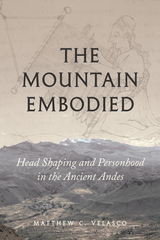 The Mountain Embodied: Head Shaping and Personhood in the Ancient Andes
Matthew C. Velasco
University of Texas Press, 2025 A study of the ancient practice of Andean head shaping and its cultural connotations. In the late sixteenth century, Spanish conquerors in Peru’s Colca Valley encountered the Collaguas and Cavanas, Indigenous people who undertook a striking form of body modification: Collaguas bound the heads of infants and children so that their skulls grew narrow and elongated, and Cavanas so that their skulls became wide and squat. Head shaping resulted in craniums that resembled two specific mountains associated with the groups. For Europeans, shaped skulls immediately and durably became a marker of territorialized ethnic difference. The Mountain Embodied offers a more nuanced story. Having studied hundreds of samples of human remains, bioarchaeologist Matthew Velasco argues that reducing head shape to a mere ethnic marker is a colonial invention. Instead, the social significance of head shaping was protean and intersected with other structures of difference, such as gender, kinship, and status, influencing experience within the community. Head shaping, then, was one factor in the construction of a locally embedded kind of subjectivity. An outsider could deduce group identity from head shape, but for practitioners, head shaping reflected something else: nothing less than personhood itself.
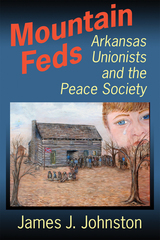 Mountain Feds: Arkansas Unionists and the Peace Society
James J. Johnston
Butler Center for Arkansas Studies, 2018 This is the fascinating story of the farmers and hill people from northern Arkansas, where slavery was not a big part of the local economy, who opposed the state’s secession from the Union.
In resistance to secession and to fighting for the Confederacy, they formed secret organizations—known commonly as the Arkansas Peace Society—and inaugurated their own leaders. Increased pressure from Richmond in the fall of 1861 for the Arkansas government to provide more soldiers pressed Arkansas’s yeomen farmers to enlist but only provided more incentive for the men to join the Arkansas Peace Society (later known as the Union League).
Many Arkansas communities forged home protective units or vigilance committees to protect themselves from slave uprisings and what they saw as federal invasion. Unionist mountaineers did the same, but their home protection organizations were secret because they were seeking protection from their secessionist neighbors and the state’s Confederate government.
In November 1861, the Arkansas Peace Society was first discovered in Clinton, Van Buren County, by the secessionist element, which rapidly formed vigilante committees to arrest and interrogate the suspects. The news and subsequent arrests spread to adjoining counties from the Arkansas River to the Missouri border. In most cases, the local militia was called out to handle the arrests and put down the rumored uprising.
While some Peace Society members fled to Missouri or hid in the woods, others were arrested and marched to Little Rock, where they were forced to join the Confederate army. Leaders who were prominent in the Peace Society recruited and led companies in Arkansas and Missouri Unionist regiments, returning to their homes to bring out loyalist refugees or to suppress Confederate guerrillas. A few of these home-grown leaders assumed leadership positions in civil government in the last months of the war, with the effects of their actions lingering for years to come.
 Mountain Geography: A Critique and Field Study
Roderick Peattie
Harvard University Press Since the problem of man’s adjustment to dramatic mountain conditions has been studied in greatest detail in Europe, Dr. Peattie’s volume will bring American geographers a large amount of novel information. It might be described as a compendium of principles, a first presentation of the comparative point of view. It is primarily a field study ranging from plane table or instrumental climatological study to reconnaissance among mountain cultures. Beyond this, however, it offers a compilation and critique of a broad literature together with the first classified and selected bibliography of works in its general field. Dr. Peattie’s conclusions emphasize the broad data of the theory of environmentalism and support the almost discarded idea of physical control in human culture. Although there is no attempt to preach determinism outside of catastrophes, nevertheless there is a definite plea made to American geographers to revive their interest in the importance of environment rather than confining themselves to man's part in reforming environment.
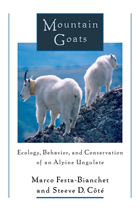 Mountain Goats: Ecology, Behavior, and Conservation of an Alpine Ungulate
Marco Festa-Bianchet and Steeve D. Côté
Island Press, 2007 Mountain goats have been among the least studied of North American ungulates, leaving wildlife managers with little information on which to base harvest strategies or conservation plans.
This book offers the first comprehensive assessment of the ecology and behavior of mountain goats, setting forth the results of a remarkable 16-year longitudinal study of more than 300 marked individuals in a population in Alberta, Canada. The authors’ thorough, long-term study allowed them to draw important conclusions about mountain goat ecology—including individual reproductive strategies, population dynamics, and sensitivity to human disturbance—and to use those conclusions in offering guidance for developing effective conservation strategies.
Chapters examine:
-habitat use, vegetation quality, and seasonal movements
-sexual segregation and social organization
-individual variability in yearly and lifetime reproductive success of females
-age- and sex-specific survival and dispersal
-reproductive strategies and population dynamics
-management and conservation of mountain goats
The book also draws on the rich literature on long-term monitoring of marked ungulates to explore similarities and differences between mountain goats and other species, particularly bighorn sheep and ibex.
By monitoring a marked population over a long period of time, researchers were able to document changes in sex-age structure and identify factors driving population dynamics. Because it explores the links between individual life-history strategy and population dynamics in a natural setting, Mountain Goats will be an invaluable resource for wildlife managers, researchers in ecology and animal behavior, conservationists, population biologists, and anyone concerned with the ecology and management of natural populations, especially in alpine environments.
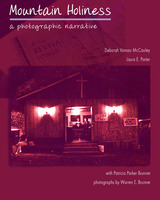 Mountain Holiness: A Photographic Narrative
Deborah Vansau Mccauley
University of Tennessee Press, 2003 “A remarkable achievement. Mountain Holiness combines Warren Brunner’s poignant and sensitive photographs with a succinct narrative by Deborah McCauley, the preeminent authority on Appalachian mountain religion. This is a landmark study that sheds light on one of the most neglected subjects in American religion.”—Randall Balmer, Ann Whitney Olin Professor of American Religion, Barnard College, Columbia University
Hidden deep in the hills of central Appalachia, tiny churches have quietly carried on their worship practices in an unbroken chain for two centuries. Harking back to the camp-meeting movement of the early nineteenth century, independent Holiness churches are considered by some to represent Appalachia's single largest religious tradition. Yet it is one that remains uncounted in any census of American church life because of the lack of formal institutions or written records. Through vivid images and perceptive words, this book documents this rich history, showing how these independent churches have sustained both faith and followers.
The authors spent five years interviewing and photographing Appalachia's Holiness people and participating in their services. From thousands of photographs, they have selected nearly three hundred fifty images for this large-format volume. Here are small one-room churches—many built to hold no more than a dozen people—scattered in the hills of Tennessee, Kentucky, Virginia, and West Virginia. Yet Warren Brunner's striking images depict not only buildings but also the people and their faith practices: river baptisms and homecomings, serpent handling and tent evangelism, radio preaching and special holiday services.
Deborah McCauley and Laura Porter's text combines descriptions of the pictures with the history of the churches and interviews with members. They create a representative window into the material and oral culture of central Appalachia's independent Holiness heritage. Mountain Holiness is a book that will fascinate anyone who cares about these traditions, as well as anyone concerned with the preservation of America's most vital folkways.
About the Authors: Deborah Vansau McCauley is a leading authority on
religion in Appalachia and is the author of Appalachian Mountain Religion: A History.
Laura E. Porter became familiar with Appalachian religion while pursuing a Master of Divinity degree at Union Theological Seminary; she is presently a computer consultant for religious and relief organizations.
Warren E. Brunner is a renowned photographer of Appalachia who has lived and worked in Berea, Kentucky, for nearly half a century. He has published three collections of photographs of the region. Patricia Parker Brunner, his wife, is an ordained Southern Baptist deacon who holds an M.A. in biblical studies.
Mountain Homespun
Frances Louisa Goodrich
University of Tennessee Press, 2010
“Mountain Homespun will be of special interest to those studying southern Appalachian handicrafts, the 1890s handicraft revival, and northern Protestant missionary work in turn-of-the-century Appalachia.” —North Carolina Historical Review
“Mountain Homespun is much more than a memoir. It offers unrivaled specific information on the processes of mountain crafts—not only on weaving, spinning, and dyeing, the author’s primary interest, but also on basketry, quilting, and other pursuits. All in all, the book is an important publishing event.”
—Berea College Newsletter
“This is a wonderful book. It belongs at the bedside of every spinner and weaver everywhere.” —Jude Daurelle, Handwoven
 The Mountain: Journeys in High Places
Robin Patten
University of Utah Press, 2025 Exploring the complex kinship between mountains and human thought, traditions, and ways of being
Since antiquity, mountains have captured the human imagination. The Mountain takes readers into higher realms, exploring the complex kinship between mountains and human thought, traditions, and ways of being. Told through the author’s own journeys, the narrative ranges across cultures and iconic naturalists to consider how varied ideas and experiences related to mountains—from sacred to scientific, romantic to retreat, to simply home—are all facets of the same intricate topography.
No matter where one starts on the spectrum of understanding, an intimate encounter with a mountain leads to a broader perspective. High places create a simultaneous humbleness at our human insignificance and a sense of belonging within the greater world. That quality of belonging, and the associated commitment of caring for the planet and all that it holds, has never been more important than it is today.
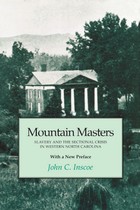 Mountain Masters: Slavery and the Sectional Crisis in Western North Carolina
John C. Inscoe
University of Tennessee Press, 1996 Antebellum Southern Appalachia has long been seen as a classless and essentially slaveless region - one so alienated and isolated from other parts of the South that, with the onset of the Civil War, highlanders opposed both secession and Confederate war efforts. In a multifaceted challenge to these basic assumptions about Appalachian society in the mid-nineteenth century, John Inscoe reveals new variations on the diverse motives and rationales that drove Southerners, particularly in the Upper South, out of the Union.
Mountain Masters vividly portrays the wealth, family connections, commercial activities, and governmental power of the slaveholding elite that controlled the social, economic, and political development of western North Carolina. In examining the role played by slavery in shaping the political consciousness of mountain residents, the book also provides fresh insights into the nature of southern class interaction, community structure, and master-slave relationships.
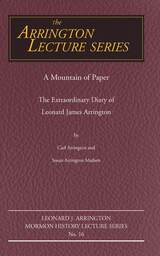 A Mountain of Paper: The Extraordinary Diary of Leonard James Arrington
Carl Arrington and Susan Arrington Madsen
Utah State University Press, 2012 The series, established by one of the twentieth-century West's most distinguished historians, Leonard Arrington, has become a leading forum for prominent historians to address topics related to Mormon history. The first lecturer was Arrington himself. He was followed by Richard Lyman Bushman, Richard E. Bennett, Howard R. Lamar, Claudia L. Bushman, Kenneth W. Godfrey, Jan Shipps, Donald Worster, Laurel Thatcher Ulrich, and F. Ross Peterson. Utah State University hosts the Leonard J. Arrington Mormon History Lecture Series. The University Libraries' Special Collections and Archives houses the Arrington collection. The state's land grant university began collecting records very early, and in the 1960s became a major depository for Utah and Mormon records. Leonard and his wife Grace joined the USU faculty and family in 1946, and the Arringtons and their colleagues worked to collect original diaries, journals, letters, and photographs. Although trained as an economist at the University of North Carolina, Arrington became a Mormon historian of international repute. Working with numerous colleagues, the Twin Falls, Idaho, native produced the classic Great Basin Kingdom: An Economic History of the Latter-day Saints in 1958. Utilizing available collections at USU, Arrington embarked on a prolific publishing and editing career. He and his close ally, Dr. S. George Ellsworth helped organize the Western History Association, and they created the Western Historical Quarterly as the scholarly voice of the WHA. While serving with Ellsworth as editor of the new journal, Arr ington also helped both the Mormon History Association and the independent journal Dialogue get established.
Mountain Path
Harriette Simpson Arnow
Michigan State University Press, 2012 Masterfully wrought and keenly observed, Mountain Path draws on Harriette Simpson Arnow’s experiences as a schoolteacher in downtrodden Pulaski County, Kentucky, deep in the heart of Appalachia, prior to WWII. Far from a quaint portrait of rural life, Arnow’s novel documents hardships, poverty, illiteracy, and struggles. She also recognizes a fragile cultural richness, one characterized by “those who like open fires, hounds, children, human talk and song instead of TV and radio, the wisdom of the old who had seen all of life from birth to death,” and which has since been eroded by the advent of highways and industry. In Mountain Path, Arnow exquisitely captures the voices, faces, and ways of a people she cared for deeply, and who evoked in her a deep respect and admiration.
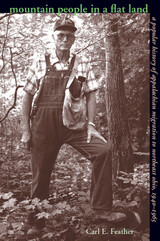 Mountain People in a Flat Land: A Popular History of Appalachian Migration to Northeast Ohio, 1940–1965
Carl E. Feather
Ohio University Press, 1998 In the early 1940s, $10 bought a bus ticket from Appalachia to a better job and promise of prosperity in the flatlands of northeast Ohio. A mountaineer with a strong back and will to work could find a job within twenty-four hours of arrival.
But the cost of a bus ticket was more than a week's wages in a lumber camp, and the mountaineer paid dearly in loss of kin, culture, homeplace, and freedom.
Numerous scholarly works have addressed this migration that brought more than one million mountaineers to Ohio alone. But Mountain People in a Flat Land is the first popular history of Appalachian migration to one community — Ashtabula County, an industrial center in the fabled “best location in the nation.”
These migrants share their stories of life in Appalachia before coming north. There are tales of making moonshine, colorful family members, home remedies harvested from the wild, and life in coal company towns and lumber camps.
The mountaineers explain why, despite the beauty of the mountains and the deep kinship roots, they had to leave Appalachia.
Stories of their hardships, cultural clashes, assimilation, and ultimate successes in the flatland provide a moving look at an often stereotyped people.
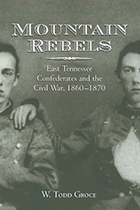 Mountain Rebels: East Tennessee Confederates 1860-1870
W. Todd Groce
University of Tennessee Press, 2000 “Groce offers a gracefully written, impressively researched narrative account of the experience of East Tennessee Confederates during the Civil War era. His analysis raises provocative questions about the socioeconomic foundations of Civil War sympathies in the Mountain South.”—Robert Tracy McKenzie, University of Washington
“Scholars of Appalachia’s Civil War have long awaited Todd Groce’s study of East Tennessee secessionists. I am pleased to report that this ground-breaking study of Southern Mountain Confederates was worth the wait.”—Kenneth Noe, State University of West Georgia
A bastion of Union support during the Civil War, East Tennessee was also home to Confederate sympathizers who took up the Southern cause until the bitter end. Yet historians have viewed these mountain rebels as scarcely different from other Confederates or as an aberration in the region's Unionism. Often they are simply ignored.
W. Todd Groce corrects this distorted view of East Tennessee's antebellum development and wartime struggle. He paints a clearer picture of the region’s Confederates than has previously been available, examining why they chose secession over union and revealing why they have become so invisible to us today. Drawing extensively on primary sources—newspapers, diaries, government reports—Groce allows the voices of these mountain rebels finally to be heard.
Groce explains the economic forces and the family and political ties to the Deep South that motivated the East Tennessee Confederates reluctantly to join the fight for Southern independence. Caught in a war they neither sought nor started, they were trapped between an unfriendly administration in Richmond and a hostile Union majority in their midst. When the fighting was over and they returned home to face their vengeful Unionist neighbors, many were forced to flee, contributing to the postwar economic decline of the region.
Placing the story in a broad context, Groce provides an overview of the region's economy and explains the social origins of secessionist sympathies. He also presents a collective profile of one hundred high-ranking Confederate officers from East Tennessee to show how they were representative of the rising commercial and financial leadership in the region.
Mountain Rebels intertwines economic, political, military, and social history to present a poignant tale of defeat, suffering, and banishment. By piecing together this previously untold story, it fills a void in Southern history, Civil War history, and Appalachian studies.
The Author: W. Todd Groce is executive director of the Georgia Historical Society.
Mountain River: Vietnamese Poetry from the Wars, 1948-1993
Kevin Bowen
University of Massachusetts Press, 1998 This bilingual collection affirms the importance of poetry in the formation and perpetuation of Vietnamese national identity. The poems testify to the centrality of war in Vietnamese history and experience over the past 50 years, beginning with Ho Chi Minh in the 1940s.
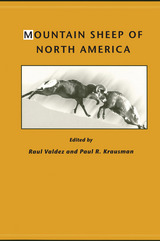 Mountain Sheep of North America
Raul Valdez
University of Arizona Press, 1999 Mountain sheep epitomize wilderness for many people because they occupy some of the most inaccessible and rugged habitats known to man, from desert crags to alpine mountains. But of all hoofed mammals in North America, wild sheep present the greatest management problems to biologists.
This book is a major reference on the natural history, ecology, and management of wild sheep in North America. Written by wildlife biologists who have devoted years of study to the animals, it covers Dall's and Stone's sheep and Rocky Mountain, California, and desert bighorn and examines a variety of factors pertinent to their life histories: habitat, diet, activity, social organization, reproduction, and population dynamics. Additional chapters consider distribution and abundance, adaptive strategies, and management guidelines. Discussions on diseases of wild sheep present a wealth of information that will be of particular use to wildlife biologists, including detailed clinical descriptions of conditions that threaten sheep populations, from pasteurellosis to capture myopathy. An appendix reviews the cytogenetics and genetics of wild sheep.
North American wild sheep may face extinction in many areas unless critical questions concerning their management are answered soon. Prior to the publication of this book, there was no single reference available in which one could find such a synthesis of information. Mountain Sheep of North America provides that source and points toward the preservation of these magnificent wild creatures.
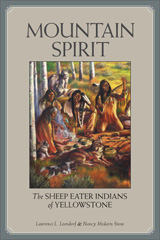 Mountain Spirit: The Sheep Eater Indians of Yellowstone
Loendorf, Lawrence L
University of Utah Press, 2006 There is still a pervasive notion that Indians did not inhabit the Yellowstone area. Drawing on the results of ongoing archaeological excavations and extensive ethnographic work among descendant native peoples, Mountain Spirit discusses the many groups that have in fact visited or lived in the area in prehistoric and historic times. In particular, the Shoshone group known as Tukudika, or Sheep Eaters, maintained a rich and abundant way of life closely related to their primary source of protein, the mountain sheep of the high-altitude Yellowstone area.
These robust people were talented artisans, making well-constructed shelters, powerful horn bows, and expertly tailored clothing that was highly sought by their trading partners. They moved in small, kin-based bands, accompanied by large dogs that were indispensable hunting and trekking companions. Moving seasonally through portions of the Beartooth, Absaroka, and Wind River ranges, the Sheep Eaters made skillful use of their environment.
Written for general readers, Mountain Spirit includes photographs, lithographs, and a number of color drawings and sketches of Sheep Eater life ways by Davíd Joaquin. It presents a vivid picture of the vanished way of life of a people whose accomplishments have been largely ignored in histories of Native peoples.
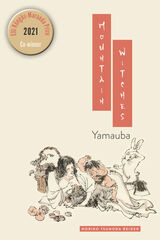 Mountain Witches: Yamauba
Noriko T. Reider
Utah State University Press, 2021 Mountain Witches is a comprehensive guide to the complex figure of yamauba—female yōkai often translated as mountain witches, who are commonly described as tall, enigmatic women with long hair, piercing eyes, and large mouths that open from ear to ear and who live in the mountains—and the evolution of their roles and significance in Japanese culture and society from the premodern era to the present. In recent years yamauba have attracted much attention among scholars of women’s literature as women unconstrained by conformative norms or social expectations, but this is the first book to demonstrate how these figures contribute to folklore, Japanese studies, cultural studies, and gender studies.
Situating the yamauba within the construct of yōkai and archetypes, Noriko T. Reider investigates the yamauba attributes through the examination of narratives including folktales, literary works, legends, modern fiction, manga, and anime. She traces the lineage of a yamauba image from the seventh-century text Kojiki to the streets of Shibuya, Tokyo, and explores its emergence as well as its various, often conflicting, characteristics. Reider also examines the adaptation and re-creation of the prototype in diverse media such as modern fiction, film, manga, anime, and fashion in relation to the changing status of women in Japanese society.
Offering a comprehensive overview of the development of the yamauba as a literary and mythic trope, Mountain Witches is a study of an archetype that endures in Japanese media and folklore. It will be valuable to students, scholars, and the general reader interested in folklore, Japanese literature, demonology, history, anthropology, cultural studies, gender studies, and the visual and performing arts.
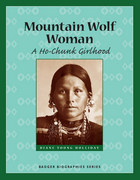 Mountain Wolf Woman: A Ho-Chunk Girlhood
Diane Holliday
Wisconsin Historical Society Press, 2007 With the seasons of the year as a backdrop, author Diane Holliday describes what life was like for a Ho-Chunk girl who lived in the late nineteenth and early twentieth century. Central to the story is the movement of Mountain Wolf Woman and her family in and around Wisconsin. Like many Ho-Chunk people in the mid-1800s, Mountain Wolf Woman's family was displaced to Nebraska by the U.S. government. They later returned to Wisconsin but continued to relocate throughout the state as the seasons changed to gather and hunt food. Based on her own autobiography as told to anthropologist Nancy Lurie, Mountain Wolf Woman's words are used throughout the book to capture her feelings and memories during childhood. Author Holliday draws young readers into this Badger Biographies series book by asking them to think about how the lives of their ancestors and how their lives today compare to the way Mountain Wolf Woman lived over a hundred years ago.
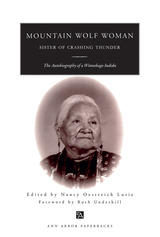 Mountain Wolf Woman, Sister of Crashing Thunder: The Autobiography of a Winnebago Indian
Nancy Oestreich Lurie, Editor
University of Michigan Press, 1961 From pony to airplane, from medicine dance to Christian worship, Mountain Wolf Woman, Sister of Crashing Thunder is the life story of a Winnebago woman, told in her own words to her adopted kinswoman, Nancy Lurie. This retelling of more than seventy-five years of Native American life is both a candid and compelling account of how one woman lived through a period of cultural crisis. Mountain Wolf Woman tells of her childhood in Wisconsin, her brief stay at a mission school, her marriage to "Bad Soldier," and her religious experiences with peyote. Her struggle to maintain her family against many hardships---odds that would have defeated a less vigorous and self-confident person---underscores her perseverance and tenacity. Whether she is describing her wanderings as a child or her misfortunes later in life, Mountain Wolf Woman sets forth her views in honest and perceptive terms, adding all the more power to her narrative. This book is a valuable companion to the story of Mountain Wolf Woman's brother, immortalized by Paul Radin in Crashing Thunder, a classic of anthropological literature. It will also be of interest to those interested in ethnographic records, the role of women in native cultures, and Midwestern Native Americans, in general. " . . . a superb human document."
---Chicago Sun-Times " . . . one of those rare books . . . ."
---Saturday Review ". . . a notable contribution to the literature of culture change and culture and personality."
---American Anthropologist
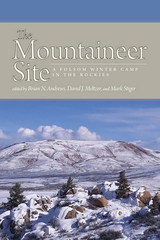 The Mountaineer Site: A Folsom Winter Camp in the Rockies
Brian N. Andrews
University Press of Colorado, 2022 The Mountaineer Site presents over a decade’s worth of archaeological research conducted at Mountaineer, a Paleoindian campsite in Colorado’s Upper Gunnison Basin. Mountaineer is one of the very few extensively excavated, long-term Folsom occupations with evidence of built structures. The site provides a rich record of stone tool manufacture and use, as well as architectural features, and offers insight into Folsom period adaptive strategies from a time when the region was still in the grip of a waning Ice Age.
Contributors examine data concerning the structures, the duration and repetition of occupations, and the nature of the site’s artifact assemblages to offer a valuable new perspective on human activity in the Rocky Mountains in the Late Pleistocene. Chapters survey the history of fieldwork at the site and compare and explain the various excavation procedures used; discuss the geology, taphonomic history, and geochronology of the site; analyze artifacts and other recovered materials; examine architectural elements; and compare the present and past environments of the Upper Gunnison Basin to gain insight into the setting in which Folsom groups were operating and the resources that were available to them.
The Folsom archaeological record indicates far greater variability in adaptive behavior than previously recognized in traditional models. The Mountaineer Site shows how accounting for reduced mobility, more generalized subsistence patterns, and variability in tool manufacture and use allows for a richer and more accurate understanding of Folsom lifeways. It will be of great interest to graduate students and archaeologists focusing on Paleoindian archaeology, hunter-gatherer mobility, lithic technological organization, and prehistoric households, as well as prehistorians, anthropologists, and social scientists.
Contributors: Richard J. Anderson, Andrew R. Boehm, Christy E. Briles, Katherine A. Cross, Steven D. Emslie, Metin I. Eren, Richard Gunst, Kalanka Jayalath, Brooke M. Morgan, Cathy Whitlock
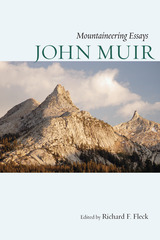 Mountaineering Essays
John Muir
University of Utah Press, 1997 One of the world’s foremost writers of the mountaineering essay—his writings are finely wrought expressions of the transcendental joy he found in the mountains—John Muir also founded the Sierra Club in 1892 as a way of supporting his belief that Americans must preserve national parks throughout the country in order that future generations might be spiritually inspired. Characterized by an iron endurance and an insatiable curiosity, Muir vowed to spend his days studying God’s unwritten Bible—nature—or what he termed the "University of the Wilderness." Muir early on learned to keep a journal in the manner of Emerson, but he is also considered one of America’s pioneer glaciologists, an interest he gained while wandering in Yosemite and the Sierra Nevada mountains. Whether frozen in a subzero blizzard on Mount Shasta, seemingly doomed on the unforgiving slopes of Mount Ritter, or exhilarated by the ice-shapes viewed from the summit of Mount Rainier, Muir reveled in the mountain experience. This volume contains eleven mountain essays that include both adventurous narrative, joyful exultation, and descriptions of natural features such as alpine soil beds, ancient glaciers and living glaciers, and mountain sculpture. In each, Muir maintains a careful and subtle balance between the physical aspects of ascending and the more symbolic observations of the sublimity of his surroundings. Mountains are for him a source of discovery that provide an affirmation of the human spirit.
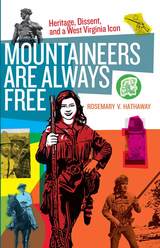 Mountaineers Are Always Free: Heritage, Dissent, and a West Virginia Icon
Rosemary V. Hathaway
West Virginia University Press, 2020 The West Virginia University Mountaineer is not just a mascot: it is a symbol of West Virginia history and identity embraced throughout the state. In this deeply informed but accessible study, folklorist Rosemary Hathaway explores the figure’s early history as a backwoods trickster, its deployment in emerging mass media, and finally its long and sometimes conflicted career—beginning officially in 1937—as the symbol of West Virginia University. Alternately a rabble-rouser and a romantic embodiment of the state’s history, the Mountaineer has been subject to ongoing reinterpretation while consistently conveying the value of independence. Hathaway’s account draws on multiple sources, including archival research, personal history, and interviews with former students who have portrayed the mascot, to explore the complex forces and tensions animating the Mountaineer figure. Often serving as a focus for white, masculinist, and Appalachian identities in particular, the Mountaineer that emerges from this study is something distinct from the hillbilly. Frontiersman and rebel both, the Mountaineer figure traditionally and energetically resists attempts (even those by the university) to tame or contain it.
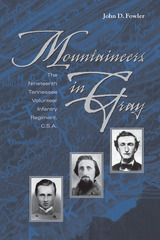 Mountaineers In Gray: The Nineteenth Tennessee Volunteer Infantry Regiment, C. S. A.
John D. Fowler
University of Tennessee Press, 2004 On April 26, 1865, on a farm just outside Durham, North Carolina, General Joseph E. Johnston surrendered the remnants of the Army of Tennessee to his longtime foe, General William T. Sherman. Johnston’s surrender ended the unrelenting Federal drive through the Carolinas and dashed any hope for Southern independence. Among the thirty thousand or so ragged Confederates who soon received their paroles were seventy-eight men from the Nineteenth Tennessee Volunteer Infantry Regiment. Originally consisting of over one thousand men, the unit had—through four years of sickness, injury, desertion, and death—been reduced to a tiny fraction of its former strength.
Organized from volunteer companies from the upper and lower portions of East Tennessee, the men of the Nineteenth represented an anomaly—Confederates in the midst of the largest Unionist stronghold of the South. Why these East Tennesseans chose to defy their neighbors, risking their lives and fortunes in pursuit of Southern independence, lacks a simple answer. John D. Fowler finds that a significant number of the Nineteenth’s members belonged to their region’s local elite—old, established families engaged in commercial farming or professional occupations. The influence of this elite, along with community pressure, kinship ties, fear of invasion, and a desire to protect republican liberty, generated Confederate sympathy amongst East Tennessee secessionists, including the members of the Nineteenth.
Utilizing an exhaustive exploration of primary source materials, the author creates a new model for future regimental histories—a model that goes beyond “bugles and bullets” to probe the motivations for enlistment, the socioeconomic backgrounds, the wartime experiences, and the postwar world of these unique Confederates. The Nineteenth served from the beginning of the conflict to its conclusion, marching and fighting in every major engagement of the Army of Tennessee except Perryville. Fowler uses this extensive service to explore the soldiers’ effectiveness as fighting men, the thrill and fear of combat, the harsh and often appalling conditions of camp life, the relentless attrition through disease, desertion, and death in battle, and the specter of defeat that haunted the Confederate forces in the West. This study also provides insight into the larger issues of Confederate leadership, strategy and tactics, medical care, prison life, the erosion of Confederate morale, and Southern class relations. The resulting picture of the war is gritty, real, and all too personal. If the Civil War is indeed a mosaic of “little wars,” this, then, is the Nineteenth’s war.
John D. Fowler is assistant professor of history at Kennesaw State University. He is the recipient of the Mrs. Simon Baruch University Award for the best manuscript in Civil War History (2002).
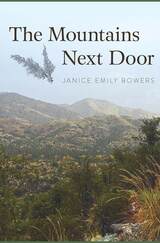 The Mountains Next Door
Janice Emily Bowers
University of Arizona Press, 1991 The Rincon Mountains east of Tucson are a small and seemingly undistinguished range; rounded and arid, they are more a site for foothill walks than serious exploring. Yet, upon close inspection, these unassuming mountains disclose many wonders and curiosities, as Janice Emily Bowers discovered while conducting a botanical study there. Over the course of two years, she made thirty-eight excursions into the Rincons—some for two or three days at a time—and garnered not only plant specimens but thoughts along the way. The Mountains Next Door is the first book to describe and celebrate the natural history of these mountains that even longtime Arizonans may often take for granted.
"I watched the seasons march through the canyons," writes Bowers, "followed the wildflower parade from February through November, and throughout it all realized that I could travel in the Rincon Mountains forever and never learn all they contained." It is also a book of meditations, as Bowers reflects upon the meaning of nature, the similarities between the scientific and creative processes, the value of wilderness in the face of urban encroachment, and other ideas. Participating in the long tradition of reflective natural history writing, she has produced a memorable book that depicts the delights and dilemmas of field botany as it explores the perennial struggle between science and mysticism that tugs at every naturalist's heart.
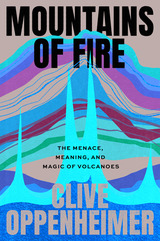 Mountains of Fire: The Menace, Meaning, and Magic of Volcanoes
Clive Oppenheimer
University of Chicago Press, 2023 Meeting with volcanoes around the world, a volcanologist interprets their messages for humankind.
In Mountains of Fire, Clive Oppenheimer invites readers to stand with him in the shadow of an active volcano. Whether he is scaling majestic summits, listening to hissing lava at the crater’s edge, or hunting for the far-flung ashes from Earth’s greatest eruptions, Oppenheimer is an ideal guide, offering readers the chance to tag along on the daring, seemingly-impossible journeys of a volcanologist.
In his eventful career as a volcanologist and filmmaker, Oppenheimer has studied volcanoes around the world. He has worked with scientists in North Korea to study Mount Paektu, a volcano name sung in national anthems on both sides of the Demilitarized Zone. He has crossed the Sahara to reach the fabled Tiéroko volcano in the Tibesti Mountains of Chad. He spent months camped atop Antarctica’s most active volcano, Mount Erebus, to record the pulse of its lava lake.
Mountains of Fire reveals how volcanic activity is entangled with our climate and environment, as well as our economy, politics, culture, and beliefs. These adventures and investigations make clear the dual purpose of volcanology—both to understand volcanoes for science’s sake and to serve the communities endangered and entranced by these mountains of fire.
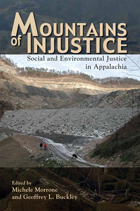 Mountains of Injustice: Social and Environmental Justice in Appalachia
Michele Morrone
Ohio University Press, 2011 Research in environmental justice reveals that low-income and minority neighborhoods in our nation’s cities are often the preferred sites for landfills, power plants, and polluting factories. Those who live in these sacrifice zones are forced to shoulder the burden of harmful environmental effects so that others can prosper. Mountains of Injustice broadens the discussion from the city to the country by focusing on the legacy of disproportionate environmental health impacts on communities in the Appalachian region, where the costs of cheap energy and cheap goods are actually quite high. Through compelling stories and interviews with people who are fighting for environmental justice, Mountains of Injustice contributes to the ongoing debate over how to equitably distribute the long-term environmental costs and consequences of economic development. Contributors:
Laura Allen, Brian Black, Geoffrey L. Buckley, Donald Edward Davis, Wren Kruse, Nancy Irwin Maxwell, Chad Montrie, Michele Morrone, Kathryn Newfont, John Nolt, Jedediah S. Purdy, and Stephen J. Scanlan.
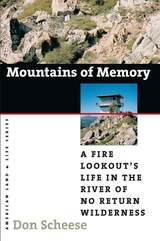 Mountains Of Memory: A Fire Lookout'S Life
Don Scheese
University of Iowa Press, 2001 In Mountains of Memory, seasoned wilderness dweller Don Scheese charts a long season of watching for and fighting fires in Idaho's River of No Return Wilderness&151the largest federal wilderness area in the mainland United States. An inspiring tale of self-discovery, Mountains of Memory paints a complex portrait of the natural, institutional, and historical forces that have shaped the great forested landscapes of the American West. A student of nature writing as well as a fire lookout with over a decade of experience, Scheese recounts his life at the top of the world, along with daring adventures such as backpacking and mountaineering in the Bighorn Crags and kayaking down the Middle Fork of the Salmon River. All the while, he touches upon the mysterious and powerful realities of the wilderness around him and stunning dawns visible within the glass cage perched on a 9,000-foot mountain, stirring flashes of lightning visible all around the dark landscape as the radio crackles with reports of strikes observed and fires spotted, long-awaited trips down the mountain to civilization for cold beer and hot pizza. In the tradition of Edward Abbey and Gary Snyder, Don Scheese offers readers a meditation on the meaning and value of wilderness at the beginning of the twenty-first century.
 Mountains of Music: West Virginia Traditional Music from Goldenseal
John Lilly
University of Illinois Press, 1999 From fiddle tunes to folk ballads, from banjos to blues, traditional music thrives in the remote mountains and hollers of West Virginia. For a quarter century, Goldenseal magazine has given its readers intimate access to the lives and music of folk artists from across this pivotal state. Now the best of Goldenseal is gathered for the first time in this richly illustrated volume. Some of the country's finest folklorists take us through the backwoods and into the homes of such artists as fiddlers Clark Kessinger and U.S. Senator Robert Byrd, recording stars Lynn Davis and Molly O'Day, dulcimer master Russell Fluharty, National Heritage Fellowship recipient Melvin Wine, bluesman Nat Reese, and banjoist Sylvia O'Brien.
The most complete survey to date of the vibrant strands of this music and its colorful practitioners, Mountains of Music delineates a unique culture where music and music making are part of an ancient and treasured heritage. The sly humor, strong faith, clear regional identity, and musical convictions of these performers draw the reader into families and communities bound by music from one generation to another. For devotees as well as newcomers to this infectiously joyous and heartfelt music, Mountains of Music captures the strength of tradition and the spontaneous power of living artistry.
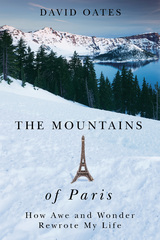 The Mountains of Paris: How Awe and Wonder Rewrote My Life
David Oates
Oregon State University Press, 2019 Living in Paris for a winter and a spring and waking each morning to a view of Notre Dame, David Oates is led to revise his life story from one of trudging and occasional woe into one punctuated by nourishing and sometimes unsettling brilliance. In The Mountains of Paris, he offers a technique of reimagining one’s life story that might be available to anyone.
The present tense of the book takes place during the seasons he spends in Paris, sharing an artist’s residency. It is a rare opportunity to consider what it means to be human, through time-stopping moments with music, art, and deep history. The past tense of the book offers memories that intrude into the bustle of Paris life: a Billy Graham crusade at age thirteen, a mountain pass, a love, a loss.
In long years of mountaineering Oates fought the self-loathing which had infused him as the gay kid in the Baptist pew. In The Mountains of Paris, he ascends to a place of wonder through intense, personal narrative encounter with the strangeness of being alive. In his searching, luminous, and inimitable prose, Oates invites readers to share the sense of awe awakened by a Vermeer painting, or the night sky, or the echoing strains of music fading down a Paris street, lifting the curtain on a cosmos filled with a terrifying yet beautiful rightness.
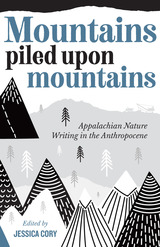 Mountains Piled upon Mountains: Appalachian Nature Writing in the Anthropocene
Jessica Cory
West Virginia University Press, 2019 Mountains Piled upon Mountains features nearly fifty writers from across Appalachia sharing their place-based fiction, literary nonfiction, and poetry. Moving beyond the tradition of transcendental nature writing, much of the work collected here engages current issues facing the region and the planet (such as hydraulic fracturing, water contamination, mountaintop removal, and deforestation), and provides readers with insights on the human-nature relationship in an era of rapid environmental change. This book includes a mix of new and recent creative work by established and emerging authors. The contributors write about experiences from northern Georgia to upstate New York, invite parallels between a watershed in West Virginia and one in North Carolina, and often emphasize connections between Appalachia and more distant locations. In the pages of Mountains Piled upon Mountains are celebration, mourning, confusion, loneliness, admiration, and other emotions and experiences rooted in place but transcending Appalachia’s boundaries.
Mountains Without Handrails: Reflections on the National Parks
Joseph L. Sax
University of Michigan Press, 1980 Focusing on the long-standing and bitter battles over recreational use of our national parklands, Joseph L. Sax proposes a novel scheme for the protection and management of America's national parks. Drawing upon the most controversial disputes of recent years---Yosemite National Park, the Colorado River in the Grand Canyon, and the Disney plan for California's Mineral King Valley---Sax boldly unites the rich and diverse tradition of nature writing into a coherent thesis that speaks directly to the dilemma of the parks.
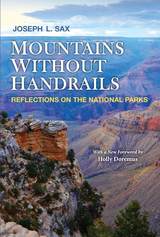 Mountains Without Handrails: Reflections on the National Parks
Joseph L. Sax
University of Michigan Press, 2018 Beloved by academic and general readers alike, Mountains Without Handrails, Joseph L. Sax’s thought-provoking treatise on America’s national parks, remains as relevant today as when first published in 1980. Focusing on the long-standing and bitter battles over recreational use of our parklands, Sax proposes a novel scheme for the protection and management of America's national parks. Drawing upon still controversial disputes—Yosemite National Park, the Colorado River in the Grand Canyon, and the Disney plan for California's Mineral King Valley—Sax boldly unites the rich and diverse tradition of nature writing into a coherent thesis that speaks directly to the dilemma of the parks.
In a new foreword, environmental law scholar Holly Doremus articulates this book’s enduring importance and reflects on what Sax, her former teacher, might have thought about the encroachment of technology into natural spaces, the impact of social media, and growing threats from climate change. At this moment of great uncertainty for the national parks, Mountains Without Handrails should be read (and re-read) by anyone with a stake in America’s natural spaces.
 Mountaintop Mining in Appalachia: Understanding Stakeholders and Change in Environmental Conflict
Susan F. Hirsch
Ohio University Press, 2014 Residents of the Appalachian coalfields share a history and heritage, deep connections to the land, and pride in their own resilience. These same residents are also profoundly divided over the practice of mountaintop mining—that is, the removal and disposal in nearby valleys of soil and rock in order to reach underlying coal seams. Companies and some miners claim that the practice has reduced energy prices, earned income for shareholders, and provided needed jobs. Opponents of mountaintop mining argue that it poisons Appalachia’s waters and devastates entire communities for the sake of short-term gains.
This conflict is emblematic of many other environmental disputes in the United States and around the world, disputes whose intensity derives not only from economic and environmental stakes but also from competing claims to individual and community identity. Looking beyond the slogans and seemingly irreconcilable differences, however, can reveal deeper causes of conflict, such as flawed institutions, politics, and inequality or the strongly held values of parties for whom compromise is difficult to achieve.
Mountaintop Mining in Appalachia focuses on the people of the region, the people who have the most at stake and have been the most active in trying to shift views and practices. By examining the experiences of these stakeholders and their efforts to effect change, Susan F. Hirsch and E. Franklin Dukes introduce key concepts and theories from the field of conflict analysis and resolution. They provide a compelling case study of how stakeholders challenge governance-as-usual, while offering insight into the causes of conflict over other environmental issues.
The Mountainway of the Navajo
Leland C. Wyman; with a myth of the Female Branch recorded and translated by Father Berard Haile, OFM
University of Arizona Press, 1975 Comprehensive examination of a Navajo song ceremonial and its various branches, phases, and ritual. Includes a myth of the female branch recorded and translated by Father Berard Haile, O.F.M., 32 illustrations of Mountainway sandpaintings, with detailed analysis of their symbols and designs.
Mounting Frustration: The Art Museum in the Age of Black Power
Susan E. Cahan
Duke University Press, 2015 In Mounting Frustration Susan E. Cahan uncovers the moment when the civil rights movement reached New York City's elite art galleries. Focusing on three controversial exhibitions that integrated African American culture and art, Cahan shows how the art world's racial politics is far more complicated than overcoming past exclusions.
 The Mourner: A Parker Novel
Richard Stark
University of Chicago Press, 2009 An action-packed crime novel starring Parker, the heister starring in the forthcoming Shane Black film Play Dirty!
Richard Stark's Parker novels are the hardest of hard-boiled, classic crime novels where the heists are huge, the body counts are high, and the bad guys usually win.
The Parker novels have been a huge influence on countless writers and filmmakers, including Quentin Tarantino, Stephen King, George Pelecanos, Colson Whitehead, Lucy Sante, John Banville, and many more. Their stripped-down language and hard-as-nails amorality create an unforgettable world where the next score could be the big one, but your next mistake could also be your last. There's nothing else like them.
The Mourner is a story of convergence—of cultures and of guys with guns. Hot on the trail of a statue stolen from a fifteenth-century French tomb, Parker enters a world of eccentric art collectors, greedy foreign officials, and shady KGB agents. Hired by a shifty dame who has something he needs, Parker will find out just who intends to bury whom—and who he needs to kill to finish the job.
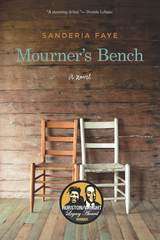 Mourner's Bench: A Novel
Sanderia Faye
University of Arkansas Press, 2015 At the First Baptist Church of Maeby, Arkansas, the sins of the child belonged to the parents until the child turned thirteen. Sarah Jones was only eight years old in the summer of 1964, but with her mother Esther Mae on eight prayer lists and flipping around town with the generally mistrusted civil rights organizers, Sarah believed it was time to get baptized and take responsibility for her own sins. That would mean sitting on the mourner’s bench come revival, waiting for her sign, and then testifying in front of the whole church.
But first, Sarah would need to navigate the growing tensions of small-town Arkansas in the 1960s. Both smarter and more serious than her years (a “fifty-year-old mind in an eight-year-old body,” according to Esther), Sarah was torn between the traditions, religion, and work ethic of her community and the progressive civil rights and feminist politics of her mother, who had recently returned from art school in Chicago. When organizers from the Student Non-Violent Coordinating Committee (SNCC) came to town just as the revival was beginning, Sarah couldn’t help but be caught up in the turmoil. Most folks just wanted to keep the peace, and Reverend Jefferson called the SNCC organizers “the evil among us.” But her mother, along with local civil rights activist Carrie Dilworth, the SNCC organizers, Daisy Bates, attorney John Walker, and indeed most of the country, seemed determined to push Maeby toward integration.
With characters as vibrant and evocative as their setting, Mourner’s Bench is the story of a young girl coming to terms with religion, racism, and feminism while also navigating the terrain of early adolescence and trying to settle into her place in her family and community.
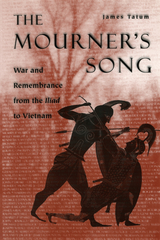 The Mourner's Song: War and Remembrance from the Iliad to Vietnam
James Tatum
University of Chicago Press, 2002 No matter when or where they are fought, all wars have one thing in common: a relentless progression to monuments and memorials for the dead. Likewise all art made from war begins and ends in mourning and remembrance. In The Mourner's Song, James Tatum offers incisive discussions of physical and literary memorials constructed in the wake of war, from the Vietnam Veterans Memorial to the writings of Stephen Crane, Edmund Wilson, Tim O'Brien, and Robert Lowell.
Tatum's touchstone throughout is the Iliad, not just one of the earliest war poems, but also one of the most powerful examples of the way poetry can be a tribute to and consolation for what is lost in war. Reading the Iliad alongside later works inspired by war, Tatum reveals how the forms and processes of art convert mourning to memorial. He examines the role of remembrance and the distance from war it requires; the significance of landscape in memorialization; the artifacts of war that fire the imagination; the intimate relationship between war and love and its effects on the ferocity with which soldiers wage battle; and finally, the idea of memorialization itself. Because all survivors suffer the losses of war, Tatum's is a story of both victims and victors, commanders and soldiers, women and men. Photographs of war memorials in Vietnam, France, and the United States beautifully augment his testimonials.
Eloquent and deeply moving, The Mourner's Song will speak to anyone interested in the literature of war and the relevance of the classics to our most pressing contemporary needs.
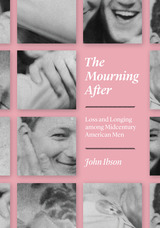 The Mourning After: Loss and Longing among Midcentury American Men
John Ibson
University of Chicago Press, 2018 On the battlefields of World War II, with their fellow soldiers as the only shield between life and death, a generation of American men found themselves connecting with each other in new and profound ways. Back home after the war, however, these intimacies faced both scorn and vicious homophobia. The Mourning After makes sense of this cruel irony, telling the story of the unmeasured toll exacted upon generations of male friendships. John Ibson draws evidence from the contrasting views of male closeness depicted in WWII-era fiction by Gore Vidal and John Horne Burns, as well as from such wide-ranging sources as psychiatry texts, child development books, the memoirs of veterans’ children, and a slew of vernacular snapshots of happy male couples. In this sweeping reinterpretation of the postwar years, Ibson argues that a prolonged mourning for tenderness lost lay at the core of midcentury American masculinity, leaving far too many men with an unspoken ache that continued long after the fighting stopped, forever damaging their relationships with their wives, their children, and each other.
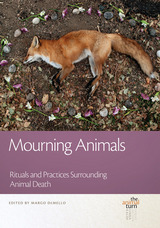 Mourning Animals: Rituals and Practices Surrounding Animal Death
Margo DeMello
Michigan State University Press, 2016 We live more intimately with nonhuman animals than ever before in history. The change in the way we cohabitate with animals can be seen in the way we treat them when they die. There is an almost infinite variety of ways to help us cope with the loss of our nonhuman friends—from burial, cremation, and taxidermy; to wearing or displaying the remains (ashes, fur, or other parts) of our deceased animals in jewelry, tattoos, or other artwork; to counselors who specialize in helping people mourn pets; to classes for veterinarians; to tips to help the surviving animals who are grieving their animal friends; to pet psychics and memorial websites. But the reality is that these practices, and related beliefs about animal souls or animal afterlife, generally only extend, with very few exceptions, to certain kinds of animals—pets. Most animals, in most cultures, are not mourned, and the question of an animal afterlife is not contemplated at all. Mourning Animals investigates how we mourn animal deaths, which animals are grievable, and what the implications are for all animals.
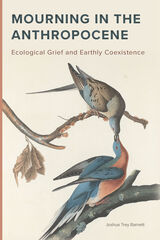 Mourning in the Anthropocene: Ecological Grief and Earthly Coexistence
Joshua Trey Barnett
Michigan State University Press, 2022 Enormous ecological losses and profound planetary transformations mean that ours is a time to grieve beyond the human. Yet, Joshua Trey Barnett argues in this eloquent and urgent book, our capacity to grieve for more-than-human others is neither natural nor inevitable. Weaving together personal narratives, theoretical meditations, and insightful readings of cultural artifacts, he suggests that ecological grief is best understood as a rhetorical achievement. As a collection of worldmaking practices, rhetoric makes things matter, bestows value, directs attention, generates knowledge, and foments feelings. By dwelling on three rhetorical practices—naming, archiving, and making visible—Barnett shows how they prepare us to grieve past, present, and future ecological losses. Simultaneously diagnostic and prescriptive, this book reveals rhetorical practices that set our ecological grief into motion and illuminates pathways to more connected, caring earthly coexistence.
Mourning Light
Richard Goodkin
University of Wisconsin Press, 2022 Set in Madison, Wisconsin, and New Haven, Connecticut, in the early days of the AIDS epidemic, Mourning Light is a semi-autobiographical love story. Our narrator, Reb (so named by his mother because of her love of the Daphne du Maurier novel Rebecca), is hounded by guilt over the death of his lover, Anthony, which took place on the same day Reb first met the handsome yet enigmatic Eric. Once Reb becomes convinced that Anthony has sent him a cryptic message from beyond the grave, he becomes obsessed with figuring out what it could mean.
Told in a series of flashbacks and remembrances, the novel concludes with a whirlwind of revelations that both complicate and resolve Reb’s view of his world and his lover.
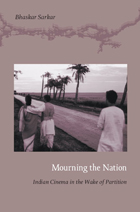 Mourning the Nation: Indian Cinema in the Wake of Partition
Bhaskar Sarkar
Duke University Press, 2009 What remains of the “national” when the nation unravels at the birth of the independent state? The political truncation of India at the end of British colonial rule in 1947 led to a social cataclysm in which roughly one million people died and ten to twelve million were displaced. Combining film studies, trauma theory, and South Asian cultural history, Bhaskar Sarkar follows the shifting traces of this event in Indian cinema over the next six decades. He argues that Partition remains a wound in the collective psyche of South Asia and that its representation on screen enables forms of historical engagement that are largely opaque to standard historiography. Sarkar tracks the initial reticence to engage with the trauma of 1947 and the subsequent emergence of a strong Partition discourse, revealing both the silence and the eventual “return of the repressed” as strands of one complex process. Connecting the relative silence of the early decades after Partition to a project of postcolonial nation-building and to trauma’s disjunctive temporal structure, Sarkar develops an allegorical reading of the silence as a form of mourning. He relates the proliferation of explicit Partition narratives in films made since the mid-1980s to disillusionment with post-independence achievements, and he discusses how current cinematic memorializations of 1947 are influenced by economic liberalization and the rise of a Hindu-chauvinist nationalism. Traversing Hindi and Bengali commercial cinema, art cinema, and television, Sarkar provides a history of Indian cinema that interrogates the national (a central category organizing cinema studies) and participates in a wider process of mourning the modernist promises of the nation form.
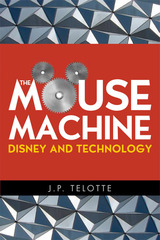 The Mouse Machine: Disney and Technology
J. P. Telotte
University of Illinois Press, 2007 Throughout Disney's phenomenally successful run in the entertainment industry, the company has negotiated the use of cutting-edge film and media technologies that, J. P. Telotte argues, have proven fundamental to the company's identity. Disney's technological developments include the use of stereophonic surround sound for Fantasia, experimentation with wide-screen technology, inaugural adoption of three-strip Technicolor film, and early efforts at fostering depth in the animated image. Telotte also chronicles Disney's partnership with television, development of the theme park, and depiction of technology in science fiction narratives. An in-depth discussion of Disney's shift into digital filmmaking with its Pixar partnership and an emphasis on digital special effects in live-action films, such as the Pirates of the Caribbean series, also highlight the studio's historical investment in technology. By exploring the technological context for Disney creations throughout its history, The Mouse Machine illuminates Disney's extraordinary growth into one of the largest and most influential media and entertainment companies in the world. Hardback is unjacketed.
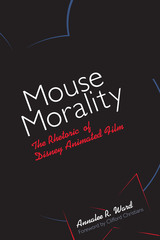 Mouse Morality: The Rhetoric of Disney Animated Film
By Annalee R. Ward
University of Texas Press, 2002 2004 – Clifford G. Christians Ethics Research Award — The Carl Couch Center for Social and Internet Research Kids around the world love Disney animated films, and many of their parents trust the Disney corporation to provide wholesome, moral entertainment for their children. Yet frequent protests and even boycotts of Disney products and practices reveal a widespread unease with the sometimes mixed and inconsistent moral values espoused in Disney films as the company attempts to appeal to the largest possible audience. In this book, Annalee R. Ward uses a variety of analytical tools based in rhetorical criticism to examine the moral messages taught in five recent Disney animated films—The Lion King, Pocahontas, The Hunchback of Notre Dame, Hercules, and Mulan. Taking the films on their own terms, she uncovers the many mixed messages they purvey: for example, females can be leaders—but male leadership ought to be the norm; stereotyping is wrong—but black means evil; historical truth is valued—but only tell what one can sell, etc. Adding these messages together, Ward raises important questions about the moral ambiguity of Disney's overall worldview and demonstrates the need for parents to be discerning in letting their children learn moral values and life lessons from Disney films.
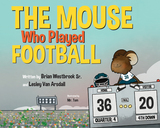 The Mouse Who Played Football
Written by Brian Westbrook Sr. and Lesley Van Arsdall
Temple University Press, 2022 Some folks think Brian the mouse is too small. He may be a tough little fella, but they are not sure Brian has what it takes. The Mouse Who Played Football, by former Philadelphia Eagles running back Brian Westbrook Sr. and sports reporter Lesley Van Arsdall, shows how Brian the mouse proves everyone wrong with unyielding confidence that his small size can be his strength. This charming children’s book, featuring appealing and dynamic illustrations by Mr. Tom, demonstrates how Brian the mouse overcomes what others see as a “big problem.” His determination—as well as speed and toughness on the gridiron—helps him become a star player in high school, college, and eventually, the MFL, the Mouse Football League. The Mouse Who Played Football, based on Westbrook’s own experiences,is an inspiring story that encourages young readers to believe in themselves and make their unique differences their strengths.
Mouth Filled with Night: Poems
Rodney Gomez
Northwestern University Press, 2014 The winner of the Drinking Gourd Chapbook Poetry Prize, Rodney Gomez’s collection Mouth Filled with Night employs familiar emblems of Mexican American identity to repeatedly subvert expectations while intensifying the dilemmas of affiliation. The poems run beyond more conventional ideas of agency, identity, and experience, creating a newly invigorated imaginative space. As a collection, Mouth Filled with Night gains particular momentum—a pitched anxiety that slowly grows throughout the volume—to create a poetic experience unique to the chapbook form.
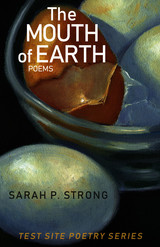 The Mouth of Earth: Poems
Sarah P. Strong
University of Nevada Press, 2020 In this timely and moving collection of poems, Sarah P. Strong explores what it means to live in a world undergoing an irrevocable transformation, the magnitude of which we barely comprehend. A broad range of perspectives shows us different times and places on Earth while unfolding the cyclical nature of human denial and response. A series of linked persona poems about the Dust Bowl recounts the destruction of the Great Plains and how human dreams of plenty destroyed the ancient fertility and stability of the land, how heartbreak and denial contended with bureaucratic insolence. In an imagined view of our planet as it might appear millennia from now, the Earth is "a worry stone / in the pocket of space, or a mood ring / on the finger of a newly minted / god."
The Mouth of Earth serves as both a survival guide for those seeking connection with our planet and one another as well as a compassionate tribute to what we have lost or are losing—the human consequences of such destruction in a time of climate crisis and lost connectivity. Strong’s powerful poems offer us, if not consolation, at least a way toward comprehension in an age of loss, revealing both our ongoing denial of our planet’s fragility and the compelling urgency of our hunger for connection with all life.
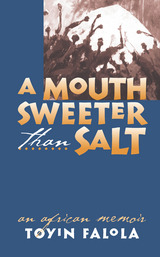 A Mouth Sweeter Than Salt: An African Memoir
Toyin Falola
University of Michigan Press, 2005 "Toyin Falola has given us what is truly rare in modern African writing: a seriously funny, racy, irreverent package of memories, and full of the most wonderful pieces of poetry and ordinary information. It is a matter of some interest, that the only other volume A Mouth Sweeter Than Salt reminds one of is Ake, by Wole Soyinka. What is it about these Yorubas?"
-Ama Ata Aidoo
"A splendid coming-of-age story so full of vivid color and emotion, the words seem to dance off the page. But this is not only Falola's memoir; it is an account of a new nation coming into being and the tensions and negotiations that invariably occur between city and country, tradition and modernity, men and women, rich and poor. A truly beautiful book."
-Robin D. G. Kelley
"More than a personal memoir, this book is a rich minihistory of contemporary Nigeria recorded in delicious detail by a perceptive eyewitness who grew up at the crossroads of many cultures."
-Bernth Lindfors
"The reader is irresistibly drawn into Falola's world. The prose is lucid. There is humor. This work is sweet. Period."
-Ngugi wa Thiongo'o
A Mouth Sweeter Than Salt gathers the stories and reflections of the early years of Toyin Falola, the grand historian of Africa and one of the greatest sons of Ibadan, the notable Yoruba city-state in Nigeria.
Redefining the autobiographical genre altogether, Falola miraculously weaves together personal, historical, and communal stories, along with political and cultural developments in the period immediately preceding and following Nigeria's independence, to give us a unique and enduring picture of the Yoruba in the mid-twentieth century. This is truly a literary memoir, told in language rich with proverbs, poetry, song, and humor.
Falola's memoir is far more than the story of one man's childhood experiences; rather, he presents us with the riches of an entire culture and community-its history, traditions, pleasures, mysteries, household arrangements, forms of power, struggles, and transformations.
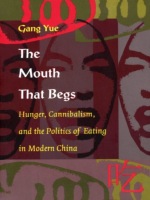 The Mouth That Begs: Hunger, Cannibalism, and the Politics of Eating in Modern China
Gang Yue
Duke University Press, 1999 The Chinese ideogram chi is far richer in connotation than the equivalent English verb “to eat.” Chi can also be read as “the mouth that begs for food and words.” A concept manifest in the twentieth-century Chinese political reality of revolution and massacre, chi suggests a narrative of desire that moves from lack to satiation and back again. In China such fundamental acts as eating or refusing to eat can carry enormous symbolic weight. This book examines the twentieth-century Chinese political experience as it is represented in literature through hunger, cooking, eating, and cannibalizing. At the core of Gang Yue’s argument lies the premise that the discourse surrounding the most universal of basic human acts—eating—is a culturally specific one. Yue’s discussion begins with a brief look at ancient Chinese alimentary writing and then moves on to its main concern: the exploration and textual analysis of themes of eating in modern Chinese literature from the May Fourth period through the post-Tiananmen era. The broad historical scope of this volume illustrates how widely applicable eating-related metaphors can be. For instance, Yue shows how cannibalism symbolizes old China under European colonization in the writing of Lu Xun. In Mo Yan’s 1992 novel Liquorland, however, cannibalism becomes the symbol of overindulgent consumerism. Yue considers other writers as well, such as Shen Congwen, Wang Ruowang, Lu Wenfu, Zhang Zianliang, Ah Cheng, Zheng Yi, and Liu Zhenyun. A special section devoted to women writers includes a chapter on Xiao Hong, Wang Anyi, and Li Ang, and another on the Chinese-American women writers Jade Snow Wong, Maxine Hong Kingston, and Amy Tan. Throughout, the author compares and contrasts the work of these writers with similarly themed Western literature, weaving a personal and political semiotics of eating. The Mouth That Begs will interest sinologists, literary critics, anthropologists, cultural studies scholars, and everyone curious about the semiotics of food.
The Mouths of Grazing Things
Jennifer Boyden
University of Wisconsin Press, 2010 The Mouths of Grazing Things is an unflinching, lyrical meditation on nature’s forced exodus from the human, and the forms of longing, estrangement, magnetism, and self-otherness that ensue. Arrestingly tender and fiercely protective of where nature lurks in and out of us still, Boyden translates for a new landscape where a brain in a jar is anchored by an apple, a fly-tying fisherman finds love songs to fish scattered among the barber’s sweepings, and the players at “the most dangerous playground in the world” prepare for anything with one fist clenched and the other full of sugar. In poems built to survive an unsafe journey, this book delivers the now-beyond, the almost-was, the near-forgotten, and the just-in-time.
 Movable Londons: Performance and the Modern City
Julia H Fawcett
University of Michigan Press, 2025 In September 1666, a fire sparked in a bakery on Pudding Lane grew until it had destroyed four-fifths of central London. The rebuilding efforts that followed not only launched the careers of some of London’s most famous architects, but also transformed Londoners’ relationship to their city by underscoring the ways that people could shape a city’s spaces—and the ways that a city’s spaces could shape its people. Movable Londons looks to the Restoration theater to understand how the dispossessed made London into a modern city after the Great Fire of 1666 and how the introduction of changeable scenery in theaters altered how Londoners conceptualized the city. Fawcett makes a claim for the centrality of unplanned spaces and the role of the Restoration theater in articulating those spaces as the modern city emerged and argues that movable scenery revolutionized London’s public theaters, inviting audiences to observe how the performers—many of them hailing from the same communities as their characters—navigated the stage.
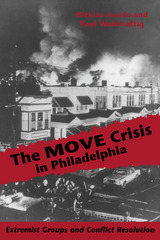 The MOVE Crisis In Philadelphia: Extremist Groups and Conflict Resolution
Hizkias Assefa
University of Pittsburgh Press, 1990
In 1985, police bombed the Philadelphia community occupied by members of the black counterculture group MOVE (short for “The Movement”). What began fifteen years earlier as a neighborhood squabble provoked by conflicting lifestyles ended in the destruction of sixty-one homes and the death of eleven residents - five of them children. Some 250 people were left homeless.
Was this tragedy the only solution to the conflict? Were John Africa and his morally and ecologically idealistic followers “too crazy” to negotiate with?
The authors interviewed MOVE members and their neighbors, third-party intervenors, and representatives of the Philadelpia administration in the 1970s, and draw on their own knowledge of the field of dispute resolution. More than simply describing a terrible event, they examine the dynamics of conflict, analyzing attempts at third-party mediation and the possibility of resolution without violence. Their analytical approach provides insight into other major conflicts, such as the problems of perception and misperception in U.S. - Iranian relations.
In an age when terrorism and hostage-taking are regular features on the six o’clock news, their questioning of traditional views on negotiation with “irrational” adversaries is especially important.
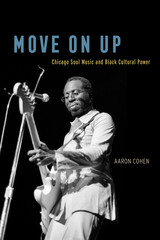 Move On Up: Chicago Soul Music and Black Cultural Power
Aaron Cohen
University of Chicago Press, 2019 A Chicago Tribune Book of 2019, Notable Chicago Reads
A Booklist Top 10 Arts Book of 2019
A No Depression Top Music Book of 2019
Curtis Mayfield. The Chi-Lites. Chaka Khan. Chicago’s place in the history of soul music is rock solid. But for Chicagoans, soul music in its heyday from the 1960s to the 1980s was more than just a series of hits: it was a marker and a source of black empowerment. In Move On Up, Aaron Cohen tells the remarkable story of the explosion of soul music in Chicago. Together, soul music and black-owned businesses thrived. Record producers and song-writers broadcast optimism for black America’s future through their sophisticated, jazz-inspired productions for the Dells and many others. Curtis Mayfield boldly sang of uplift with unmistakable grooves like “We’re a Winner” and “I Plan to Stay a Believer.” Musicians like Phil Cohran and the Pharaohs used their music to voice Afrocentric philosophies that challenged racism and segregation, while Maurice White of Earth, Wind, and Fire and Chaka Khan created music that inspired black consciousness. Soul music also accompanied the rise of African American advertisers and the campaign of Chicago’s first black mayor, Harold Washington, in 1983. This empowerment was set in stark relief by the social unrest roiling in Chicago and across the nation: as Chicago’s homegrown record labels produced rising stars singing songs of progress and freedom, Chicago’s black middle class faced limited economic opportunities and deep-seated segregation, all against a backdrop of nationwide deindustrialization.
Drawing on more than one hundred interviews and a music critic’s passion for the unmistakable Chicago soul sound, Cohen shows us how soul music became the voice of inspiration and change for a city in turmoil.
 Move, Play, Learn: Interactive Storytimes With Music, Movement, And More
Alyssa Jewell
American Library Association, 2020 Foreword by Jamie Campbell Naidoo Get ready to break out of your storytime routine by encouraging children’s natural instincts to move, sing, and play! Unlike traditional storytimes, where children are expected to sit quietly and just watch, music and movement storytimes encourage children to learn by getting inside stories while interacting with others. Research shows that this kind of play stimulates the senses, provides connections to all four lobes of the brain, touches on a variety of intelligences, and heightens social and emotional awareness—all while extending the early literacy practices of Every Child Ready to Read® and preparing children for school. And because there are no crafts to cut out, no snacks to pack, no scripts to memorize, and no story kits to make, it’s one of the simplest, most cost-effective storytime models to implement. Jewell’s complete guide shows the way, offering - 20 ready-to-use storytime plans tailored to specific age groups, including babies, toddlers, preschool and all-ages programs, a real time-saver for storytime organizers and presenters;
- advice and best practices gleaned from interviews with professionals who specialize in storytimes, music making with children and families, yoga storytime, and drama education; and
- lists of recommended resources, from interactive print books to children’s music and videos available digitally, with tips on choosing the best materials.
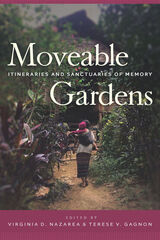 Moveable Gardens: Itineraries and Sanctuaries of Memory
Edited by Virginia D. Nazarea and Terese V. Gagnon
University of Arizona Press, 2021 Moveable Gardens explores how biodiversity and food can counter the alienation caused by displacement. By offering in-depth studies on a variety of regions, this volume carefully considers various forms of sanctuary making within communities, and seeks to address how carrying seeds, plants, and other traveling companions is an ongoing response to the grave conditions of displacement in today’s world. The destruction of homelands, fragmentation of habitats, and post-capitalist conditions of modernity are countered by thoughtful remembrance of tradition and the migration of seeds, which are embodied in gardening, cooking, and community building.
Moveable Gardens highlights itineraries and sanctuaries in an era of massive dislocation, addressing concerns about finding comforting and familiar refuges in the Anthropocene. The worlds of marginalized individuals who live in impoverished rural communities, many Indigenous peoples, and refugees are constantly under threat of fracturing. Yet, in every case, there is resilience and regeneration as these individuals re-create their worlds through the foods, traditions, and plants they carry with them into their new realities.
This volume offers a new understanding of the performances and routines of sociality in the face of daunting market forces and perilous climate transformations. These traditions sustained our ancestors, and they may suffice to secure a more meaningful, diverse future. By delving into the nature of nostalgia, burrowing into memory and knowledge, and embracing the specific wonders of each deeply rooted or newly displaced community, endlessly valuable ways of being and understanding can be preserved.
Contributors: Guntra A. Aistara, Aida Curtis, Terese V. Gagnon, John Hartigan Jr., Tracey Heatherington, Taylor Hosmer, Hayden S. Kantor, Melanie Narciso, Virginia D. Nazarea, Emily F. Ramsey, Krishnendu Ray, David Sutton, James R. Veteto, Marc N. Williams
 A Moveable Shore: The Fate of the Connecticut Coast
Peter C. Patton and James M. Kent
Duke University Press, 1992 The Connecticut shoreline is made up of varying landscapes--the sandy coastline at Madison, the rocky shore at Branford, the replenished beach at Greenwich, and the erosion at Old Saybrook. A Moveable Shore offers a general user’s guide to the Connecticut shore. In a town-by-town journey down the 254-mile coastline, Peter C. Patton and James M. Kent explore in detail the history of specific sites, the climatic and geological forces that shape the shore, and regulations regarding land-use development. In addition, they provide a guide to coastal field trips.
Beginning with the hurricane of 1938, the biggest natural disaster to strike Connecticut since its settlement by Europeans, the authors demonstrate the continuing pattern of development of coastal land prone to flooding and high winds. Although the Connecticut coast faces Long Island and Block Island sounds, it is subject to the same natural hazards, land-use risks, and regulations as opean ocean shorelines. Global climatic events--glaciation, global warming, and rising sea levels--influence the shape and composition of the Connecticut shoreline, as do small-scale forces such as wind, waves, and tides.
Patton and Kent seek to instill a respect for the force of natural events and provide a guide for lessening the dangers of construction and development. A practical question-and-answer chapter explains what homeowners need to know to meet land-use regulations along the coast. In a state where the entire population lives within 100 miles of the coast, this important book will serve as a citizens’ guide to living with the Connecticut shore and will be of interest to coastal residents, developers, geologists, policymakers, and vacationers.
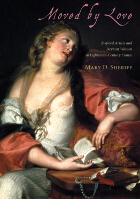 Moved by Love: Inspired Artists and Deviant Women in Eighteenth-Century France
Mary D. Sheriff
University of Chicago Press, 2004 In eighteenth-century France, the ability to lose oneself in a character or scene marked both great artists and ideal spectators. Yet it was thought this same passionate enthusiasm, if taken to unreasonable extremes, could also lead to sexual deviance, mental illness—even death. Women and artists were seen as especially susceptible to these negative consequences of creative enthusiasm, and women artists, doubly so.
Mary D. Sheriff uses these very different visions of enthusiasm to explore the complex interrelationships among creativity, sexuality, the body and the mind in eighteenth-century France. Drawing on evidence from the visual arts, literature, philosophy, and medicine, she portrays the deviance ascribed to both inspired men and women. But while various mythologies worked to normalize deviance in male artists, women had no justification for their deviance. For instance, the mythical sculptor Pygmalion was cured of an abnormal love for his statue through the making of art. He became a model for creative artists, living happily with his statue come to life. No happy endings, though, were imagined for such inspired women writers as Sappho and Heloise, who burned with erotomania their art could not quench. Even so, Sheriff demonstrates, the perceived connections among sexuality, creativity, and disease also opened artistic opportunities for creative women took full advantage of them.
Brilliantly reassessing the links between sexuality and creativity, artistic genius and madness, passion and reason, Moved by Love will profoundly reshape our view of eighteenth- century French culture.
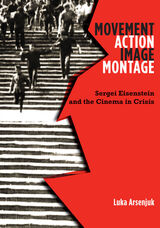 Movement, Action, Image, Montage: Sergei Eisenstein and the Cinema in Crisis
Luka Arsenjuk
University of Minnesota Press, 2018 A major new study of Sergei Eisenstein delivers fresh, in-depth analyses of the iconic filmmaker’s body of work
What can we still learn from Sergei Eisenstein? Long valorized as the essential filmmaker of the Russian Revolution and celebrated for his indispensable contributions to cinematic technique, Eisenstein’s relevance to contemporary culture is far from exhausted. In Movement, Action, Image, Montage, Luka Arsenjuk considers the auteur as a filmmaker and a theorist, drawing on philosophers such as Georg Wilhelm Friedrich Hegel and Gilles Deleuze—as well as Eisenstein’s own untranslated texts—to reframe the way we think about the great director and his legacy. Focusing on Eisenstein’s unique treatment of the foundational concepts of cinema—movement, action, image, and montage—Arsenjuk invests each aspect of the auteur’s art with new significance for the twenty-first century. Eisenstein’s work and thought, he argues, belong as much to the future as the past, and both can offer novel contributions to long-standing cinematic questions and debates. Movement, Action, Image, Montage brings new elements of Eisenstein’s output into academic consideration, by means ranging from sustained and comprehensive theorization of Eisenstein’s practice as a graphic artist to purposeful engagement with his recently published, unfinished book Method, still unavailable in English translation. This tour de force offers new and significant insights on Eisenstein’s oeuvre—the films, the art, and the theory—and is a landmark work on an essential filmmaker.
Movement and Modernism: Yeats, Eliot, Williams, and Early Twentieth-Century Dance
Terri A. Mester
University of Arkansas Press, 1997 In this critical study, Terri Mester makes solid biographic, thematic, technical, and figurative cases that W. B. Yeats, T. S. Eliot, D. H. Lawrence, and William Carlos Williams turned to dance and dancers—actual and mythic—to reinvigorate their literary practices.
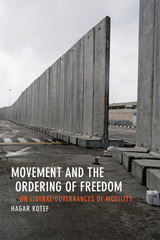 Movement and the Ordering of Freedom: On Liberal Governances of Mobility
Hagar Kotef
Duke University Press, 2015 We live within political systems that increasingly seek to control movement, organized around both the desire and ability to determine who is permitted to enter what sorts of spaces, from gated communities to nation-states. In Movement and the Ordering of Freedom, Hagar Kotef examines the roles of mobility and immobility in the history of political thought and the structuring of political spaces. Ranging from the writings of Locke, Hobbes, and Mill to the sophisticated technologies of control that circumscribe the lives of Palestinians in the Occupied West Bank, this book shows how concepts of freedom, security, and violence take form and find justification via “regimes of movement.” Kotef traces contemporary structures of global (im)mobility and resistance to the schism in liberal political theory, which embodied the idea of “liberty” in movement while simultaneously regulating mobility according to a racial, classed, and gendered matrix of exclusions.
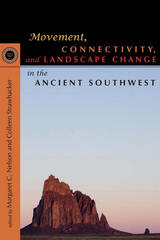 Movement, Connectivity, and Landscape Change in the Ancient Southwest
Margaret C. Nelson
University Press of Colorado, 2011 A collection of the papers presented at the Twentieth Anniversary Southwest Symposium, Movement, Connectivity, and Landscape Change in the Ancient Southwest looks back at the issues raised in the first symposium in 1988 and tackles three contemporary domains in archaeology: landscape use and ecological change, movement and ethnogenesis, and connectivity among social groups through time and space. Across these sections the authors address the relevance of archaeology in the modern world; new approaches and concerns about collaboration across disciplines, communities, and subgroups; and the importance of multiple perspectives.
Particular attention is paid to the various ways that archaeology can and should contribute to contemporary social and environmental issues. Contributors come together to provide a synthetic volume on current research and possibilities for future explorations. Moving forward, they argue that archaeologists must continue to include researchers from across political and disciplinary boundaries and enhance collaboration with Native American groups.
This book will be of interest to professional and academic archaeologists, as well as students working in the field of the American Southwest.
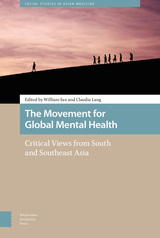 The Movement for Global Mental Health: Critical Views from South and Southeast Asia
William Sax
Amsterdam University Press, 2021 In The Movement for Global Mental Health: Critical Views from South and Southeast Asia, prominent anthropologists, public health physicians, and psychiatrists respond sympathetically but critically to the Movement for Global Mental Health (MGMH). They question some of its fundamental assumptions: the idea that "mental disorders" can clearly be identified; that they are primarily of biological origin; that the world is currently facing an "epidemic" of them; that the most appropriate treatments for them normally involve psycho-pharmaceutical drugs; and that local or indigenous therapies are of little interest or importance for treating them. The contributors argue that, on the contrary, defining "mental disorders" is difficult and culturally variable; that social and biographical factors are often important causes of them; that the "epidemic" of mental disorders may be an effect of new ways of measuring them; and that the countries of South and Southeast Asia have abundant, though non-psychiatric, resources for dealing with them. In short, they advocate a thoroughgoing mental health pluralism.
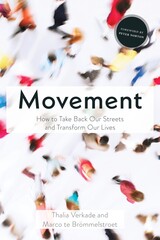 Movement: How to Take Back Our Streets and Transform Our Lives
Thalia Verkade and Marco te Brömmelstroet
Island Press, 2024 “This book will—no question—make you think in new ways. Why have we surrendered our cities to cars? What might it be like to inhabit a space designed for people instead? It’s exciting and hopeful—this we can do!”
—Bill McKibben, author of The Flag, The Cross, and the Station Wagon
Almost everywhere in the world, streets are designed for travel at the highest speed, giving precedence to the chunkiest vehicles. We take for granted that the streets outside of our homes are designed only for movement from one point to another. But what happens if we radically rethink how we use these public spaces? Could we change our lives for the better?
In Movement: How to Take Back Our Streets and Transform Our Lives, journalist Thalia Verkade and mobility expert (“the cycling professor”) Marco te Brömmelstroet take a three-year shared journey of discovery into the possibilities of our streets. They investigate and question the choices and mechanisms underpinning how these public spaces are designed and look at how they could be different. Verkade and te Brömmelstroet draw inspiration from the Netherlands and look at what other countries are doing, and could do, to diversify how they use their streets and make them safer.
During the pandemic, decision-makers in cities around the world were confronted with the questions of who our streets belong to, how we want to use them, and who gets to decide. Making our communities safer, cleaner, and greener starts with asking these fundamental questions. To truly transform mobility, we need to look far beyond the technical aspects and put people at the center of urban design. Movement will change the way that you view our streets.
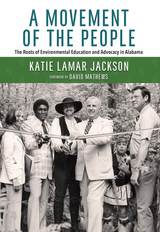 A Movement of the People: The Roots of Environmental Education and Advocacy in Alabama
Katie Lamar Jackson, Foreword by David Mathews
University of Alabama Press, 2017 How a grassroots movement led primarily by women shaped Alabama’s environmental consciousness.
A Movement of the People: The Roots of Environmental Education and Advocacy in Alabama is a detailed history of the Alabama Environmental Quality Association (AEQA). The AEQA helped to establish groundbreaking environmental protection and natural resource preservation policies for the state and the region and grew into one of the nation’s most progressive environmental education efforts.
The AEQA began in 1966 with the relatively simple political action agenda of cleaning up unsightly and unsanitary roadside trash. These inspired citizens collaborated with civic leaders to identify and remove illegal rural dumps and create more regulated landfills statewide. Eventually they became involved in the “Keep America Beautiful” campaign and with the US Public Health Service in its attempt to rid the state of the yellow-fever mosquito vector, Aedes aegypti, which breeds in standing, fetid water. The acme of these early efforts was the passage of Alabama’s Solid Waste Disposal Law of 1969, one of the nation’s first such bills.
The AEQA’s dedicated staff and supporters spearheaded other environmental projects, many of which remain active today, such as recycling programs with industry giants throughout the Southeast and the founding of the Bartram Trail Conference, a multistate initiative to identify and preserve the path that Quaker botanist William Bartram took through the territory before its formation into states.
Using recorded interviews with Martha McInnis, executive vice president of the AEQA, and full access to a meticulously preserved archive of the organization’s papers and artifacts, Katie Lamar Jackson relates this previously untold story of remarkable “citizen activism.” A Movementof the People is a valuable account of the organization’s growth and advancement, both economically and societally, which serves as a blueprint for successful civic activism and grassroots organizing.
The Movement of World Revolution
Christopher Dawson
Catholic University of America Press, 2013 The Movement of World Revolution, originally published in 1959, explores many of the themes Dawson considered most important in his lifetime: the religious foundation of human culture, the central importance of education for the recovery of Christian humanism, the myth of progress, and the dangers of nationalism and secular ideologies.
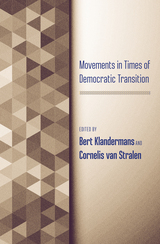 Movements in Times of Democratic Transition
Bert Klandermans
Temple University Press, 2015 In regions that have undergone tumultuous transitions, democratic social movements have often been the catalyst for great change. However, once those changes occur, can these movements survive, and if so, how?
The editors and contributors to Movements in Times of Democratic Transition examine in comparative detail how social movements act within the context of the democratic transitions they have been fighting for, and how they are affected by the changes they helped bring about. Offering insights into the nature of how social movements decline, radicalize, revitalize, or spark new cycles of activism, Movements in Times of Democratic Transition provides a comprehensive analysis of these key questions of mobilization research.
Contributors include: Paul Almeida, Christopher J. Colvin, Stephen Ellis, Grzegorz Ekiert, Grzegorz Forys, Krzysztof Gorlach, Camila Penna, Sebastián Pereyra, Steven Robbins, Ton Salman, Mate Szabo, Ineke van Kessel, Michal Wenzel, and the editors.
 Movements of Air: The Photographs from Étienne-Jules Marey’s Wind Tunnels
Georges Didi-Huberman and Laurent Mannoni
Diaphanes, 2022 Two important essays on Étienne-Jules Marey published for the first time in English alongside his breathtaking images of moving air and smoke.
Featuring more than one hundred and fifty photographs and images, Movements of Air reprints the breathtaking pictures of Étienne-Jules Marey—images captured between 1899 and 1901 during his scientific experiments with moving air and smoke—and complements them with essays by Georges Didi-Huberman and Laurent Mannoni.
Mannoni begins by reflecting on Marey’s experimental approach. As the founder of the “graphic method,” Marey was also the developer of an aerodynamic wind tunnel. His experiments’ photographs of fluid motion introduced a whole world of movements and turbulences, and fluids, and influenced generations of scientists and artists alike. Didi-Huberman expands on the philosophical debates surrounding these aesthetically and technically instructive images. Even though Marey’s main interest was graphic information, Didi-Huberman shows us how the flow of all things drew this ingenious experimenter to a photographic practice that creates drags, streaks, expansions, and visual dances. Marey’s wind tunnel photographs were also themselves causes of turbulence in the history of images. The artists Dombois and Oeschger explore these “graphical” vortices of the last 120 years, providing at the end of the book a collage from historical and contemporary material interlaced with their own image-making in Dombois’s wind tunnel at the Zurich University of the Arts.
Movie Circuits: Curatorial Approaches to Cinema Technology
Gabriel Menotti
Amsterdam University Press, 2019 Movie Circuits: Curatorial Approaches to Cinema Technology attempts to grasp media in the making. It delves into the underbelly of cinema in order to explore how images circulate and apparatus crystallize across different material formations. The indisciplinary experience of curators and projectionists provides a means to suspend traditional film studies and engage with the medium as it happens, as a continuing, self-differing mess. From contemporary art exhibitions to pirate screenings, research and practice come together in a vibrant form of media scholarship, built from the angle of cinema’s functionaries — a call to reinvent the medium from within.
 Movie Comics: Page to Screen/Screen to Page
Davis, Blair
Rutgers University Press, 2017 As Christopher Nolan’s Batman films and releases from the Marvel Cinematic Universe have regularly topped the box office charts, fans and critics alike might assume that the “comic book movie” is a distinctly twenty-first-century form. Yet adaptations of comics have been an integral part of American cinema from its very inception, with comics characters regularly leaping from the page to the screen and cinematic icons spawning comics of their own. Movie Comics is the first book to study the long history of both comics-to-film and film-to-comics adaptations, covering everything from silent films starring Happy Hooligan to sound films and serials featuring Dick Tracy and Superman to comic books starring John Wayne, Gene Autry, Bob Hope, Abbott & Costello, Alan Ladd, and Dean Martin and Jerry Lewis. With a special focus on the Classical Hollywood era, Blair Davis investigates the factors that spurred this media convergence, as the film and comics industries joined forces to expand the reach of their various brands. While analyzing this production history, he also tracks the artistic coevolution of films and comics, considering the many formal elements that each medium adopted and adapted from the other. As it explores our abiding desire to experience the same characters and stories in multiple forms, Movie Comics gives readers a new appreciation for the unique qualities of the illustrated page and the cinematic moving image.
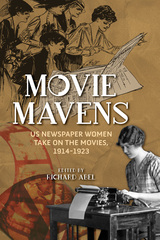 Movie Mavens: US Newspaper Women Take On the Movies, 1914-1923
Edited by Richard Abel
University of Illinois Press, 2021 During the early era of cinema, moviegoers turned to women editors and writers for the latest on everyone's favorite stars, films, and filmmakers. Richard Abel returns these women to film history with an anthology of reviews, articles, and other works. Drawn from newspapers of the time, the selections show how columnists like Kitty Kelly, Mae Tinee, Louella Parsons, and Genevieve Harris wrote directly to female readers. They also profiled women working in jobs like scenario writer and film editor and noted the industry's willingness to hire women. Sharp wit and frank opinions entertained and informed a wide readership hungry for news about the movies but also about women on both sides of the camera. Abel supplements the texts with hard-to-find biographical information and provides context on the newspapers and silent-era movie industry as well as on the professionals and films highlighted by these writers. An invaluable collection of rare archival sources, Movie Mavens reveals women's essential contribution to the creation of American film culture.
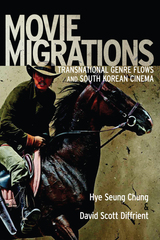 Movie Migrations: Transnational Genre Flows and South Korean Cinema
Hye Seung Chung and David Scott Diffrient
Rutgers University Press, 2015 As the two billion YouTube views for “Gangnam Style” would indicate, South Korean popular culture has begun to enjoy new prominence on the global stage. Yet, as this timely new study reveals, the nation’s film industry has long been a hub for transnational exchange, producing movies that put a unique spin on familiar genres, while influencing world cinema from Hollywood to Bollywood. Movie Migrations is not only an introduction to one of the world’s most vibrant national cinemas, but also a provocative call to reimagine the very concepts of “national cinemas” and “film genre.” Challenging traditional critical assumptions that place Hollywood at the center of genre production, Hye Seung Chung and David Scott Diffrient bring South Korean cinema to the forefront of recent and ongoing debates about globalization and transnationalism. In each chapter they track a different way that South Korean filmmakers have adapted material from foreign sources, resulting in everything from the Manchurian Western to The Host’s reinvention of the Godzilla mythos. Spanning a wide range of genres, the book introduces readers to classics from the 1950s and 1960s Golden Age of South Korean cinema, while offering fresh perspectives on recent favorites like Oldboy and Thirst. Perfect not only for fans of Korean film, but for anyone curious about media in an era of globalization, Movie Migrations will give readers a new appreciation for the creative act of cross-cultural adaptation.
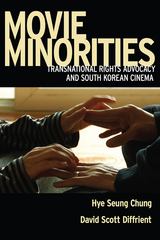 Movie Minorities: Transnational Rights Advocacy and South Korean Cinema
Hye Seung Chung and David Scott Diffrient
Rutgers University Press, 2021 Rights advocacy has become a prominent facet of South Korea’s increasingly transnational motion picture output, especially following the 1998 presidential inauguration of Kim Dae-jung, a former political prisoner and victim of human rights abuses who received the Nobel Peace Prize in 2000. Today it is not unusual to see a big-budget production about the pursuit of social justice or the protection of civil liberties contending for the top spot at the box office. With that cultural shift has come a diversification of film subjects, which range from undocumented workers’ rights to the sexual harassment experienced by women to high-school bullying to the struggles among people with disabilities to gain inclusion within a society that has transformed significantly since winning democratic freedoms three decades ago. Combining in-depth textual analyses of films such as Bleak Night, Okja, Planet of Snail, Repatriation, and Silenced with broader historical contextualization, Movie Minorities offers the first English-language study of South Korean cinema’s role in helping to galvanize activist social movements across several identity-based categories.
The Movie Musical
Desirée J. Garcia
Rutgers University Press, 2021 Putting Asian and European musicals into conversation with Hollywood classics like Singin’ in the Rain and La La Land, this study demonstrates the flexibility and durability of the genre. It explores how the movie musical mediates between nostalgia and technical innovation, while foregrounding the experiences of women, immigrants, and people of color.
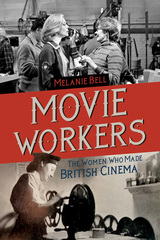 Movie Workers: The Women Who Made British Cinema
Melanie Bell
University of Illinois Press, 2021 Winner of the Theatre Library Association’s Richard Wall Memorial Award Special Jury Prize for an exemplary work in the field of recorded performance After the advent of sound, women in the British film industry formed an essential corps of below-the-line workers, laboring in positions from animation artist to negative cutter to costume designer. Melanie Bell maps the work of these women decade-by-decade, examining their far-ranging economic and creative contributions against the backdrop of the discrimination that constrained their careers. Her use of oral histories and trade union records presents a vivid counter-narrative to film history, one that focuses not only on women in a male-dominated business, but on the innumerable types of physical and emotional labor required to make a motion picture. Bell's feminist analysis looks at women's jobs in film at important historical junctures while situating the work in the context of changing expectations around women and gender roles. Illuminating and astute, Movie Workers is a first-of-its-kind examination of the unsung women whose invisible work brought British filmmaking to the screen.
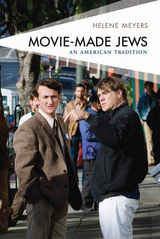 Movie-Made Jews: An American Tradition
Helene Meyers
Rutgers University Press, 2021 Movie-Made Jews focuses on a rich, usable American Jewish cinematic tradition. This tradition includes fiction and documentary films that make Jews through antisemitism, Holocaust indirection, and discontent with assimilation. It prominently features the unapologetic assertion of Jewishness, queerness, and alliances across race and religion. Author Helene Meyers shows that as we go to our local theater, attend a Jewish film festival, play a DVD, watch streaming videos, Jewishness becomes part of the multicultural mosaic rather than collapsing into a generic whiteness or being represented as a life apart. This engagingly-written book demonstrates that a Jewish movie is neither just a movie nor for Jews only.
With incisive analysis, Movie-Made Jews challenges the assumption that American Jewish cinema is a cinema of impoverishment and assimilation. While it’s a truism that Jews make movies, this book brings into focus the diverse ways movies make Jews.
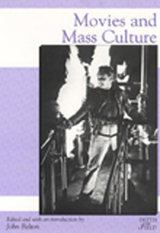 Movies & Mass Culture
Belton, John
Rutgers University Press, 1995 Movies and Mass Culture looks at the ways in which American identity shapes and is shaped by motion pictures. Movies serve not only as texts that document who we think we are or were, but they also reflect changes in our self-image, tracing the transformation from one kind of America to another. They assist audiences in negotiating major changes in identity, carrying them across difficult periods of cultural transition so that a more or less coherent national identity again emerges. Films thus help their viewers to span the gaps and fissures that cultural changes cause, allowing passage over any disjointedness that in some way might disrupt our sense of what we believe in as a nation. This volume examines this process, illustrating the ways in which films aided America's transition from an agrarian to an industrial economy; from a nation of producers to one of consumers; and from a community of individuals to a mass society.
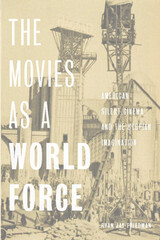 The Movies as a World Force: American Silent Cinema and the Utopian Imagination
Friedman, Ryan J
Rutgers University Press, 2019 Throughout the silent-feature era, American artists and intellectuals routinely described cinema as a force of global communion, a universal language promoting mutual understanding and harmonious coexistence amongst disparate groups of people. In the early 1920s, film-industry leaders began to espouse this utopian view, in order to claim for motion pictures an essentially uplifting social function. The Movies as a World Force examines the body of writing in which this understanding of cinema emerged and explores how it shaped particular silent films and their marketing campaigns. The utopian and universalist view of cinema, the book shows, represents a synthesis of New Age spirituality and the new liberalism. It provided a framework for the first official, written histories of American cinema and persisted as an advertising trope, even after the transition to sound made movies reliant on specific national languages.
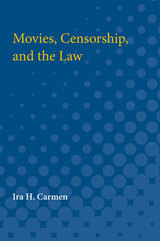 Movies, Censorship, and the Law
Ira H. Carmen
University of Michigan Press, 1966 Who decides what movies we should see? In some of the nation's largest cities motion pictures are screened by review boards meeting in secret. Their files are seldom open to inspection, and they often wield a nearly absolute power over what the public is shown.This is the story of motion-picture censorship in America. It begins in 1915 when the Supreme Court denied freedom of the press to movies. In a fast-moving account of court cases and behind-the-scenes skirmishes, Ira Carmen follows the history of movie censorship to the present day. He shows how very recent court decisions reflect new thinking on censorship and the nature of obscenity.Today, forty-seven states and countless cities and towns have obscenity laws on their statute books. Are the censors stout guardians of the public morality . . . or witch-hunters? In a series of dramatic interviews with film censors in major cities, Carmen captures the flavor of the struggle between censor and exhibitor. The interviews reveal how censors think—what kinds of films they suppress and for what reasons, how they feel about foreign films as opposed to American, how they are influenced by court decisions, and how well they abide by those decisions.This pioneering book reveals what effect court decisions really have at the grassroots level. It examines the role of the constitution in the censorship debate and asks how effective the American political and judicial systems have been in coping with the problem. Finally, it offers a challenging analysis of what kind of censorship, if any, is needed in a free society.
Movies Grow Up 1940-1980
Charles Champlin
Ohio University Press, 1980 Nearly 200 photos enhance Champlin’s readable, fascinating survey of the movies from the Golden Age up through the year 1980. According to Champlin, movies are the art form of our time — perhaps even the art form of this century. With this revised and enlarged edition of his book, one of the most comprehensive and eloquent works on film is available once again.
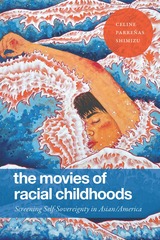 The Movies of Racial Childhoods: Screening Self-Sovereignty in Asian/America
Celine Parreñas Shimizu
Duke University Press, 2024 In The Movies of Racial Childhoods Celine Parreñas Shimizu examines early twenty-first-century cinematic representations of Asian and Asian American children. Drawing on psychoanalysis and her own perspective as a mother grieving for a deceased child, Shimizu considers how cinema renders Asian American children through sexualized racial difference, infantilization, and premature adultification. She looks at how Asian American childhood is characterized in film through experiences of alienation and trauma and contends that childhood development requires finding freedom and self-sovereignty through agentic attunement. In analyzing films that focus on queer Asian American youth such as Spa Night (2016) and Driveways (2019) and those that explore the trauma of being an immigrant like Yellow Rose (2019) and The Half of It (2020), Shimizu demonstrates that films can prompt viewers to evaluate their own childhood development. They also allow the opportunity to understand the demands placed upon Asian American children, particularly in regard to race and sexuality. In this way, cinema becomes a vehicle for empowering our inner child and the children all around us.
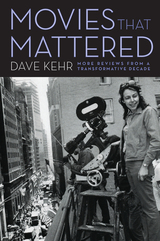 Movies That Mattered: More Reviews from a Transformative Decade
Dave Kehr
University of Chicago Press, 2017 Dave Kehr’s writing about film has garnered high praise from both readers and fellow critics. Among his admirers are some of his most influential contemporaries. Roger Ebert called Kehr “one of the most gifted film critics in America.” James Naremore thought he was “one of the best writers on film the country as a whole has ever produced.” But aside from remarkably detailed but brief capsule reviews and top-ten lists, you won’t find much of Kehr’s work on the Internet, and many of the longer and more nuanced essays for which he is best known have not yet been published in book form.
With When Movies Mattered, readers welcomed the first collection of Kehr’s criticism, written during his time at the Chicago Reader. Movies That Mattered is its sequel, with fifty more reviews and essays drawn from the archives of both the Chicago Reader and Chicago magazine from 1974 to 1986. As with When Movies Mattered, the majority of the reviews offer in-depth analyses of individual films that are among Kehr’s favorites, from a thoughtful discussion of the sobering Holocaust documentary Shoah to an irresistible celebration of the raucous comedy Used Cars. But fans of Kehr’s work will be just as taken by his dissections of critically acclaimed films he found disappointing, including The Shining, Apocalypse Now, and Raiders of the Lost Ark.
Whether you’re a long-time reader or just discovering Dave Kehr, the insights in Movies That Mattered will enhance your appreciation of the movies you already love—and may even make you think twice about one or two you hated.
 Movies under the Influence
Jocelyn Szczepaniak-Gillece
University of Minnesota Press, 2024 A cultural history of the enduring relationship between film spectatorship and intoxicating substances
Movies under the Influence charts the entangled histories of moviegoing and mind-altering substances from early cinema through the psychedelic 1970s. Jocelyn Szczepaniak-Gillece examines how the parallel trajectories of these two enduring aspects of American culture, linked by their ability to influence individual and collective consciousness, resulted in them being treated and regulated in similar ways. Rather than looking at representations of drug use within film, she regards cinema and intoxicants as kindred experiences of immersion that have been subject to corresponding forces of ideology and power. Exploring the effects of intoxicants such as caffeine, nicotine, alcohol, marijuana, and psychedelics on film spectatorship, Szczepaniak-Gillece demonstrates how American movie theaters sought to cultivate a dual identity, presenting themselves as both a place of wholesome entertainment and a shadowy zone of illicit behavior. Movies under the Influence highlights the various legislative, legal, and corporate powers that held sway over the darkened anonymity of theaters, locating the convergence of moviegoing and drug use as a site of mediation and social control in America. As much as substances and cinema are points where power intervenes, they are also settings of potential transcendence, and Movies under the Influence maintains this paradox as a necessary component of American film history. Recontextualizing a wide range of films, from Hollywood to the avant-garde, this book examines the implicit relationship intoxicants suggest between mass media, spectatorship, and governmental regulation and provides a new angle from which to understand cinema’s lasting role in evolving American culture.
 Moving Against the System: The 1968 Congress of Black Writers and the Shaping of Global Black Consciousness
Edited by David Austin
Pluto Press, 2018 In 1968, as protests shook France and war raged in Vietnam, the giants of black radical politics descended on Montreal to discuss the unique challenges and struggles facing their black comrades all over the world.
Against a backdrop of widespread racism in the West and ongoing colonialism and imperialism in the Global South, this group of activists, writers, and political figures gathered to discuss the history and struggles of people of African descent and the meaning of black power.
For the first time since 1968, David Austin brings alive the speeches and debates of the most important international gathering of black radicals of the era. With never-before-seen texts from Stokely Carmichael, Walter Rodney and C.L.R. James, these documents will prove invaluable to anyone interested in black radical thought and political activism of the 1960s.
|
|




